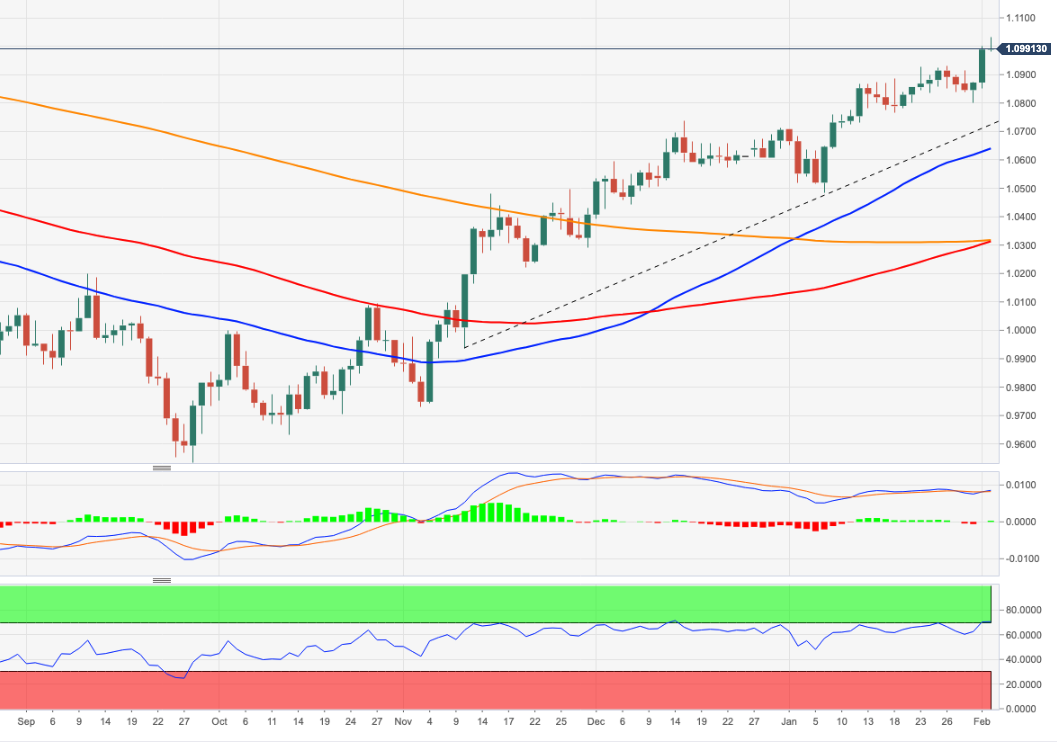- Analytics
- News and Tools
- Market News
CFD Markets News and Forecasts — 02-02-2023
The Commodity Futures Trading Commission's weekly commitments of traders' report will be delayed due to a ransomware attack on ION trading UK.
The CFTC is an independent agency of the US government created in 1974 that regulates the U.S. derivatives markets, which include futures, swaps, and certain kinds of options.
- USD/JPY bulls eye the daily resistance zone where the 61.8% ratio meets the structure near 129.60.
- Bears need to get below the critical 127.50s.
USD/JPY was forced lower on a bout of US Dollar strength on Thursday in an extension of the drop from the mid-point of the 130s. The price has been supported in the midpoint of the 127s and has left no bias on the carts from an immediate directional perspective until the 129.50s or the aforementioned 127.40s are broken. However, there are prospects of a meanwhile correction for the day ahead as traders get set for the US Nonfarm Payrolls data as the last puzzle of the puzzle for this week.
USD/JPY daily chart
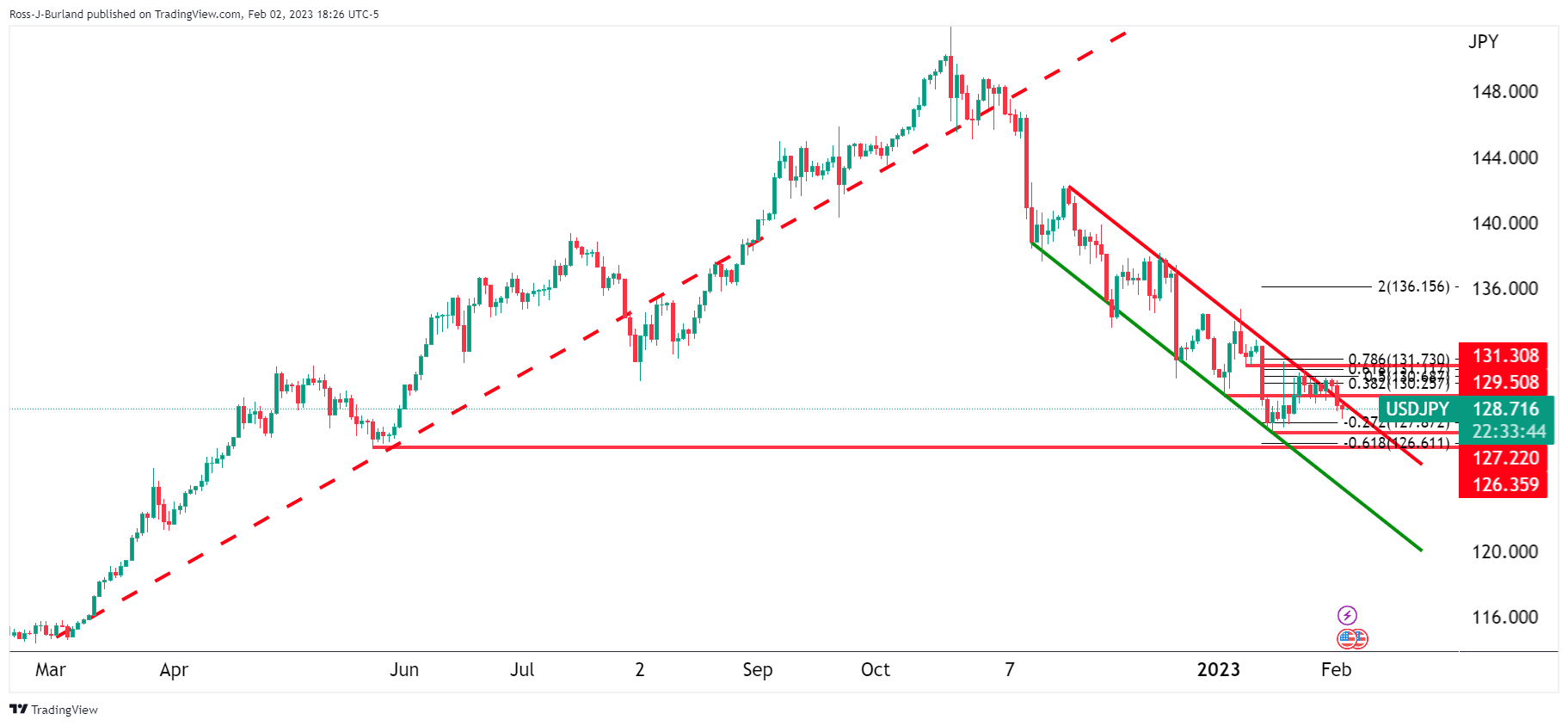
The price has met the 61.8% Fibonacci retracement at 127.588 of the move from between the November 2021 swing lows of 112.53 and the October swing highs of 151.95 highs range which is acting as a support which the bears need to break.
Zoomed in ...
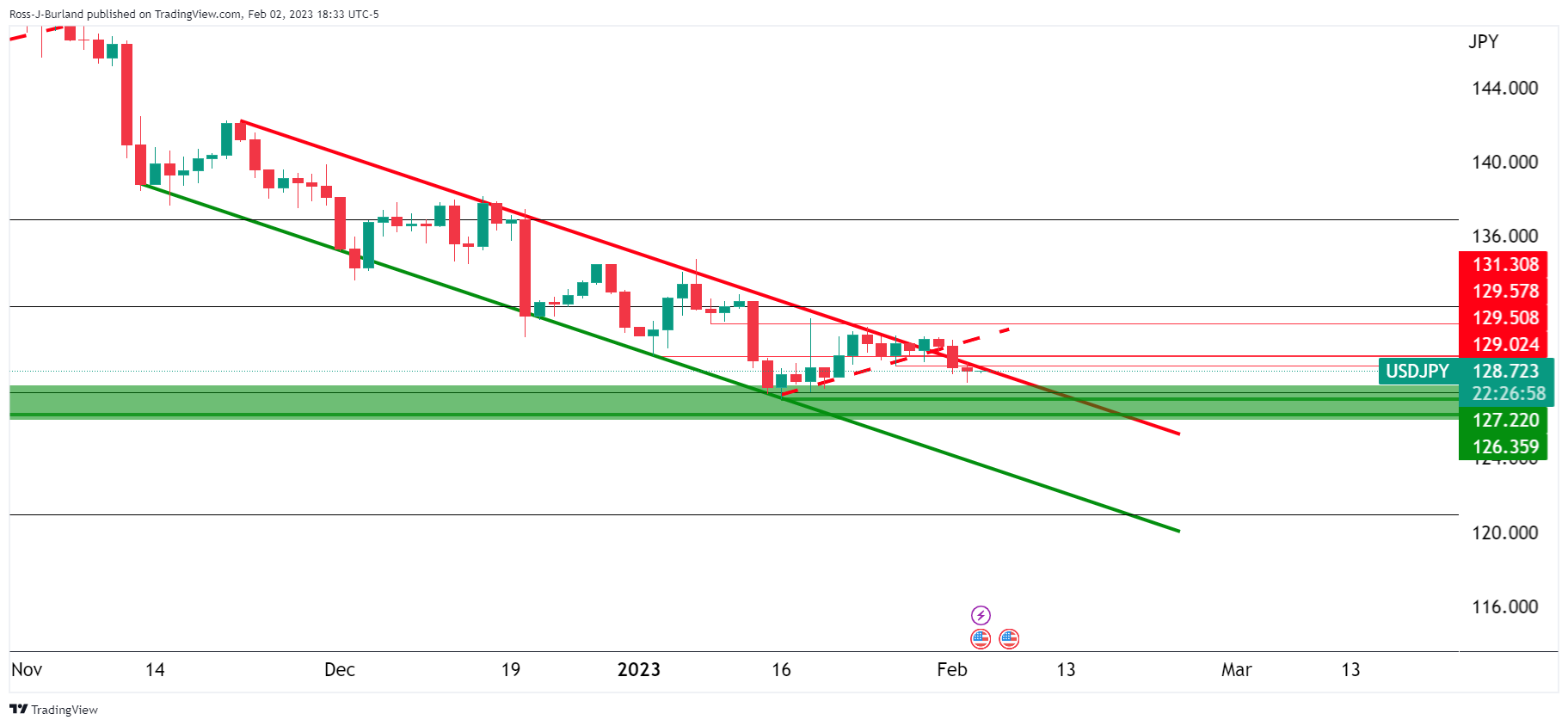
The price is drifting out of the deciding channel having hit support and this leaves prospects of a phase of consolidation outside of the channel that could lead to accumulation for a move higher.
Zoomed in ...
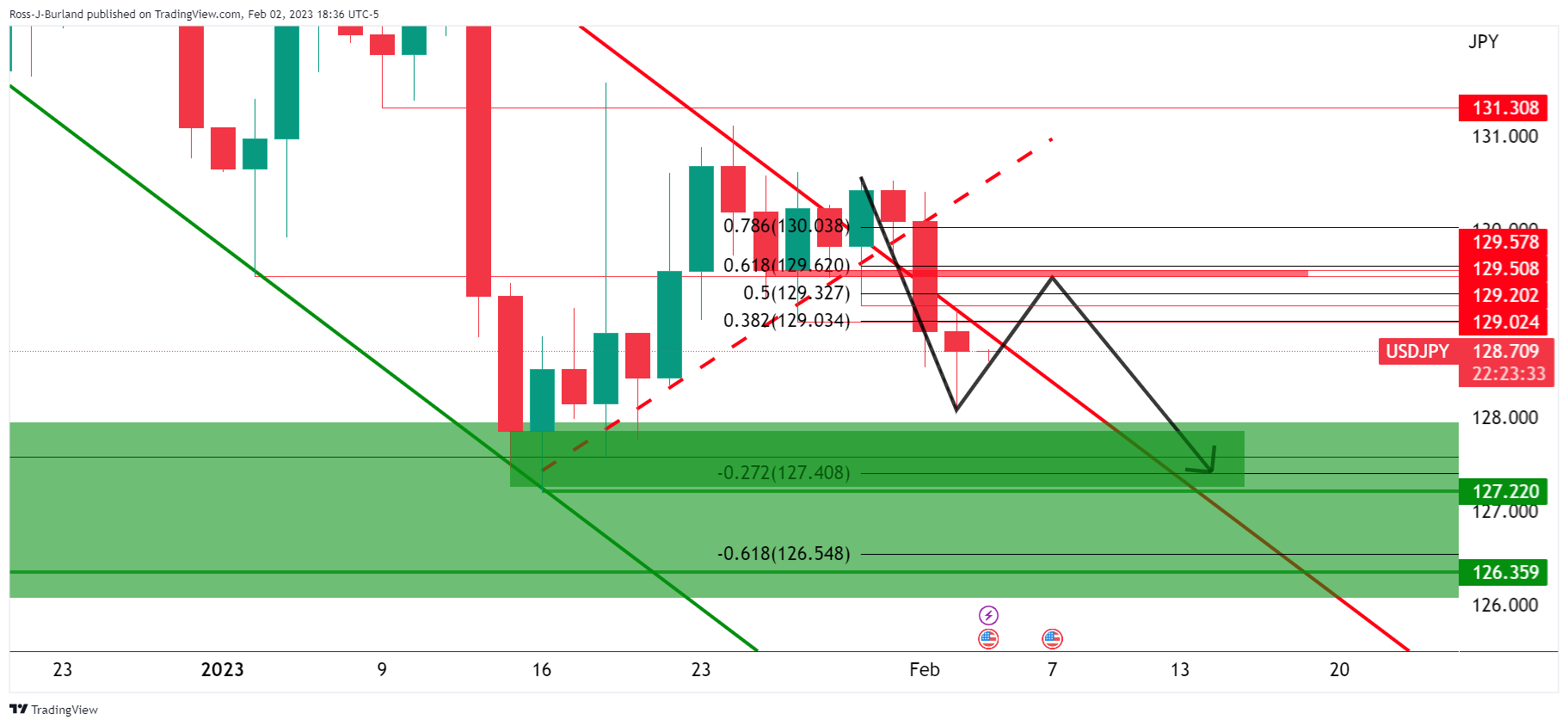
In the meantime, a correction could be in order towards prior support that would be expected to act as a resistance zone where the 61.8% ratio meets the structure near 129.60.
- AUD/JPY has not shown a meaningful reaction to the upbeat Australian PMI data.
- The RBA is expected to slowly push its OCR higher to 4.1% to tame soaring inflation.
- The reason behind widening BoJ’s YCC band was to make them more sustainable.
The AUD/JPY pair has shown a muted response to the upbeat Australian S&P Global PMI. The Services PMI has landed at 48.6 higher than the consensus and the prior release of 48.3. Also, the Composite PMI has scaled to 48.5 against the former release of 48.2. An absence of a contraction in economic activities despite rising interest rates by the Reserve Bank of Australia (RBA) could keep Australian inflationary pressures intact.
The Australian Dollar is expected to remain volatile on Friday ahead of the release of the Caixin Services PMI (Jan). The economic data is seen at 47.3 lower than the former release of 48.0. A decline in the Services PMI could impact the Australian Dollar as Australia is a leading trading partner of China.
Next week, the Australian Dollar will remain in the spotlight due to the interest rate decision announcement by the RBA. The Australian inflation rate has not shown a peak yet as it has shown a fresh high of 7.8% in the fourth quarter of CY2022. RBA Governor Philip Lowe might not have another option than to hike interest rates further.
Analyst at Deutsche Bank Australia sees the RBA likely to drive the Official Cash Rate (OCR) to 4.1%, citing the most recent inflation update of a 7.8% increase in the CPI, which was slightly higher than expected. “While the RBA will likely move more slowly in 2023 than it did in 2022, we now expect four more 25 basis point hikes this year: 25 basis points in each of February and March, and 25 basis points each at the May and August meetings” as reported by Forbes Advisor.
On the Japanese Yen front, investors are awaiting the release of the Jibun Bank Services PMI for fresh cues. The economic data is seen steady at 52.4. The street is still confused about the rationale behind widening the Yield Curve Control (YCC) by the Bank of Japan (BoJ) in its December monetary policy meeting. Meanwhile, BoJ Deputy Governor Masazumi Wakatabe is back on the wires this Thursday, noting that the “BoJ's Dec decision to widen band was a necessary step to make YCC more sustainable, but the move alone may have had the effect of weakening stimulus effect.”
- USD/CAD tumbled to fresh YTD lows at around 1.3262 but recovered and reclaimed 1.3300.
- USD/CAD Price Analysis: Upward biased above 1.3250.
The USD/CAD recovered some ground, trimmed some of its Wednesday’s losses on Thursday, and rose by 0.19% after hitting a new YTD low at 1.3262. As the Asian session begins, the USD/CAD exchanges hands at 1.3313, below its opening price at the time of writing.
USD/CAD Price Analysis: Technical outlook
Technically speaking, the USD/CAD is still upward biased, once achieved to stay above the 200-day Exponential Moving Average (EMA) at 1.3256. However, it should be said that once the USD/CAD tumbled below a three-month-old upslope support trendline, it failed to clear the latter, exposing the USD/CAD pair to some selling pressure.
If the USD/CAD tumbles back below 1.3300, bears next target would be the 200-day EMA. Once broken, the USD/CAD could extend its losses towards 1.3200.
As an alternate scenario, if the USD/CAD extends its recovery beyond the trendline mentioned above that passes around 1.3350, that would exacerbate a rally to 1.3400. If the bulls moved in, the USD/CAD following target would be the 100-day EMA at 1.3409, followed by the 50-day EMA at 1.3440, ahead of the January 19 swing high at 1.3520.

USD/CAD Key Technical Levels
- Gold price is eyeing more weakness to near $1,900.00 after an inventory distribution breakdown.
- Higher US labor cost data could shrug off Fed’s policy tightening pause rumors ahead.
- S&P500 has displayed a three-day winning streak despite further policy tightening by the Fed.
Gold price (XAU/USD) nosedived to near $1,912.00 after a blockbuster recovery move from the US Dollar Index (DXY) on Thursday. The precious metal is staring at the round-level resistance of $1,900.00 as further downside looks possible ahead of the United States Nonfarm Payrolls (NFP) data.
The downside pressure in the USD Index led by rising expectations that the Federal Reserve (Fed) might consider a pause in the policy tightening as the US inflation is softening significantly has been shrugged off. The US labor cost index is still solid and carries the ability to dismantle the Fed policy pause context.
In the US NFP gamut, Analysts at TD Securities expect a 220K increase in payroll and a modest increase in the Unemployment Rate to 3.6%. As per the consensus, Average Hourly Earnings data is seen at 4.9% vs. the prior release of 4.6% on an annual basis. While monthly data is seen steady at 0.3%. Led by exceeding labor demand against the supply, higher negotiation power in favor of job seekers could dent the price index declining trend, which can shrug off the rumors calling for a pause in the policy tightening pace by the Fed.
Meanwhile, risk-perceived assets like S&P500 have displayed a three-day winning streak despite further policy tightening by the Fed.
Gold technical analysis
Gold price has demonstrated a perpendicular sell-off after an Inventory Distribution chart formation on an hourly scale. The inventory distribution in a minor range of $1,950-1,960 indicates a shift of inventory from institutional investors to retail participants. The 20-and 200-period Exponential Moving Averages (EMAs) have delivered a bear cross at $1,927.80, which indicates more weakness ahead.
In addition to that, the Relative Strength Index (RSI) (14) has shifted into the bearish range of 20.00-40.00, which indicates that the downside momentum has been triggered.
Gold hourly chart
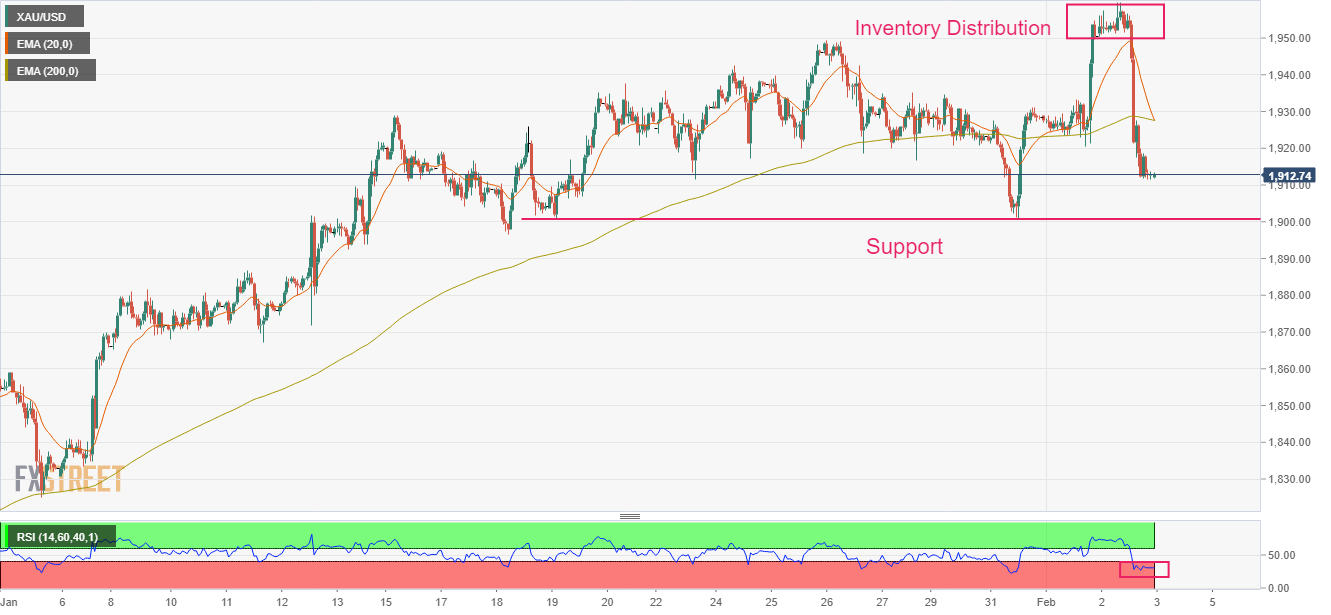
- The Aussie could not hold to its gains above 0.7100, outweighed by a strong US Dollar.
- US data showed the tightness of the labor market underpinned the greenback.
- Australia’s Services and Composite PMIs came more robust than the previous month’s data, though they remained in contractionary territory.
AUD/USD refreshed seven-month highs at around 0.7157 but collapsed as the US Dollar (USD) remained bid during Thursday’s session after market participants’ reaction to the US Federal Reserve (Fed) decision to lift rates weakened the greenback across the board. Nevertheless, the US Dollar stages a comeback, as shown by the AUD/USD exchanging hands at 0.7072 at the time of writing.
Upbeat US labor market data boosted the US Dollar
The AUD/USD dropped in the session, even though investors’ sentiment was upbeat. The US Federal Reserve decision hurt the US Dollar, as the Fed, led by Jerome Powell, stated that the US central bank has made progress curbing stubbornly high inflation amidst a tight labor market. Data revealed by the US Department of Labor (DoL) showed that Initial Jobless Claims for the last week ending on January 28 came at 183K below estimates of 200K, suggesting that companies had continued to hire personnel.
Therefore, the AUD/USD dwindled as traders brace for January’s US Nonfarm Payrolls report, with consensus at 185K, below the previous month’s reading of 223 K. Any readings above the consensus would keep the Fed on its tightening cycle. Still, Powell said that terminal rates are around the corner.
Regarding Australia, its economic calendar featured the Judo Bank Services and Composite PMI on its Final readings, at 48.6 and 48.5, respectively. Although the readings came higher than the previous month’s data, they remained in contractionary territory, portraying a gloomy scenario for the Australian Dollar (AUD).
What to watch?
The US economic calendar will feature employment data led by the Nonfarm Payrolls report, alongside the ISM Non-Manufacturing report, would update the US economy status.
AUD/USD Key Technical Levels
- GBP/USD is expected to continue its downside journey to near 1.2200 as focus shifts to US NFP data.
- To tame double-digit inflation, the BOE pushed interest rates by 50 bps to 4%.
- Investors will keep an eye on US Average Hourly Earnings data for further guidance.
The GBP/USD pair has shown a vertical sell-off to near 1.2225 and is expected to continue its downside journey to near the round-level support of 1.2200 ahead. The Cable witnessed a massive sell-off after investors shrugged off expectations that the Federal Reserve (Fed) will pause policy tightening ahead and poured funds into the US Dollar Index (DXY). Apart from that, investors dumped the Pound Sterling despite the Bank of England (BoE) continuing its hawkish stance on interest rates.
On Thursday, the USD Index recovered firmly after building a cushion around 100.50. The extremely oversold condition of the USD Index triggered buying interest among the market participants. The USD Index soared above 101.50 and has now turned sideways below 101.40 ahead of the United States Nonfarm Payrolls (NFP) data for further guidance.
To tame the double-digit inflation figure, BOE Governor Andrew Bailey announced an interest rate hike by 50 basis points (bps), which pushed borrowing rates to 4%. The BoE was an early adopter that started contracting its monetary policy after the pandemic period and has now announced its 10th consecutive interest rate hike. However, the inflation rate is still double-digit amid rising wage rates due to squeezed labor supply. Also, the softening energy prices are offset by the rising food price index, which was recorded at 16.8% for December.
There is no denying the fact that BoE policymakers have done much with interest rates to decelerate inflation, however, the United Kingdom economy is not responding, as expected, to extreme policy tightening.
On Friday, the release of the US NFP data will be of utmost importance. According to the consensus, the United States economy has added 185K jobs in the labor market in January vs. the former release of 223K in times when labor demand is exceeding supply. The Unemployment Rate is seen at 3.6% vs. 3.5% released earlier. The catalyst that will be critically monitored by investors for further action will be the Average Hourly Earnings data.
- EUR/USD is demonstrating a sideways auction ahead of the US NFP data.
- A 50 bps interest rate hike by the ECB has trimmed the Fed-ECB policy divergence.
- Eurozone core inflation has remained stubborn and demands more attention from ECB policymakers.
The EUR/USD pair is displaying a back-and-forth action around 1.0900 after a pullback move from 1.0885 in the early Asian session. The major currency pair has turned sideways ahead of the United States Nonfarm Payrolls (NFP) data, which will release on Friday. On Thursday, the Euro witnessed a massive sell-off after a sheer recovery move by the US Dollar Index (DXY) and the announcement of 50 basis points (bps) interest rate hike by the European Central Bank, which trimmed the Federal Reserve (Fed)-ECB policy divergence.
The USD Index is showing signs of volatility contraction after witnessing some volatile moves and has now shifted into a rangebound auction around 101.40. Meanwhile, S&P500 settled Thursday’s session on a bullish note, portraying that the risk-appetite theme is intact. The 500-US stock basket has already shown a three-day winning spell and is expected to continue its upside momentum further. The demand for US government bonds remained subdued, which led to a minor gain in the 10-year US Treasury yields above 3.40%.
On Thursday, ECB President Christine Larage pushed interest rates to 2.50% by announcing a 50 bps interest rate hike in line with the street estimates. No doubt, the Eurozone inflation has started softening after a sheer decline in energy prices and a recovery in supply chain disruptions. However, the ECB is required to restrict its monetary policy further as the inflation rate is extremely far from the desired rate of 2%.
Led by a deceleration in the energy price, the headline price index has come down for January month to 8.5% but the core inflation that strips oil and food prices has remained stubborn and is demanding exclusive attention from the ECB policymakers.
For further guidance, US NFP data will be keenly watched. The economic data is seen at 185K lower than the former release of 223K. Apart from that, the Unemployment Rate is expected to escalate to 3.6% vs. 3.5% in the prior release.
- NZD/USD bulls are being beaten back by a firmer US Dollar ahead of key data.
- The US NFP report will be the icing on the cake for a series of high-impact events form the last few days.
NZD/USD is on the way to a key support area with the US Dollar gathering pace in the North American session with eyes on 0.6450 having dropped from a high of 0.6537. The pair has reached a low of 0.6462 so far.
The Federal Reserve, Fed, yesterday concluded with a dovish tilt that sank the US Dollar to fresh bear cycle lows of 100.82 as per the DXY index that followed the Federal Reserve's chairman Jerome Powell's dovish comments. Markets jumped on he his statement that said he was seeing signs of disinflation. However, it was shortlived as the European Central Bank was not as hawkish as the bulls were hoping for, sinking the Euro and propelling the greenback into a forcible correction. The ECB raised key rates 50bp taking the MRO to 3.0%, and indicated it expects a repeat in March. Thereafter, any further hikes will be data-dependent the central bank said. Given the stretch positioning, however, the euro needed more from the event to stay up. ''EUR long positioning sits near the top of our tracking indicator, leaving it vulnerable to lofty market expectations,'' analysts at TD Securities said.
Looking ahead it will now be all about the Nonfarm Payrolls and as analysts at ANZ Bank explained, markets are clearly in no mood to embrace any hawkishness, ''and that could be a real limiting factor for the USD, they argued.'' Friday's Nonfarm Payrolls event will be a critical component of the US interest rate outlook and will drive sentiment in this regard.
Analysts at TD Securities are projecting payroll gains to have stayed largely unchanged vs December, posting a still solid 220k increase in January. ''Both the Unemployment Rate and average hourly earnings should have remained steady: the former at a decades-low 3.5%, and the latter printing a 0.3% MoM gain,'' the analysts explained. ''Note that the January jobs report will also include important revisions to the establishment survey data for 2022,'' they added.
Such an outcome could provide fuel to the US Dollar's correction from the bear cycle lows. Nonetheless, a weaker report, analysts at TD Securities warn, or an ''indication of softness will reinforce'' risk sentiment, which could be bullish for the Gold price and bearish for the US Dollar.
- GBP/JPY nosedives 200 pips or 1.30% on Thursday, courtesy of a BoE rate hike.
- GBP/JPY Price Analysis: Downward biased, but it could print a leg-up before the downtrend continues.
With the Bank of England (BoE) hiking rates by 50 basis points, the GBP/JPY surprisingly plummets across the board, more than 200 pips on Thursday. At the time of writing, the GBP/JPY exchanges hands at 157.39 after hitting a daily high of 159.60.
GBP/JPY Price Analysis: Technical outlook
The Pound Sterling (GBP) is losing traction against most G8 currencies. In the case of the GBP/JPY pair, price action dived sharply, towards new weekly lows, after smashing February’s 1 low of 158.90. That accelerated Sterling’s fall, extending below a one-month-old downslope trendline broken on January 20, that was acting as support and capped Wednesday’s drop.
On its way south, the GBP/JPY fell below the 158.00 figure, with bears eyeing to test the January 13 daily low at 155.64, followed by the YTD low at 155.35. But firstly, GBP/JPY bears would need to deal with the January 18 low of 157.27, ahead of the 157.00 figure, and followed by the January 17 low of 156.38.
On the other hand, the GBP/JPY reclaiming 158.00 could pave the way for a leg-up before resuming the downtrend. The GBP/JPY key resistance levels would be a downslope trendline at around 158.20-30, followed by the February 1 daily low of 158.90.
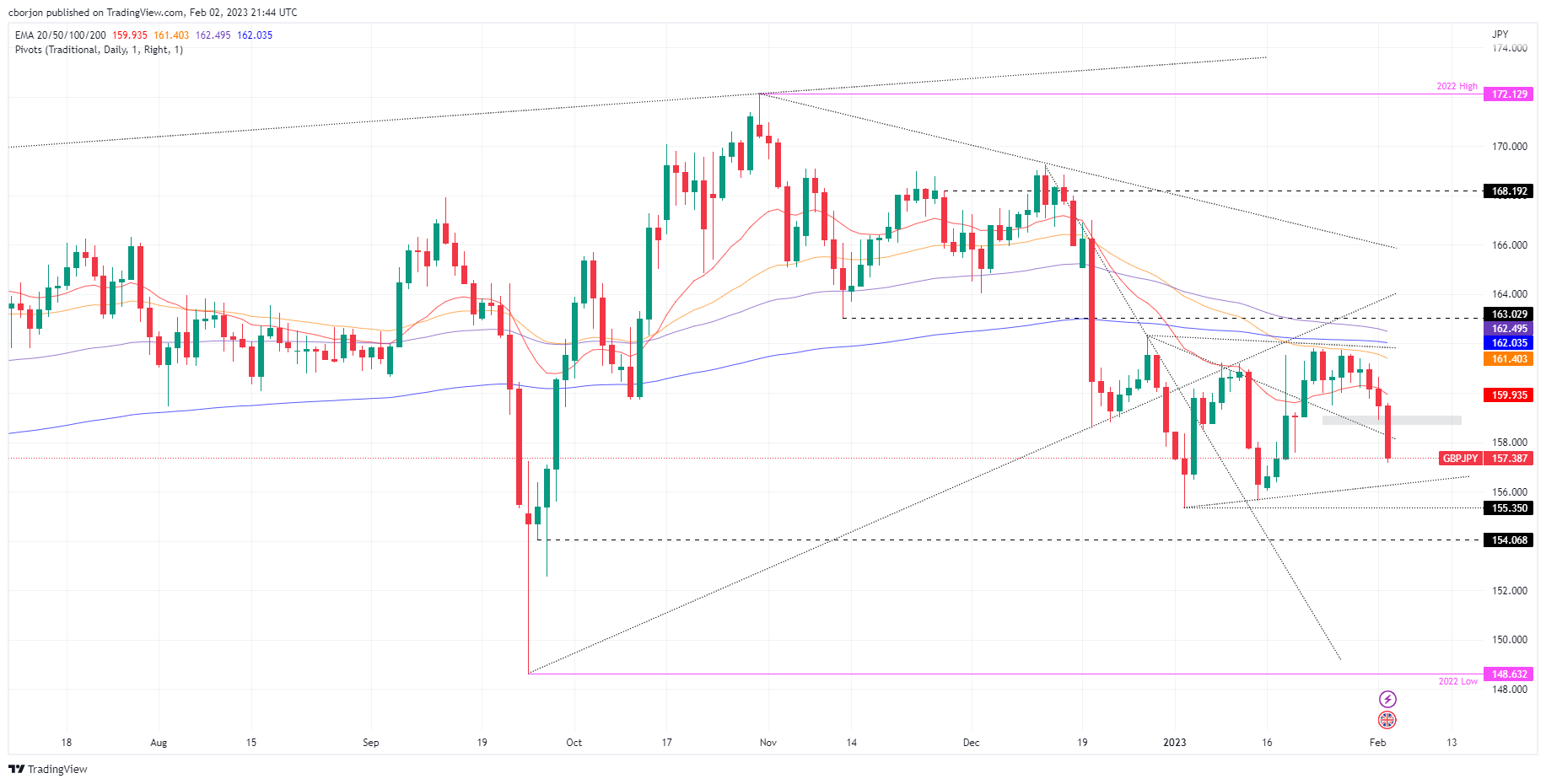
GBP/JPY Key Technical Levels
- Gold price dropped despite the Federal Reserve and European Central Bank combination.
- US Dollar is attempting to correct from multi-week lows.
- United States of America Nonfarm Payrolls could be a major event for the Gold price and US Dollar.
Gold price is tinkering on the edge of a significant blow-off to the downside in the coming days. At the time of writing, XAU/USD is trading down 1.85% and has done most of the leg work for a move much lower. In prior analysis, a downside case has been advocated given the length of the bull rally and the recent breakdown of the Gold price bullish structure is compelling.
The Gold price has dropped from a bull cycle high made on the same day of $1,959.77 and has marked a low of $1,911.87, so far. However, critically, the Gold price has broken $1,918 and should there be a close below here on a daily basis, the bears will have made an impressionable mark on the charts for the week ahead. See below for the technical analysis of the Gold price. M
eanwhile, it has been a game of two halves so far this week with a series of fundamentals playing into both the US dollar and the Gold price. We are now moving into extra time with the Nonfarm Payrolls that will possibly be the deciding factor for both assets.
Federal Reserve and European Central Bank did little to support Gold price
Firstly, the Federal Reserve, Fed, event concluded with a dovish tilt that sank the US Dollar to fresh bear cycle lows of 100.82 as per the DXY index that followed the Federal Reserve's chairman Jerome Powell's dovish rhetoric when he said he is seeing signs of disinflation. Consequently, US Treasury Bond yields were sharply lower, bullish for gold as it offers no interest. The yield on the US 10-year Treasury note dropped to a low of 3.334%.
- Federal Reserve: The rate peak is in sight – Commerzbank
The Federal Reserve raised its key interest rate corridor by 25 basis points to 4.50%-4.75%, as expected. In the view of economists at Commerzbank, the Federal Reserve is unlikely to do much more before it reaches its rate peak and that sentiment was weighing on the US Dollar.
Then, however, the European Central Bank, ECB, came in with a less hawkish than proffered rhetoric that the Euro bulls would have hoped for which sank the Euro, supporting the US Dollar, and propelling the Gold price lower for the day after previously touching a 10-month high.
All in all, Gold price markets are coming around to the fact that while the United States of America's inflation pace may be trending down, the Federal Reserve will have a much harder time getting it down to its desired 2% target considering the labour market shortages, which segues us into the Nonfarm Payrolls on Friday.
Nonfarm Payrolls, expectations for Gold price
The US labour market and Nonfarm Payrolls event is a critical component of the US interest rate outlook. Analysts at TD Securities are projecting payroll gains to have stayed largely unchanged vs December, posting a still solid 220k increase in January. ''Both the Unemployment Rate and average hourly earnings should have remained steady: the former at a decades-low 3.5%, and the latter printing a 0.3% MoM gain,'' the analysts explained. ''Note that the January jobs report will also include important revisions to the establishment survey data for 2022,'' they added.
Such an outcome could provide fuel to the US Dollar's correction from the bear cycle lows and would therefore be expected to weigh on the Gold price. However, a weaker report, analysts at TD Securities warn, or an ''indication of softness will reinforce'' risk sentiment, which could be bullish for the Gold price and bearish for the US Dollar.
Gold technical analysis

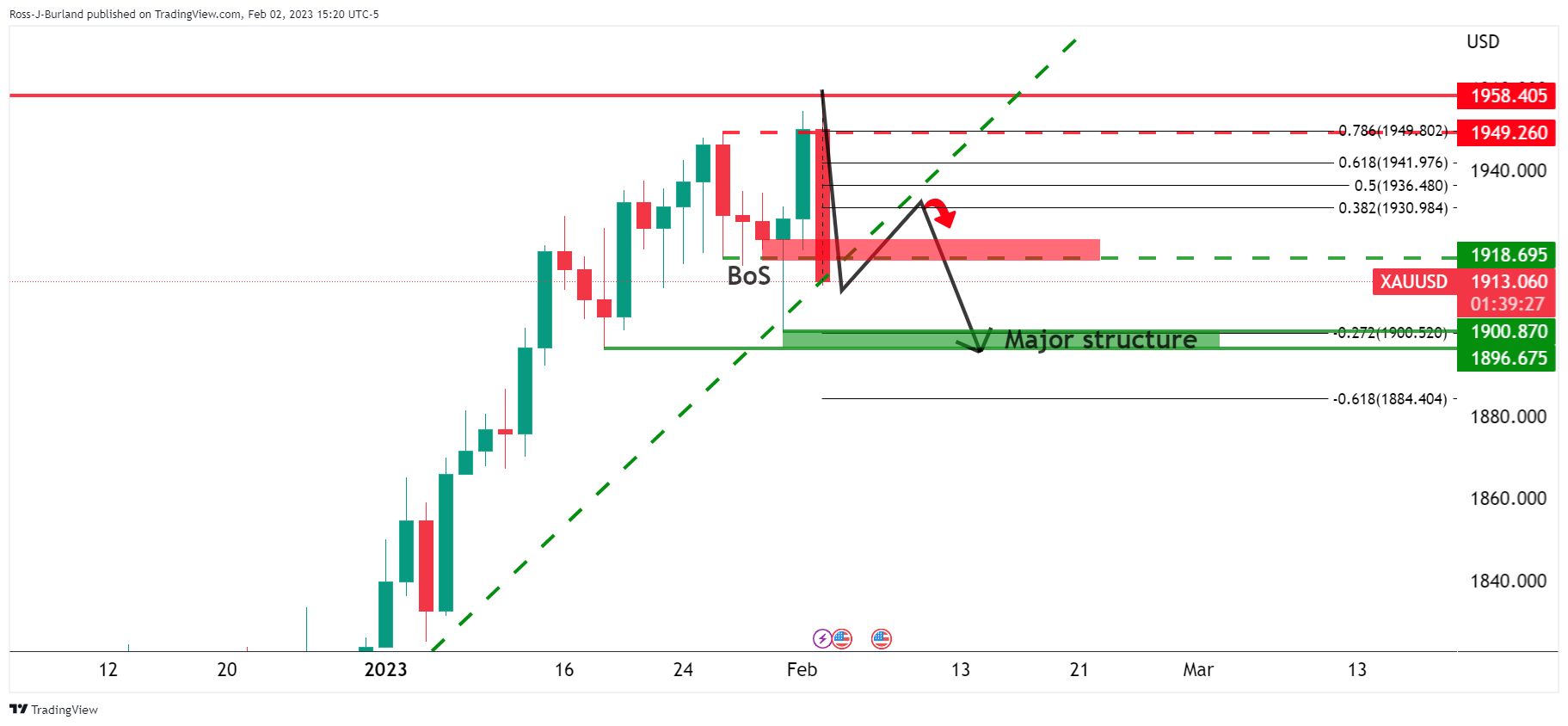
The Gold price is breaking down structure, (BoS) on the daily chart and a correction of the daily bearish impulse could result in further selling pressure from the bears. However, a commitment from the Gold price bulls to above $1,920/30 4-hour resistances could leave the bulls in play for the foreseeable future:
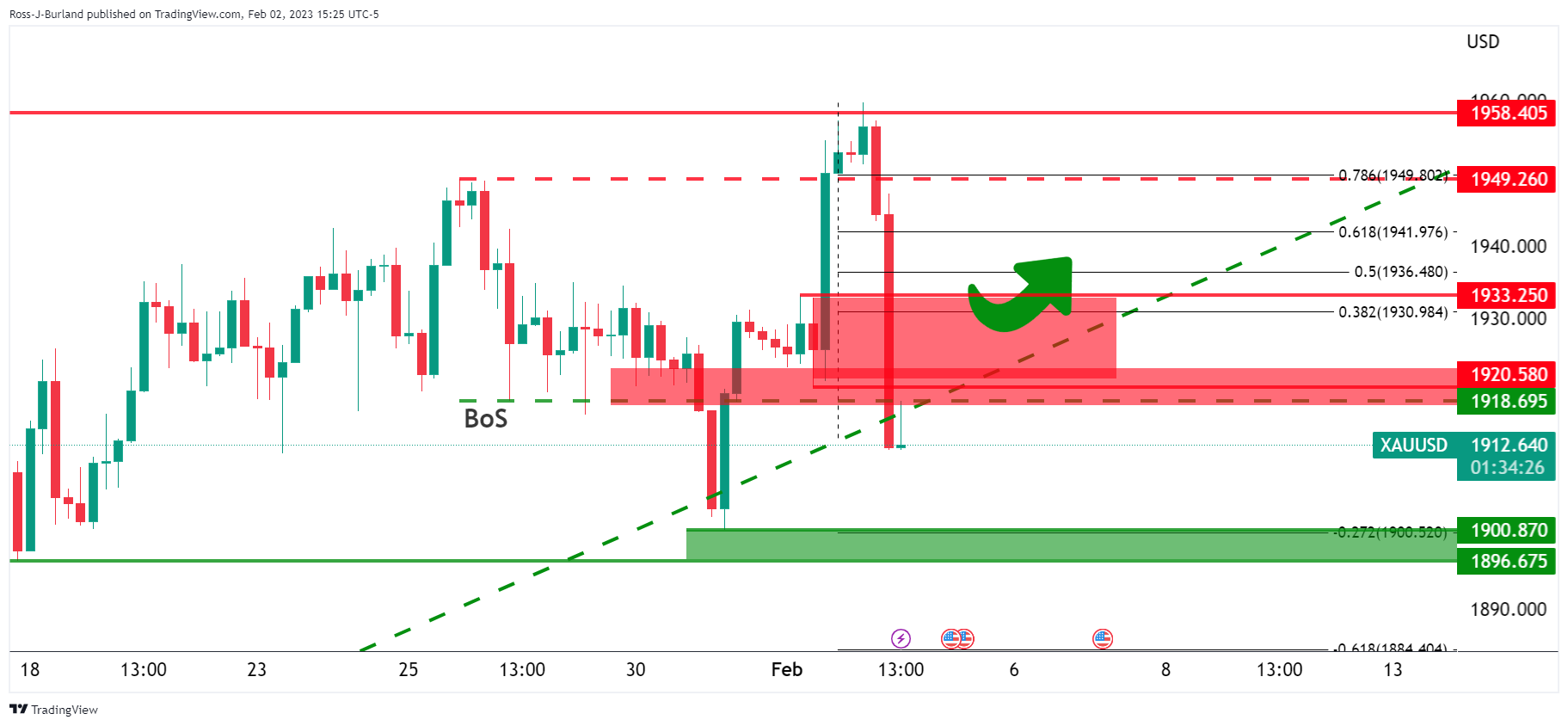
All will be revealed for the Gold price over the United States of America Nonfarm Payrolls event on Friday one way or another.
What you need to take care of on Friday, February 3:
The US Dollar recovered most of the ground lost post-Fed’s decision amid ECB and BOE monetary policy announcements. The American currency edged higher against most major rivals, with the JPY being its strongest rival and the GBP the weakest.
Earlier in the day, Bank of Japan Deputy Governor Mazasumi Wakatabe said there has been no change to the central bank’s determination to continue with its current monetary policy. USD/JPY finished the day at around 128.60 after extending its weekly decline to 128.07.
The Bank of England came first, and as widely anticipated, Bailey & co. hiked rates by 0.5 percentage points to 4%. Governor Bailey was quite optimistic, as he said that a potential recession will likely be less deep than previously expected. He also said that they would need to watch the path of inflation very closely. GBP/USD ended up falling to a multi-week low of 1.2330.
The European Central Bank also hiked by 50 bps and even confirmed another 50 bps for March. However, President Lagarde said that the following decisions will be a meeting-by-meeting matter and that it will be data-dependant. EUR/USD trades just above the 1.0900 threshold, as investors believe terminal rates are around the corner.
Stock markets advanced, partially limiting US Dollar gains. US Treasury yields eased from their post-Fed peaks and ended the day down.
Spot gold plunged from the $1,950 price zone and finished the day at around $1,913 a troy ounce. Crude oil prices lost some ground, but losses were moderated by the better tone of US indexes. WTI is currently changing hands at $75.80 a barrel.
The week will end with the release of the US Nonfarm Payrolls report on Friday.
Like this article? Help us with some feedback by answering this survey:
- The rate hike by the US Federal Reserve tumbled the USD/CAD to new YTD lows.
- Falling oil prices and solid US labor market data underpinned the USD/CAD.
- USD/CAD traders are eyeing Friday’s US Nonfarm Payrolls data alongside ISM Non-Manufacturing PMIs.
USD/CAD is recovering some ground after posting minimal losses Wednesday, which sent the pair into a tailspin to test the 200-day Exponential Moving Average (EMA) at 1.3255 after the US Federal Reserve decided to raise rates. At the time of writing, the USD/CAD is trading at 1.3312 after hitting a new YTD low of 1.3262.
Fed’s dovish perceived hike undermined the US Dollar
On Wednesday, the Fed lifted rates to the 4.50%-4.75% range as expected, and Fed’s Chair Jerome Powell took the stand. He said that ongoing increases to the Federal Funds rate (FFR) would be appropriate and emphasized the US central bank’s commitment to tame inflation to the 2% target. Even though he said that a couple of increases are likely in March and May, his acknowledgment that the disinflationary process had begun was perceived by market participants as a dovish signal.
In the meantime, Thursday’s US economic calendar revealed the unemployment claims for the last week that ended on January 28, with Initial Jobless Claims falling to 183K from 186K a week earlier and less than the 200K projected by polls. Labor market data added to Wednesday;’s JOLTs report, which showed that vacancies rose, signaling that the labor market remains tight.
In the meantime, the US Dollar Index (DXY) advances 0.45%, up at 101.62, a tailwind for the USD/CAD pair. The greenback’s recovery is due to the Euro and British Pound continuing to extend their losses vs. the buck, notably the Sterling, down by 1%.
On the Canadian front, the Loonie (CAD) remained soft on Thursday, influenced by factors like falling US crude oil prices, with WTI’s down 0.27%, at $76.46 per barrel. Another reason that weighed on the Canadian Dollar (CAD) was building permits, which shrank -7.3% in December, above the previous month’s plunge of -14.9% but above estimates of a -5% contraction, as reported by Statistics Canada.
What to watch?
On Friday, an absent Canadian economic docket would leave USD/CAD traders leaning on the dynamics of the United States (US). On the US front, employment data led by the Nonfarm Payrolls report, alongside the ISM Non-Manufacturing report, would update the US economy status.
USD/CAD Key Technical Levels
- EUR/JPY is offered in the aftermath of the ECB on Thursday.
- The euro is pressured by a lack of certainty with regard to the future path of rate hikes from the ECB.
The euro fell vs. the US Dollar on Thursday after the European Central Bank (ECB) hiked interest rates by a widely expected 50 basis points but failed to give the bulls any more ammunition nor incentive to hold on to the euro as it offered no new hawkish surprises. Expectations are that ECB rates will also be biased lower in Q4 which has also weighed on the euro. At the time of writing, EUR/JPY is trading at 140.33 and down 0.9% on the day after falling from a high of 141.93 to a low of 140.08 so far.
However, in the meantime, there are prospects of more to come from the ECB which should support the euro for the foreseeable future. Analysts at Rabobank explained that the meeting has pretty much confirmed a third 50bp hike in March. ''We expect a 50bp hike in March, followed by two 25bp hikes in Q2 to a terminal rate of 3.50%,'' but at the same time noted that ''markets ran away with the few dovish parts of the announcement.''
Looking further out, analysts at Danske Bank argued that the ECB governor Christine Lagarde's communication during the press conference was reflecting a very split governing council,'' where she also said that any decision is the fruit of compromise.''
''In the end'' the analysts said further, ''the ECB's intention to hike 50bp at the March meeting is not a 100% commitment.''
''Unsurprisingly, the ECB confirmed the data-dependent and meeting-by-meeting decision approach. This means that with markets trading on a narrative other than that which the ECB wants to convey on a more holistic plan (e.g. one of underlying inflation lingering, despite lower headline), we saw significantly lower yields to today's meeting.''
Swiss National Bank Chairman Thomas Jordan is crossing the wires and has stated the following:
Key comments
- Price stability does not happen automatically.
- We are seeing no wage-price spiral in Switzerland.
- Inflationary pressure stronger than SNB can tolerate, can't exclude more interest-rate increases.
- A strong swiss job market could affect a firm's cost inflation.
- In 2022 second-round effects rose, and inflation spread.
- Ready to be active in currency markets when necessary.
USD/CHF technical analysis
On the following daily chart,m we can see that the price is moving lower with a descending channel:
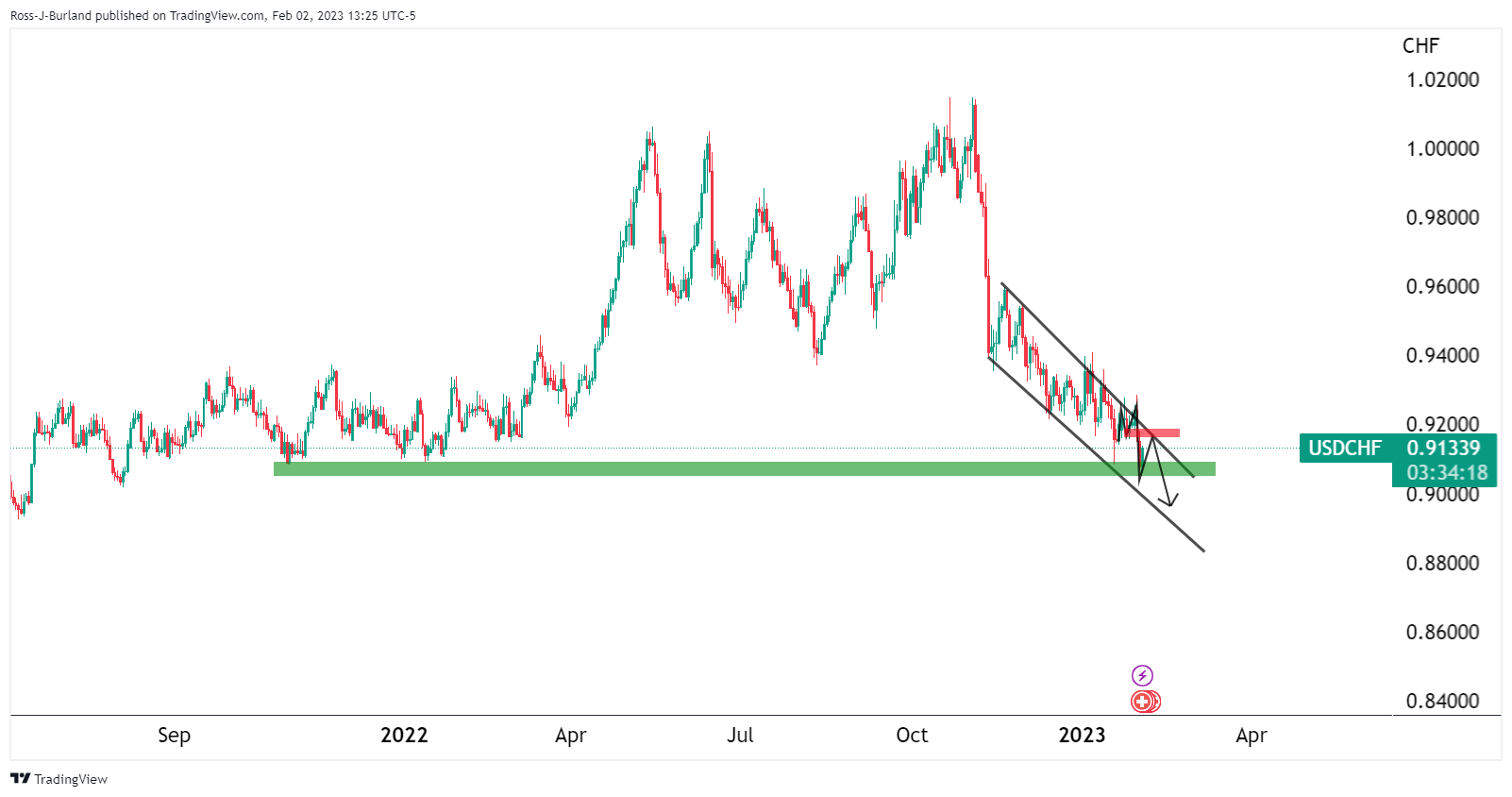
Zoomed in ...
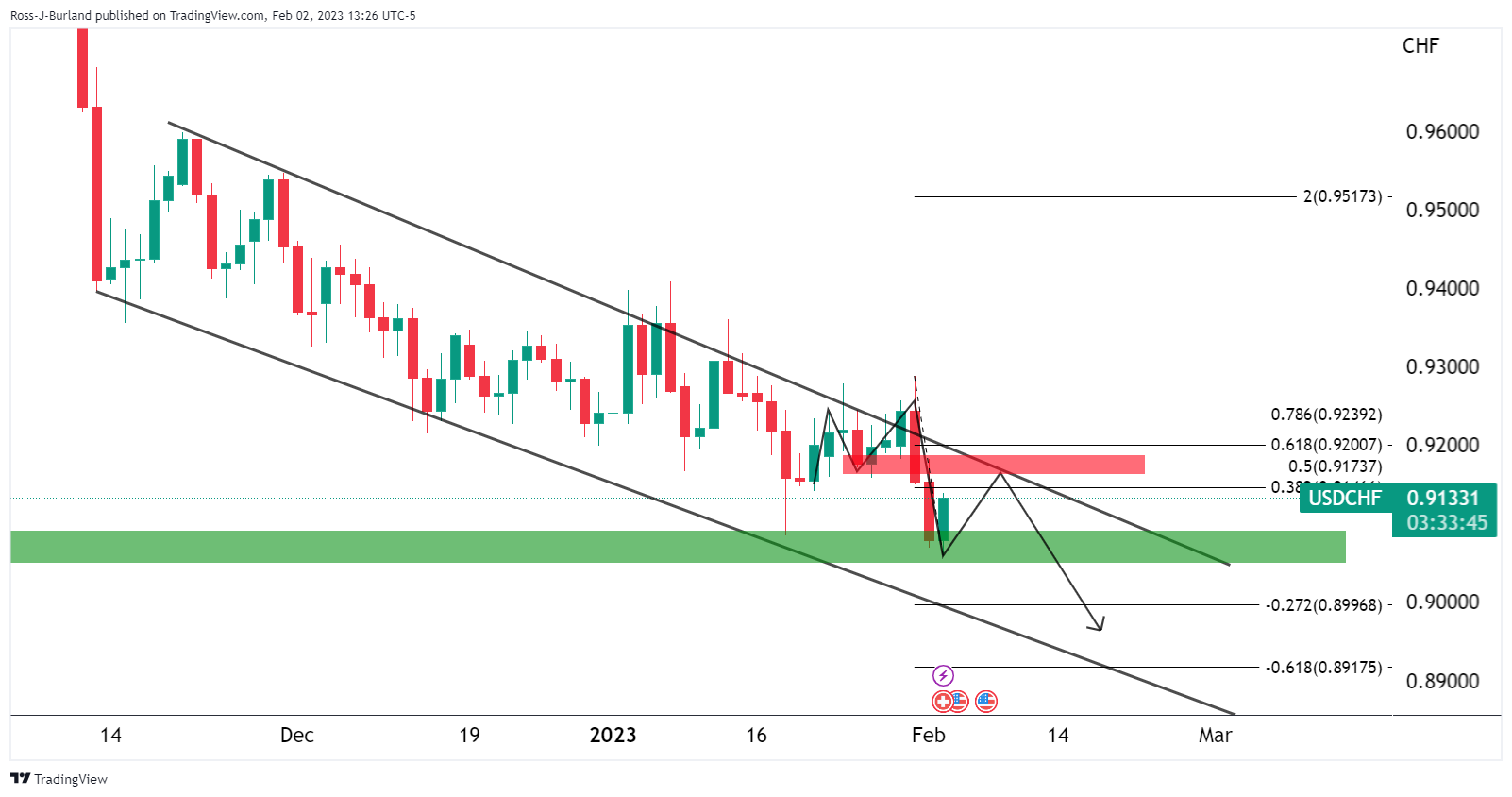
The M-formation is pulling the bulls in from support with a focus on the 50% mean reversion target as the top of the channel resistance and neckline of the pattern near 0.9170.
- Silver slumps after reaching a new YTD high at $24.62 and is back below $23.50.
- Gold Price Forecast: XAU/USD erases Wednesday’s gains, plunges below $1,920 post BoE, ECB decisions.
- Silver Price Analysis: Trapped within the $23.00-$24.50 range.
After hitting a new nine-month high of $24.62, Silver price nosedives, failing to break the $23.00-$24.50 range for the fourth consecutive day in the week, and exchanges hands at around $23.40s at the time of writing.
Wall Street continues to record gains bolstered by a big tech company projecting a positive outlook for 2023. The Federal Reserve rate hike of 25 bps weighed on the greenback during Wednesday and Thursday’s overnight session. However, the greenback is staging a comeback, albeit US Treasury yields fall. That has been a tailwind for the white metal, extending its losses toward the bottom of the range.
Silver Price Analysis: XAG/USD Technical Outlook
The XAG/USD is still range-bound, dropped below the 20-day Exponential Moving Average (EMA) at $23.69, which would act as a resistance level in the event of Silver attempting to rally back to $24.00. XAG/USD’s failure to decisively break the previous YTD high at $24.54 could pave the way for a re-test of $23.00, a psychological level. Once cleared, that will put in play the January 23 swing low of $22.76, followed by the December 16 daily low at $22.56.
As an alternate scenario, Silver’s reclaiming $24.00 would open the door for further upside and continuation after one month of consolidation, within the $23.00-$24.50 range. After XAG/USD climbs above the top of the range, the next ceiling would be the YTD high at $24.62, followed by the $25.00 figure.
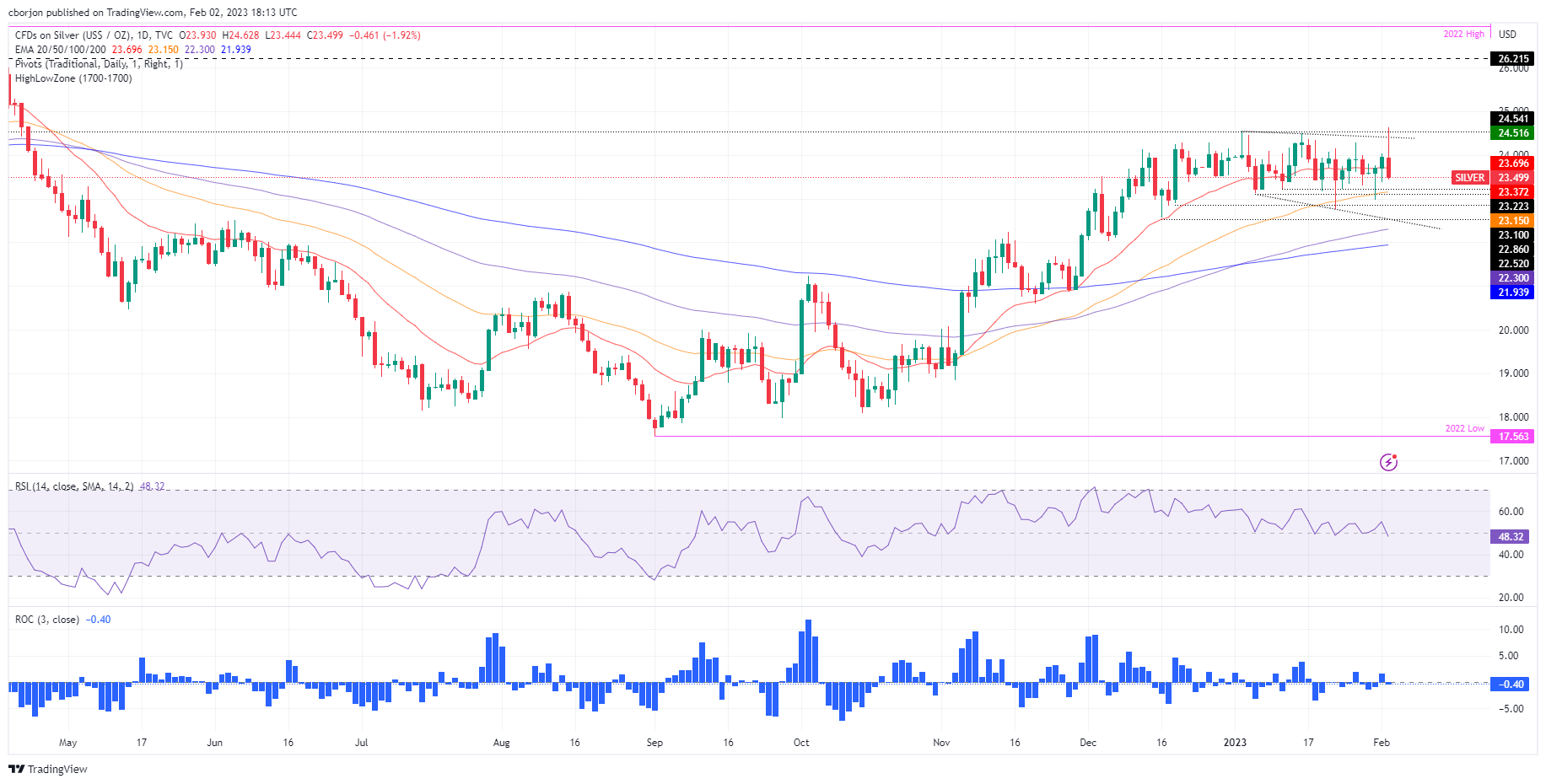
Silver Key Technical Levels
- WTI dropped to the %75s and now the daily chart shows the price breaking the trendline support.
- WTI, however, is now correcting higher to $76.70 resistance.
- The $77.70s are eyed as a 61.8% ratio target.
As per the prior analysis of the week, targetting the $75s target area, the objective was reached in the New york equities cash opening window with heightened volatility. The focus is now on the upside as the bulls move in for the kill to sweep the buy liquidity with a focus on the Asian highs that guard the price imbalances above. Targets are placed around $77.50 (50% mean reversion area), $77.70 (Mondayinitial balance lows) and a 61.8% Fibonacci retracement of the latest bearish impulse around $78.80 as the following analysis illustrates.
WTI, prior analysis
WTI bears taking control into the Fed, eyes on $75.00bbl
WTI Price Analysis: Bears break key hourly structure, eye $75.00bbls
It was suggested that ''a correction into resistance could entice trapped longs to get out of losing or breakeven positions and subsequently the shorts coming onto the market around 38.2% Fibonacci correction could see a move out of the consolidation below the trapped volume and into a 100% measured target towards $75.00 over the course of the coming week.''
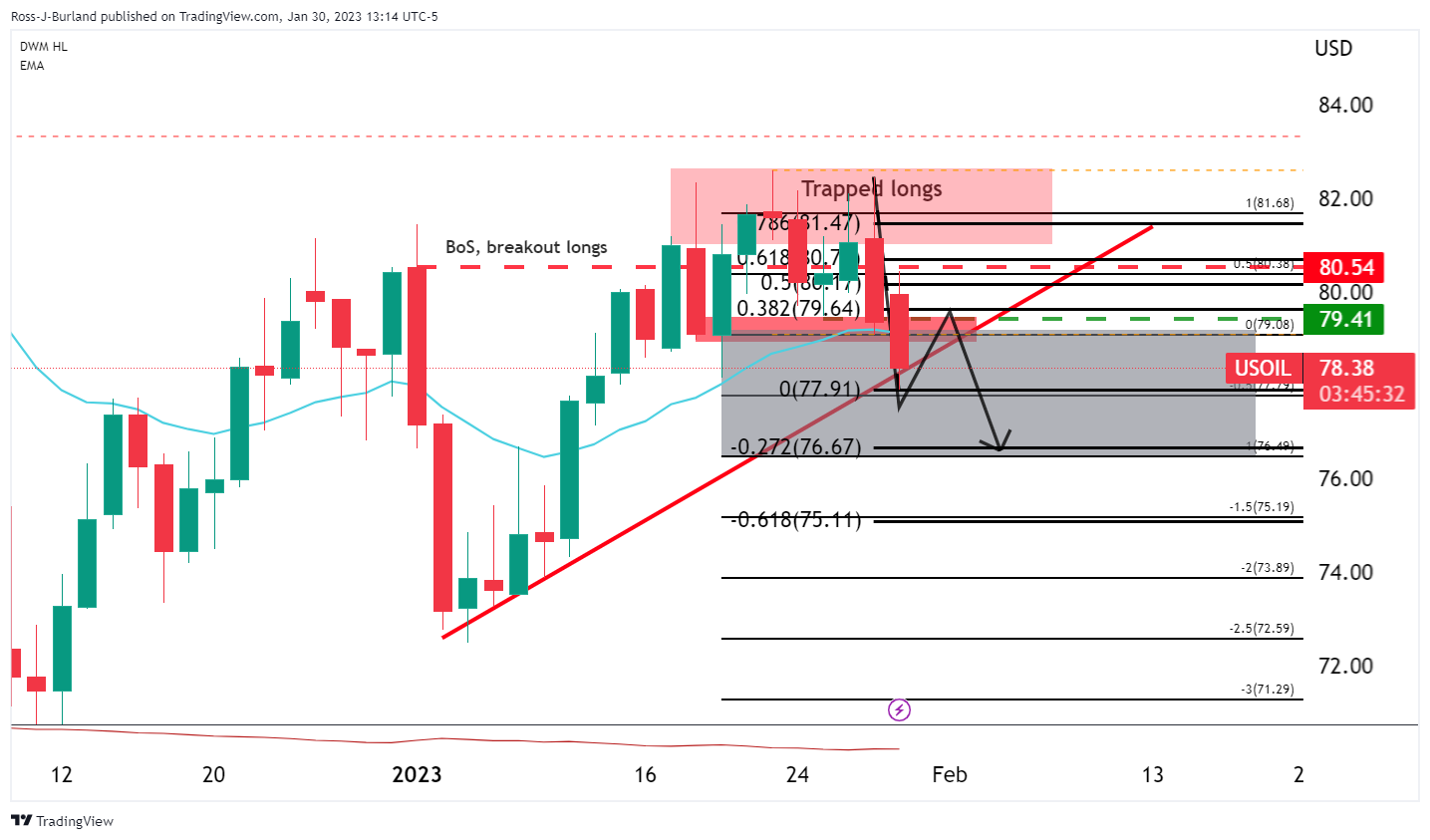
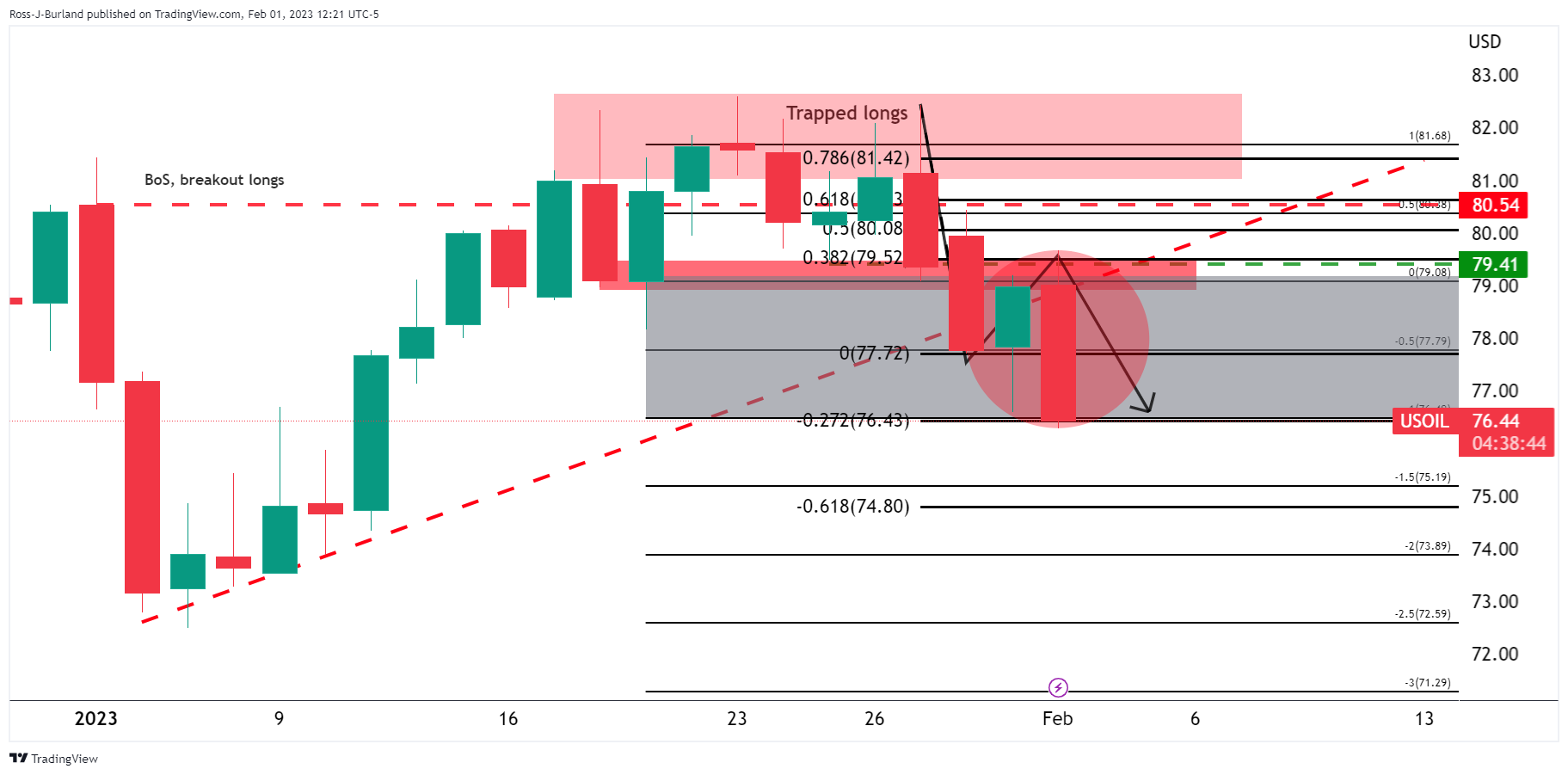
As illustrated, the price sank into the target area following a correction into where shorts were looking to get in at a premium. The subsequent move had fulfilled the 100% measured move and $75.00 was beckoning:
WTI H1 charts, prior analysis
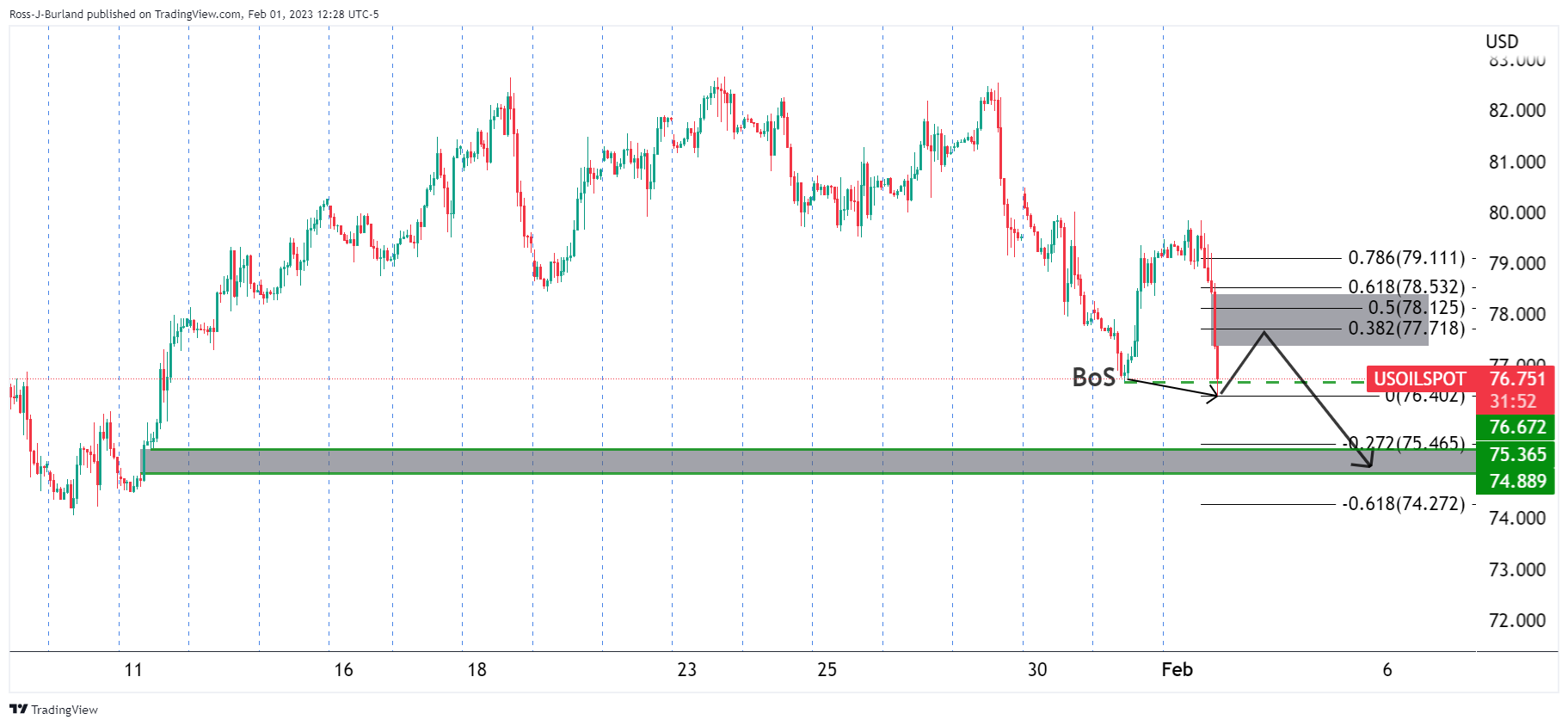
Zoomed in ...
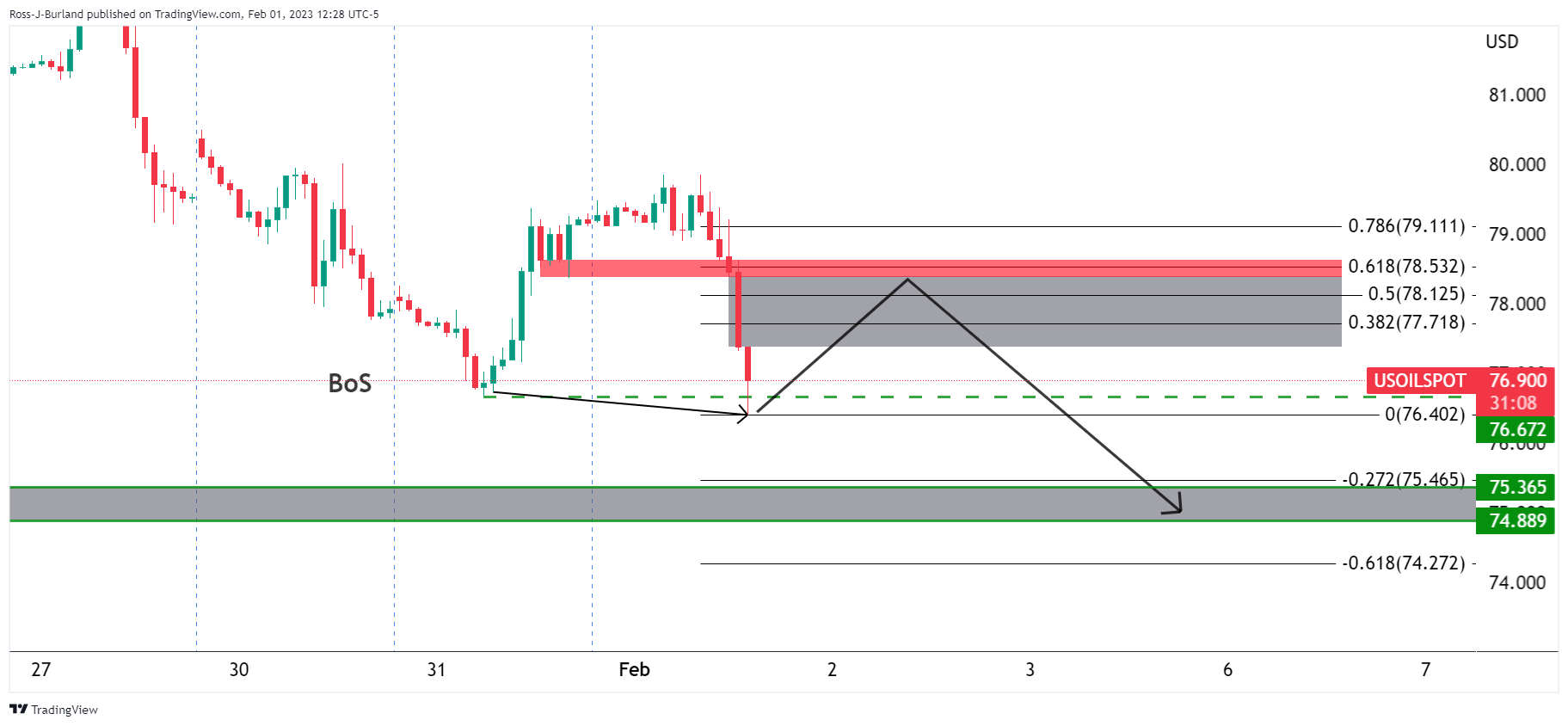
The greyed areas were price imbalances while the red marking was a resistance zone that had a confluence with the 61.8% Fibonacci retracement level near $78.50. While below there, the bias was to the downside.
However, a more shallow correction may be all that was needed. Either way, bears were looking to target between $75.36 and $74.88 on a break of $75.50.
WTI Update
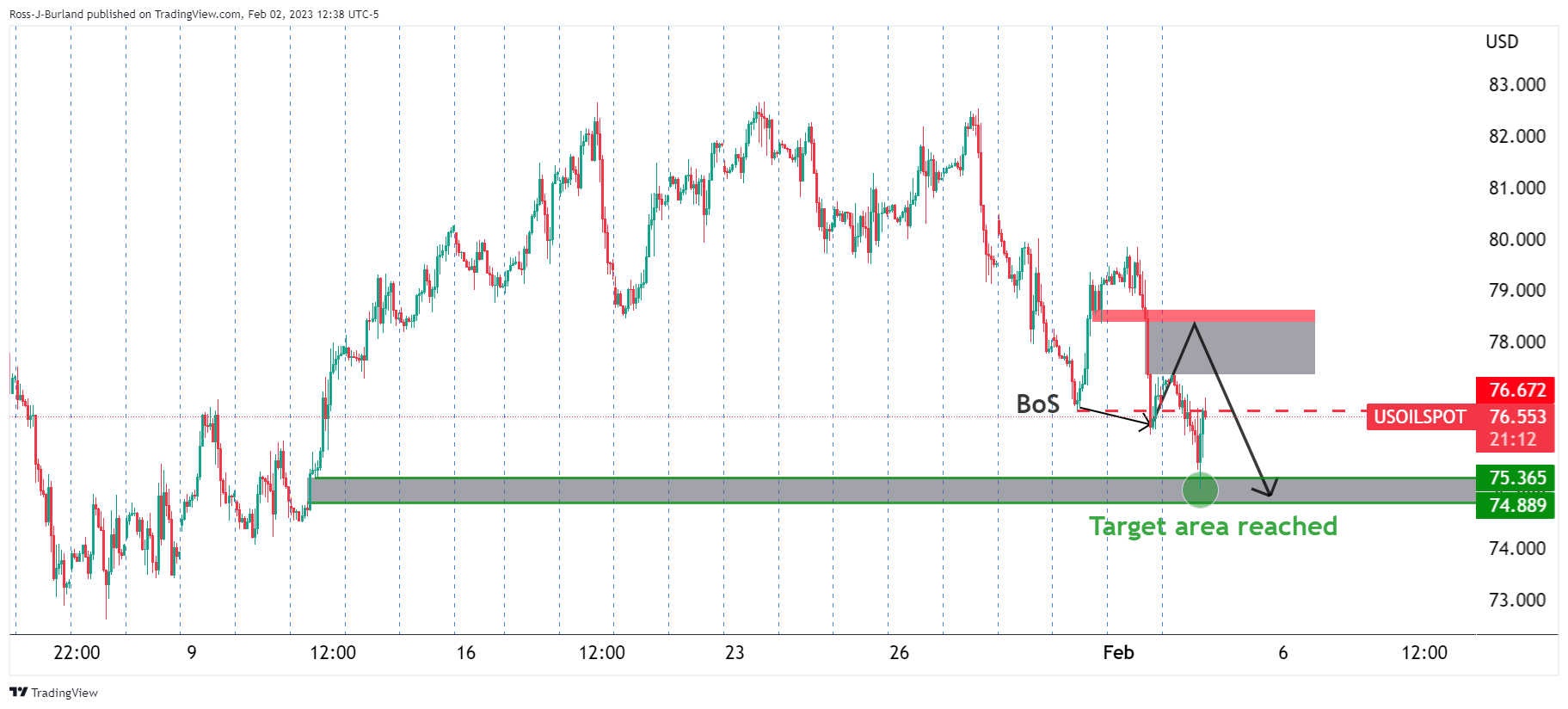

The price has reached the resistance and a correction is underway.
WTI daily and M15 charts
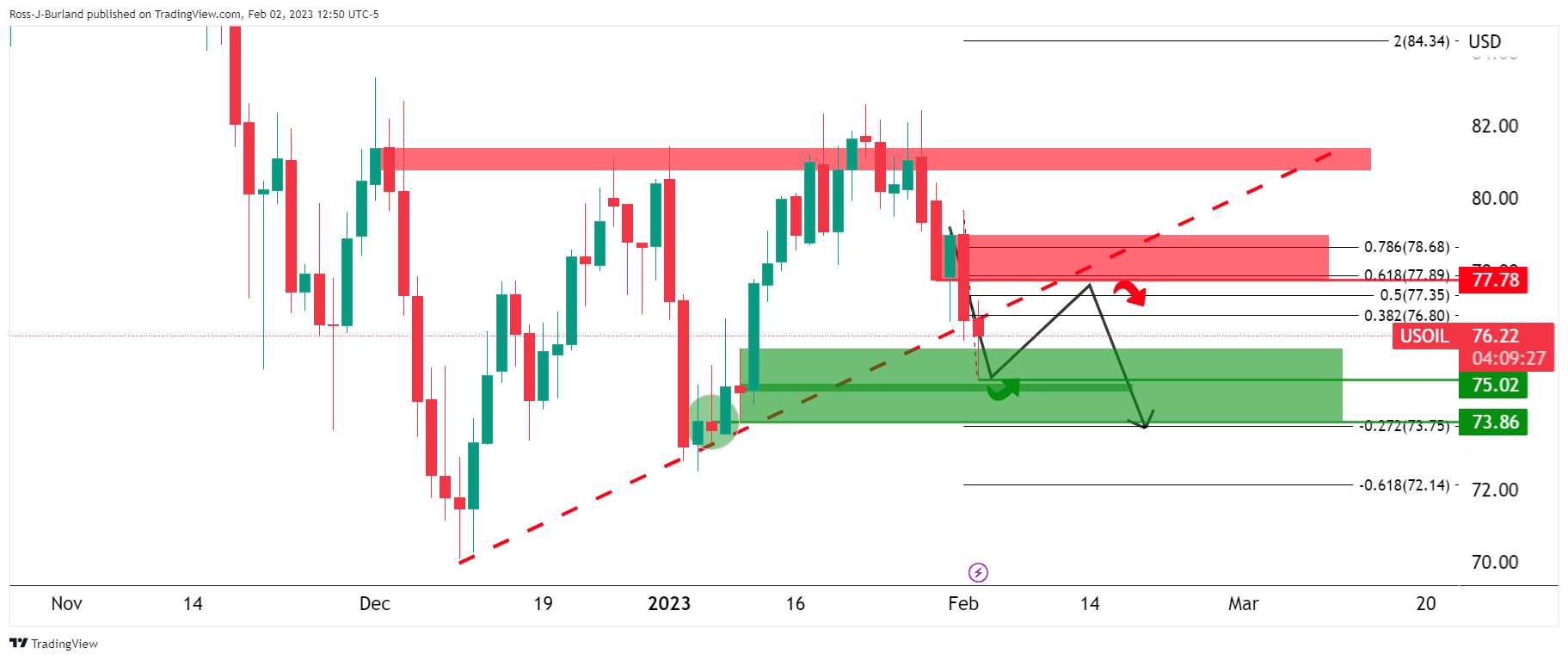
The daily chart shows the price breaking the trendline support but meeting horizontal support and correcting. If this is the start of a daily correction, then the $77.70s are eyed in a 61.8% ratio of the bearish impulse.
Moving down to the 15-minute chart we can see a price imbalance between $77.18 and $78.04 for the bulls to target:

On Thursday, the Bank of England (BoE) hiked the policy rate by 50 basis points to 4.00%. Analysts at Danske Bank expect the increasingly weak growth outlook to support a near-term ending to the hiking cycle.
Key quotes:
“EUR/GBP initially moved lower upon announcement but quickly retraced as expected with the more dovish nature of the statement. Followed by a less than expected hawkish ECB EUR/GBP is back close to opening levels. We continue see a case for the EUR/GBP cross to move modestly lower in the coming year as a global growth slowdown and the relative appeal of UK assets to investors are a positive for GBP relative to EUR.”
“We continue to expect the BoE to deliver a final 25bp hike in March. Our expectations fall below current market pricing (currently 34bps until June 2023) as we expect the rest of the BoE committee to increasingly turn less hawkish amid a weakening growth backdrop and easing labour market conditions. Markets is pricing in 40bp of cuts during H2, while we keep our forecast of the first cut to be delivered in the beginning of 2024.”
The European Central Bank (ECB) raised its key interest rates on Thursday by 50 basis points as expected and flagged another 50bp hike in March. Despite such decisions and Lagarde’s hawkish comments, European bond yields tumbled. Analysts at Rabobank point out the central bank continues to struggle with its image and credibility. They expect a 50bp hike in March, followed by two 25bp hikes in Q2 to a terminal rate of 3.50%.
Markets ran away with the few dovish parts of the announcement
“The ECB continues to struggle with its credibility issues ever since it started playing fast and loose with forward guidance. Despite an overall hawkish hike, markets largely ignored Lagarde’s attempts to clarify the ECB’s reaction function. Underlying inflation is “alive and kicking”, and the ECB will stay the course until there are convincing signs that inflation will converge back to the 2% target. We don’t think that the ECB gets this proof before summer, and we’ve accordingly increased our terminal rate forecast to 3.50%.”
“Despite the market not buying Lagarde’s message, we will bite. We have revised up our rate forecasts significantly to a 3.5% terminal rate. However, that is clearly a restrictive level that cannot be sustained by the Eurozone economy. We have pencilled in a first cut in 2024H2.”
- After hitting 18-month-lows, the USD/CHF is back above the 0.9100 threshold.
- USD/CHF Price Analysis: Remains downward biased below 0.9180, but once reclaimed, buyers would target 0.9280.
The USD/CHF climbs sharply after diving to fresh 18-month lows at 0.9059. However, it’s staging a comeback as the greenback gets bolstered following Wednesday’s US Federal Reserve’s decision to lift rates, which initially was perceived as dovish in the FX space. Nevertheless, the US Dollar (USD) had erased most of Wednesday’s losses, a tailwind for the USD/CHF. Therefore, the USD/CHF exchanges hand at 0.9221, above its opening price by 0.50%.
USD/CHF Price Analysis: Technical outlook
After the Fed’s decision, the USD/CHF fall continued on Wednesday, reaching new YTD lows, which were broken on Thursday. As the North American session progressed, USD/CHF bulls stepped in at 0.9050s and lifted the spot back above 0.91000.
Although the USD/CHF pair holds to gains in the day, it remains downward biased and is expected to extend its losses as long as it stays below 0.9180. A breach of 0.9059, the YTD low, would set the stage to challenge the 0.9000 psychological barrier.
On the other side, if the USD/CHF reclaims the February 1 high of 0.9182, that would exacerbate a test of the 0.9200 figure. Once cleared, the 20-day Exponential Moving Average (EMA) is next, followed by the January 31 high at 0.9288, ahead of 0.9300.
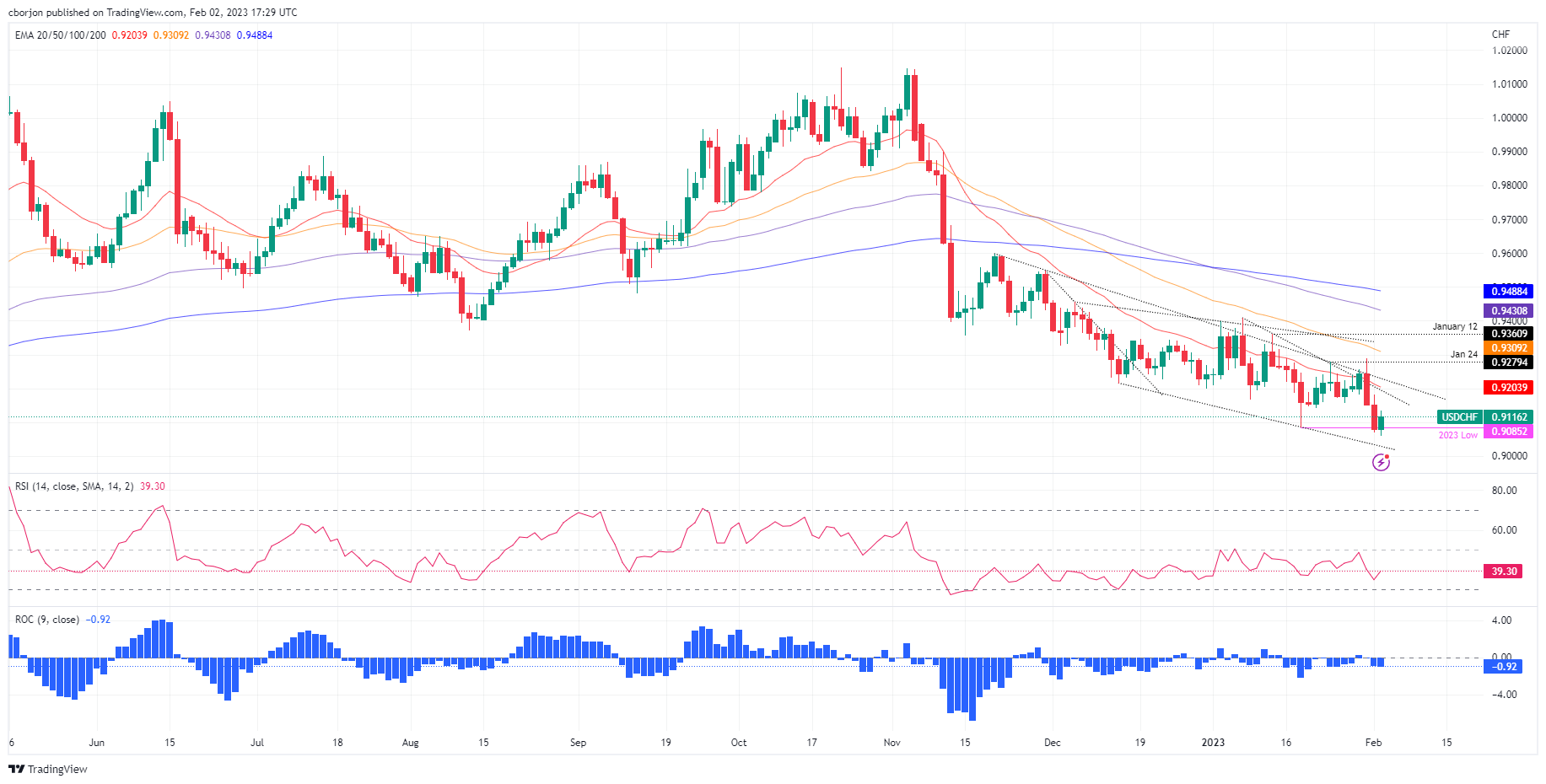
USD/CHF Key Technical Levels
On Friday, the US will release the official employment report for the month of January. Analysts at TD Securities expect a 220K increase in payroll and a modest increase in the unemployment rate to 3.6%.
A still resilient labor market
“We project payroll gains to have stayed largely unchanged vs December, posting a still solid 220k increase in January. Both the unemployment rate and average hourly earnings should have remained steady: the former at a decades-low 3.5%, and the latter printing a 0.3% m/m gain. Note that the January jobs report will also include important revisions to the establishment survey data for 2022.”
“Following Powell's flip in script, the market is asymmetric around this number. That is, a positive surprise is not likely to materially derail risk sentiment, while an indication of softness will reinforce it. That's key for the USD and other FX baskets which have more closely aligned itself to equity dynamics. That could prevent the USD from sinking to new lows in the near-term. Ultimately however, we expect to see dip buying interest in EURUSD towards 1.08.”
The European Central Bank, as expected, rose the key interest rates by 50 basis points on Thursday. Analysts at Danske Bank see another 50bp hike in March and a 25bp in May. They consider that medium-term drivers indicate that the EUR/USD pair is overvalued.
Markets conclude ECB is close to being done
“Markets took the ECB’s communication as a sign that the ECB is close to ending its hiking cycle, as bond yields rallied strongly. We judge that today’s communication reflects a very split governing council. We still expect the ECB to hike its policy rates by 50bp in March and 25bp in May.”
“In recent weeks, EUR/USD has defied the shift and sudden underperformance of Eurozone equities, which we otherwise deem to have been an important driver behind the EUR/USD rally since September (Eurozone equities overperforming during this period). Our tactical conviction on EUR/USD is not high, but we maintain a clear sell-on-rallies bias for the cross as we still think medium-term drivers indicate that EUR/USD is overvalued (and not undervalued).”
- GBP/USD dropped after the Bank of England lifted rates and gave no signals for further increases.
- The BoE foresees a shallow recession in the UK and expects inflation at around 4% by year’s end.
- US labor market data portrays the tightness of the job markets, with traders eyeing Friday’s Nonfarm Payrolls report.
The GBP/USD collapses after the Bank of England’s decision to raise the Bank Rate by 50 bps to the 4% threshold. Economic data revealed in the United States (US) reassured the tightness of the labor market, meaning that the US Federal Reserve, albeit hiked rates 25 bps on Wednesday, still has ways to go. At the time of typing, the GBP/USD exchanges hands at 1.2280 after hitting a high of 1.2401.
The Bank of England raised rates, but the Pound failed to rally
Before Wall Street opened, the Old Lady of Threadneedle lifted rates to its highest peak since 2008, from 3.50% to 4%, in a split 7-2 vote, as two members voted for no change to the Bank Rate. Following the BoE’s decision, its Governor Andrew Bailey said that “we’ve seen the first signs that inflation has turned the corner,” but commented that it’s too soon to declare victory, adding that members of the Monetary Policy Committee (MPC) would need to be “absolutely sure” that inflation is cooling.
On its statement, the BoE removed the “respond forcefully, as necessary” phrase, opening the door for speculations that Bailey and Co. could pause if needed. The BoE updated its forecasts in the monetary policy report and expects inflation to edge toward 4% by the end of 2023. The BoE added that a recession might hit the UK, but it would be “shallower,” with Gross Domestic Product (GDP) foreseen at -0.5% in 2023, vs. November’s -1.5%, projected by the BoE.
Given the backdrop, the GBP/USD extended its losses toward its daily low of 1.2238 before recovering some territory and reclaiming the 20-day EMA at 1.2289.
Aside from this, the US Department of Labor (DoL) revealed that Initial Jobless Claims for the last week ending on January 28 dropped to 183K, slightly below the last week’s 186K and lower than the 200K estimated by street analysts, showing the labor market resilience. Today’s data added to Wednesday’s JOLTs report that showed vacancies rising, while an ISM report on Wednesday stated that manufacturers “are not substantially” reducing their personnel.
Meanwhile, on Wednesday, the US Federal Reserve raised rates to the 4.50-4.75% range as widely expected, though it kept the door open for more hikes as needed. Fed’s Chair Jerome Powell added that more rates “will be appropriate,” emphasized the FOMC’s commitment to bring inflation down to the 2% target, and acknowledged that the “disinflation process has started,” which sent equities rallying sharply.
What to watch?
The economic docket will feature the S&P Global/CIPS Services and Composite PMIs and BoE’s Huw Pill speech on Friday. On the US front, employment data led by the Nonfarm Payrolls report, alongside the ISM Non-Manufacturing report, would update the US economy status.
GBP/USD Key Technical Levels
- US Stocks extend post-FOMC rally.
- Dollar gains momentum during American session, DXY off monthly lows.
- AUD/USD corrects lower, hovers around 0.7100.
The AUD/USD dropped further during the American session hit a fresh daily low at 0.7068, slightly above the level it had before the FOMC statement. The pair is hovering around 0.7100, attempting to recover that area. The greenback gained momentum across the board during the last hours. The NFP is due on Friday.
Equity markets are up again on Thursday, extending the post-Fed rally and also following rate hikes from the Bank of England and the European Central Bank. At the same time, bond yields are down sharply. Despite risk appetite and lower yields, the US Dollar rose sharply on American hours.
The US Dollar Index is up by 0.30%, recovering from multi-month lows. At the same time, gold and silver are making a sharp reversal.
Weaker commodity prices and a stronger Dollar pushed AUD/USD away from the seven-month high it reached earlier on Thursday at 0.7157.
From a technical perspective, if the AUD/USD consolidates well below 0.710 there would be a deterioration in the outlook for the Aussie. The next support is seen at 0.7060 followed by 0.7030. The pair needs to recover initially 0.7100 and then hold above 0.7130 to keep the doors open to fresh cycle highs.
Technical levels
What is the outlook for Gold after the sharp moves in recent months? Economists at Standard Chartered see risks of a pullback.
Gold rally appears stretched
“Our proprietary indicator, fractals, is signalling that recent rally has led to stretched technicals for Gold, which has shot past our end-2023 price target of $1,890. Hence, we see elevated risk of a consolidation or even a pullback in Gold over the next few weeks.”
“We would prefer to wait for a pullback towards $1,840 area before adding further exposure to Gold.”
The outlook for the Brazilian Real has brightened. Economists at Commerzbank believe that the USD/BRL pair could challenge the 5 level.
Brazilian central bank remains BRL supportive
“While BCB kept the key interest rate unchanged at 13.75%, as expected, it left no doubt that it has its eye on inflation expectations, which had picked up in view of the government's planned support measures. The BCB is clearly committed to further tightening measures if inflation does not fall further toward its inflation target as expected.”
“As the real interest rate is expected to remain clearly positive, we see the Real remaining well supported.”
“If the USD weakness continues, a serious test of the 5 mark in USD/BRL is by no means out of the question.”
- Gold plunges across the board, even though US Treasury yields are dropping.
- The US Dollar recovered some ground, bolstered by the Euro and Pound Sterling fall.
- On Wednesday, the US Federal Reserve hiked rates by 25 bps and signaled it is about to end its cycle.
- Following the US central bank lead, the BoE and the ECB lifted rates by 50 bps.
Gold price retreats after hitting a nine-month high at $1959.74. However, it is below the $1950 barrier after the US Federal Reserve (Fed) hiked rates by 25 bps on Wednesday. Data revealed in the United States (US) economic docket showed the labor market remains resilient. In addition, two other central banks, namely the Bank of England (BoE) and the European Central Bank (ECB), added to the chorus of tightening policy. At the time of writing, the XAU/USD exchanges hands at around $1920, below its opening price.
US Federal Reserve lifted rates but sounded dovish
Walk Street is set to extend its Wednesday gains after Jerome Powell, and Co. lifted rates. He said “that ongoing increases in the target range will be appropriate” as the Federal Reserve battles to curb stubbornly high inflation and emphasized the Fed’s commitment to return inflation to “2% over time.” Powell said the “disinflation process has started,” giving the green light to risk-perceived assets, extending its rally as Powell spoke.
US Dollar benefits from EUR and GBP fall, a headwind for Gold
In the meantime, the US Dollar Index (DXY), a measure of the buck’s value against a basket of currencies, is trimming some of its losses, up 0.44%, at 101.61, bolstered by the market’s reaction to the BoE’s and ECB’s decisions. Meanwhile, global bond yields are plummeting, with the US 10-year benchmark note rate down six bps, at 3.354%. That said, Gold failed to gain traction, and continues to tumble even more after hitting $1944 at around 14:25 GMT, extending its losses towards the $1920s area.
Unemployment claims in the United States dropped
Data-wise, the US Department of Labor (DoL) revealed that Initial Jobless Claims for the week ending on January 28 fell to 183K, three thousand below the last week’s 186K and well below the 200K estimated by street analysts, showing the labor market resilience. Today’s data added to Wednesday’s JOLTs report that showed vacancies improved, while an ISM report on Wednesday stated that manufacturers “are not substantially” reducing their personnel.
Central Banks in Europe tightened monetary conditions
On Thursday, the Bank of England decided to raise rates by 50 bps to 4%, marking the tenth time since the BoE hiked on December 2021. The BoE Governor Andrew Bailey said that since the November meeting, the BoE has seen the “first signs that inflation has turned the corner.” He added that “it’s too soon to declare victory just yet, inflationary pressures are still there.” Meanwhile, the European Central Bank added to the list of central banks lifting rates to 0.50%, leaving the deposit rate at 2.50%, and signaled that a 50 bps hike in March is possible.
Gold Technical Analysis
Technically speaking, XAU/USD had erased Wednesday’s gains, forming a bearish engulfing candle pattern, which, if confirmed, could exacerbate downward price action. The XAU/USD bullish scenario would remain above $1900; otherwise, the yellow metal could extend its losses. A breach of $1900 will expose the January 18 low of 1896.74, followed by the June 13 high-turned-support at $1879.45, ahead of the $1850 psychological support.
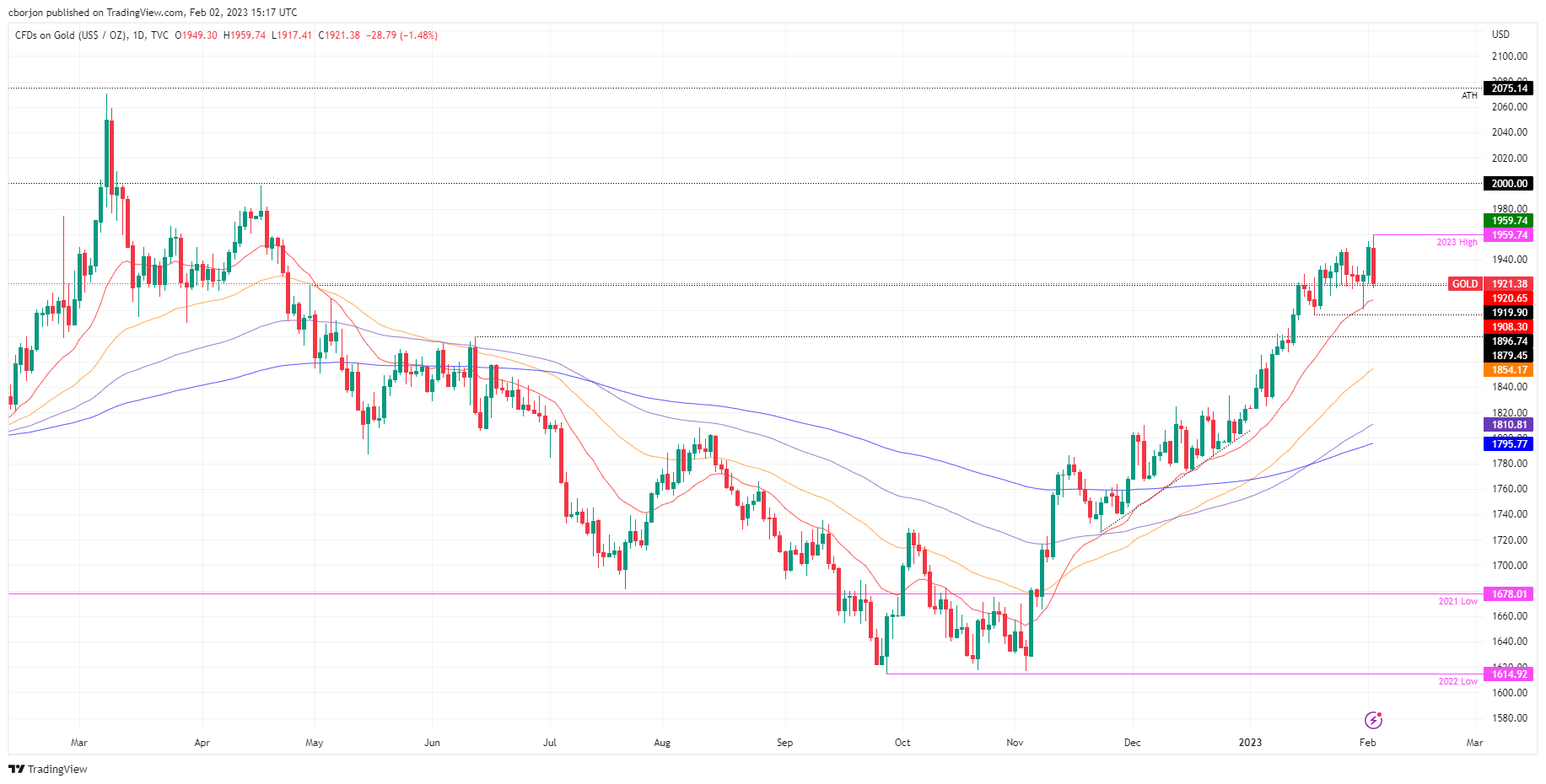
Economists at TD Securities like EUR upside versus USD, GBP, and CHF in the months ahead.
EUR moves a bit too far, too fast
“We’re wary of chasing EUR/USD higher here. Our GMPCA fair value sits just below 1.07, while HFFV rests around 1.09. In turn, we would look to use dips towards the 1.0750 level to position for a break of 1.10 in the months ahead. We’re forecasting a push towards 1.15 in Q2.”
“We see EUR/CHF to 1.06 and EUR/GBP through 0.90 in the months ahead.”
- Sovereign bond yields drop after central bank meetings.
- Risk appetite deteriorates after Wall Street’s opening bell.
- USD/JPY remains above key technical area above 128.00.
The USD/JPY dropped further on Thursday and bottomed at 128.07, reaching the lowest level in two weeks. It remained above 128.00 and trimmed losses after US markets opened.
The move-off lows took place amid a deterioration in market sentiment that offered support to the greenback across the board. The pair is back above 128.50, still down for the day, on its way to the third consecutive daily loss.
Bonds rally, yen benefits
The Bank of England and the European Central Bank both raised key interest rates by 50 basis points as expected. On Wednesday, the Federal Reserve raised it rate by 25 basis points. Central bankers showed more optimism in the economy. Powell signalled at more rate hikes to bring the rate to “appropriately restrictive”. The ECB announced it intends to raise by 50 bps in March.
Following the announcements, sovereign bonds rose, favoring the Japanese Yen across the board. The US 10-year yield fell to as low as 3.33%, the lowest in two weeks, before rebounding to 3.37%. The German 10-year yield stands at 2.10%, down 6.70% for the day. The 10-year UK bond yields drops 5.95% at 3.09%.
Despite USD/JPY moving off lows, the Yen is trading at daily highs across the board. The US Dollar has risen sharply during the last hours, erasing most of the FOMC losses.
US data was offset by central banks on Thursday but on Friday the Non-farm payroll report is due and will be watched closely. Data released on Thursday showed Initial Jobless Claims fell unexpectable to 183K, the lowest level since April. Factory Orders rose 1.8% in December, below the expected 2.2%.
Levels to watch
The USD/JPY was able to hold above 128.00, a key technical level. The US dollar needs to regain the 129.10 area in order to gain support. Above the next resistance stands at 129.80 followed by the weekly high at 130.55.
A consolidation under 128.00 would increase the bearish pressure, exposing the next support seen at 127.55.
Technical levels
The Canadian Dollar has gained ground on the greenback since the beginning of the year. Economists at the National Bank of Canada still expect the CAD to outperform the USD in 2023.
BoC unlikely to cut rates more aggressively than the Fed
“At this stage, we do not expect the Bank of Canada to cut rates more aggressively than the US in 2023, which would put downward pressure on the Loonie.”
“Speculators are currently the most bearish on the CAD since the Covid recession. A change of heart would certainly provide the impetus for the Loonie to appreciate.”
“We still expect the CAD to outperform the USD in 2023.”
USD/JPY quickly turned back lower yesterday. The focus is back onto Credit Suisse’s 127.53/27 prior core objective, which now looks set to be broken more imminently.
USD/JPY looks to be turning back lower
“With US Yields failing to follow through on the recent reversal back higher, the short-term risk for USD/JPY quickly looks to be turning lower again, in line with our broader negative view.”
“Below 127.53/23 then would open up a move to next support at 126.36 and eventually the 61.8% retracement of the 2021/2022 uptrend at 121.44.”
“Resistance is seen at 130.36, which is the key 21-day exponential average, then 131.12, before the recent high at 131.58. A break above here would suggest a deeper recovery to 132.28, potentially 132.88, where we would look for a cap if reached.”
The Federal Reserve raised its key interest rate corridor by 25 basis points to 4.50%-4.75%, as expected. In the view of economists at Commerzbank, the Fed is unlikely to do much more before it reaches its rate peak.
The Fed returns to "normal" rate hikes
“The Fed raised its key interest rates by 25 bps, as expected. The federal funds target corridor is now at 4.50% to 4.75%.”
“In the statement published after the meeting, the Fed did not indicate an imminent end to the rate hikes.”
“Fed Chair Powell emphasized that the US is only at the beginning of a disinflationary process. However, the Fed is probably not too far away from the rate peak.”
Christine Lagarde, President of the European Central Bank (ECB), is delivering her remarks on the policy outlook and responding to questions from the press following the Governing Council's decision to hike key rates by 50 basis points in February.
Key takeaways
"I can't think of scenarios where 50 bps hike would not happen unless they're quite extreme."
"Bank lending survey shows good transmission of ECB monetary policy."
"In all Reasonable scenarios, significant hikes are needed."
"We have to be attentive to energy components and pass-through."
"Wouldn't say that disinflationary process is already at play."
About ECB's press conference
Following the ECB´s economic policy decision, the ECB President gives a press conference regarding monetary policy. Her comments may influence the volatility of EUR and determine a short-term positive or negative trend. Her hawkish view is considered as positive, or bullish for the EUR, whereas her dovish view is considered as negative, or bearish.
Economists at TD Securities remain constructive on EUR/GBP and expect a re-entry to 0.90/0.92 in the weeks ahead.
GBP will become a laggard in broad terms
“The BoE appears to be joining the Fed and BoC in nearing a pause in the hiking cycle. This, we think, means that GBP will become a laggard in broad terms.”
“In crosses, we look for GBP to extend weakness against EUR and JPY.”
“EUR/GBP remains rather constructive after a punch above 0.89. We expect a re-entry into a new higher trading range marked by 0.90/0.92.”
“We remain medium-term bulls on the JPY as we believe that the BoJ is on borrowed time and will need to make more changes to YCC soon; 155 is near-term support, but we see extension risk to 150.”
Quek Ser Leang, Markets Strategist at UOB Group, assesses the recent price action around EUR/USD.
Key Quotes
“In our Chart of the Day update from about 3 weeks ago (13 Jan 2023, when EUR/USD was trading at 1.0840), we held the view that EUR/USD is likely to continue to advance. We highlighted that, ‘a break above the top of the weekly Ichimoku cloud at 1.0930 would suggest further upside risk in the months ahead’. We indicated, ‘The next resistance level above 1.0930 is at 1.1120’.”
“EUR/USD subsequently rose but did not break 1.0930 until yesterday (01 Feb 2023) when it blew past 1.0930 and moved above the top of the weekly Ichimoku cloud for the first time since Jun 2021. The price actions have improved the technical outlook for EUR/USD further. Not surprisingly, we continue to expect EUR/USD to advance. While EUR/USD is likely to break above 1.1120, it remains to be seen whether the 2022 high of 1.1495 is within reach in the next few months.”
“On the downside, 1.0785 is a solid support level. However, only a breach of the 55-week exponential moving average (currently at 1.0615) would indicate that the rally that started in Sep 2022 is not extending further.”
Christine Lagarde, President of the European Central Bank (ECB), is delivering her remarks on the policy outlook and responding to questions from the press following the Governing Council's decision to hike key rates by 50 basis points in February.
Key takeaways
"Discussion was marked by contuinity and consistency."
"Very very large consensus today."
"We haven't reached the peak in rate, we have ground to cover."
"We will need to assess pace and level."
"There was general agreement on 50 bps in February and March."
"There was discussion and not full agreement on communication."
"Underlying inflation pressures, fiscal measures, wages all warrant 50 bps hike in March."
About ECB's press conference
Following the ECB´s economic policy decision, the ECB President gives a press conference regarding monetary policy. Her comments may influence the volatility of EUR and determine a short-term positive or negative trend. Her hawkish view is considered as positive, or bullish for the EUR, whereas her dovish view is considered as negative, or bearish.
- EUR/USD probes the area of daily lows near 1.0930.
- ECB said it will hike by another 50 bps in March.
- Lagarde noted that the bloc’s economic activity slowed markedly.
EUR/USD retreats further and flirts with the 1.0930 region, or daily lows, on Thursday.
EUR/USD: Initial resistance emerges around 1.1030
EUR/USD now accelerates its daily losses and hovers around the 1.0930 region as, Chair Lagarde’s press conference is under way.
Following the telegraphed 50 bps rate hike at today’s ECB event, Chairwoman C.Lagarde said another 50 bps rate raise is on the cards at the March meeting before evaluating the subsequent moves by the bank regarding its policy.
Lagarde also noted that the economic activity in the region slowed markedly and growth is expected to remain weak, while elevated inflation and tighter financial conditions remain a headwind for spending and production.
Lagarde also highlighted the resilience of the economy and suggested that a recovery is expected in the next months, while inflation risks have become more balanced.
What to look for around EUR
The pronounced upside pushed EUR/USD north of the key 1.1000 hurdle on Thursday, although the pair retreated markedly in the wake of the ECB event.
In the meantime, price action around the European currency should continue to closely follow dollar dynamics, as well as the potential next moves from the ECB after the central bank delivered a 50 bps at its meeting on Thursday.
Back to the euro area, recession concerns now appear to have dwindled, which at the same time remain an important driver sustaining the ongoing recovery in the single currency as well as the hawkish narrative from the ECB.
Key events in the euro area this week: Germany Balance of Trade, ECB Interest Rate Decision, ECB Lagarde (Thursday) - Germany, EMU Final Services PMI (Friday).
Eminent issues on the back boiler: Continuation of the ECB hiking cycle amidst dwindling bets for a recession in the region and still elevated inflation. Impact of the Russia-Ukraine war on the growth prospects and inflation outlook in the region. Risks of inflation becoming entrenched.
EUR/USD levels to watch
So far, the pair is retreating 0.32% at 1.0952 and the breakdown of 1.0930 (low February 2) would target 1.0802 (weekly low January 31) en route to 1.0766 (weekly low January 17). On the flip side, the next up barrier emerges at 1.1032 (2023 high February 2) followed by 1.1100 (round level) and finally 1.1184 (weekly low March 31 2022).
EUR/GBP is trying to break out above the top of its range at 0.8896/8904, which would open up a move to 0.8993 next, economists at Credit Suisse report.
Break below 0.8800 to signal a false breakout attempt
“A clear and closing break above key resistance at the recent high and 50% retracement of the fall from September at 0.8899/8904 would rekindle thoughts of a basing process, with resistance then seen next at 0.8993/9006, which is the 61.8% retracement of the fall from September, then 0.9066, which is a key price high.”
“Key support moves to 0.8904/8899, then 0.8880. Below here would signal a false breakout attempt, with more important support then seen all the way back at the 55DMA and price support at 0.8742/15. Only a break below here would turn the risks lower within the range.”
Christine Lagarde, President of the European Central Bank (ECB), is delivering her remarks on the policy outlook and responding to questions from the press following the Governing Council's decision to hike key rates by 50 basis points in February.
Key takeaways
"Energy prices are lower than expected in December."
"Price pressures remain strong."
"While weakening, pent-up demand still driving up prices."
"Recent data on wage dynamics in line with ECB forecasts."
"Risks to growth are more balanced."
"Risks to inflation outlook are more balanced."
About ECB's press conference
Following the ECB´s economic policy decision, the ECB President gives a press conference regarding monetary policy. Her comments may influence the volatility of EUR and determine a short-term positive or negative trend. Her hawkish view is considered as positive, or bullish for the EUR, whereas her dovish view is considered as negative, or bearish.
- GBP/JPY continues losing ground for the third straight day and drops to a two-week low.
- Expectations for a hawkish shift by the BoJ underpin the JPY and exert some pressure.
- The BoE’s dovish outlook weighs heavily on the GBP and contributes to the sharp decline.
The GBP/JPY cross extends the previous day's bearish breakdown momentum below the 160.00 psychological mark and remains under heavy selling pressure for the third straight day on Thursday. The downward trajectory picks up pace after the Bank of England announced its policy decision and drags spot prices to a two-week low, around mid-157.00s.
The British Pound weakens across the board in reaction to a dovish assessment of the BoE's policy outlook and turns out to be a key factor dragging the GBP/JPY cross lower. In the accompanying policy statement, the UK central bank removed the phrase that they would "respond forcefully, as necessary". Furthermore, BoE Governor Andrew Bailey said that inflation will continue to fall this year and more rapidly during the second half of 2023. This, in turn, suggests that the BoE might be nearing the end of the current rate-hiking cycle amid looming recession risks and weighs on the GBP.
The Japanese Yen (JPY), on the other hand, is drawing support from expectations that high inflation may invite a more hawkish stance from the Bank of Japan (BoJ) later this year. The bets were lifted by recent data, which showed that Nationwide core inflation in Japan reached its highest annualized print since December 1981. This is seen as another factor exerting downward pressure on the GBP/JPY cross. That said, a goodish intraday recovery in the equity markets acts as a headwind for the safe-haven JPY and assists the cross to bounce back to the 158.00 round-figure mark in the last hour.
The fundamental backdrop, meanwhile, seems tilted firmly in favour of bearish traders and suggests that the path of least resistance for the GBP/JPY cross is to the downside. Hence, any subsequent recovery might still be seen as a selling opportunity and runs the risk of fizzling out rather quickly.
Technical levels to watch
Christine Lagarde, President of the European Central Bank (ECB), is delivering her remarks on the policy outlook and responding to questions from the press following the Governing Council's decision to hike key rates by 50 basis points in February.
Key takeaways
"We expect growth to stay weak."
High inflation, tighter financing conditions dampen spending and production."
"Supply bottlenecks are gradually easing."
"Supply of gas has become more secure."
"Rising wages to restore some purchasing power."
"Economy more resilient than expected, should recover in coming quarters."
"Job creation may slow, unemployment could rise."
"Important to start rolling back fiscal support."
"Fiscal measures could exacerbate inflationary pressures, necessitate stronger ECB response."
About ECB's press conference
Following the ECB´s economic policy decision, the ECB President gives a press conference regarding monetary policy. Her comments may influence the volatility of EUR and determine a short-term positive or negative trend. Her hawkish view is considered as positive, or bullish for the EUR, whereas her dovish view is considered as negative, or bearish.
- EUR/USD trims initial gains and drops to the 1.0970/60 band.
- ECB raised rates by 50 bps, as broadly expected.
- Market participants now look at Lagarde’s press conference.
The buying bias in the European currency run out of further steam and forced EUR/USD to return to the negative ground after climbing as high as the 1.1030 zone earlier in the session.
EUR/USD now focuses on Lagarde’s presser
EUR/USD now trades with humbles losses after the ECB matched estimates and raised the policy rate by half percentage point at its meeting on Thursday.
Indeed, the central bank raised the interest rate on the main refinancing operations, the interest rate on the marginal lending facility and the deposit facility to 3.0%, 3.25% and 2.50%, respectively.
The ECB reiterated that further rate hikes remain on the cards – with another 50 bps “scheduled” at the March gathering - and the decision on future rate raises will remain data-dependent and in a meeting-by-meeting approach.
Moving forward, market participants will now closely follow the usual press conference by Chairwoman Lagarde and the subsequent Q&A session.
EUR/USD levels to watch
So far, the pair is retreating 0.05% at 1.0982 and the breakdown of 1.0802 (weekly low January 31) would target 1.0766 (weekly low January 17) en route to 1.0639 (55-day SMA). On the flip side, the next up barrier emerges at 1.1032 (2023 high February 2) followed by 1.1100 (round level) and finally 1.1184 (weekly low March 31 2022).
- Unit Labor Costs in the US rose at a softening pace in Q4.
- US Dollar Index continues to fluctuate slightly above 101.00.
Unit Labor Costs in the nonfarm business sector rose by 1.1% in the fourth quarter of 2022, the US Bureau of Labor Statistics (BLS) reported on Wednesday. This reading followed 2% increase recorded in the third quarter.
Further details of the publication revealed that Nonfarm Productivity rose by 3% in the same period, compared to the market expectation of 2.4%.
Market reaction
The US Dollar Index showed no immediate reaction to these figures and was last seen posting small daily losses at 101.12.
- Initial Jobless Claims in the US decreased by 3,000 in the week ending January 28.
- US Dollar Index stays slightly above 101.00 after the data.
There were 183,000 initial jobless claims in the week ending January 28, the weekly data published by the US Department of Labor (DOL) showed on Thursday. This print followed the previous week's print of 186,000 and came in better than the market expectation of 200,000.
Further details of the publication revealed that the advance seasonally adjusted insured unemployment rate was 1.1% and the 4-week moving average was 191,750, a decrease of 5,750 from the previous week's revised average.
"The advance number for seasonally adjusted insured unemployment during the week ending January 21 was 1,655,000, a decrease of 11,000 from the previous week's revised level," the DOL noted.
Market reaction
The US Dollar Index showed no immediate reaction to this data and was last seen trading virtually unchanged on the day at 101.15.
Bank of England (BoE) Governor Andrew Bailey is delivering his remarks on the policy outlook and responding to questions from the press following the bank's decision to hike the policy rate by 50 basis points to 4% in February.
Key takeaways
"We are hearing from businesses that consumers are becoming more resistant to higher prices."
"Firms are saying they expect pay demands to ease over the course of 2023."
"Important that we have sustainable fiscal policy."
"We welcome government's focus on boosting labour force participation."
About Andrew Bailey (via bankofengland.co.uk)
"Andrew Bailey previously held the role of Deputy Governor, Prudential Regulation and CEO of the PRA from 1 April 2013. While retaining his role as Executive Director of the Bank, Andrew joined the Financial Services Authority in April 2011 as Deputy Head of the Prudential Business Unit and Director of UK Banks and Building Societies. In July 2012, Andrew became Managing Director of the Prudential Business Unit, with responsibility for the prudential supervision of banks, investment banks and insurance companies. Andrew was appointed as a voting member of the interim Financial Policy Committee at its June 2012 meeting."
- EUR/JPY meets with a fresh supply on Thursday and slides back closer to the weekly low.
- Expectations for a hawkish shift by the BoJ underpin the JPY and exert some pressure.
- The intraday selling picks up pace after the ECB announced its monetary policy decision.
The EUR/JPY cross attracts fresh selling in the vicinity of the 142.00 mark on Thursday and continues losing ground through the mid-European session. Spot prices weaken further below the 141.00 round figure and drop to the lower end of the weekly range after the European Central Bank (ECB) announced its policy decision.
As was widely expected, the ECB raises key rates by 50 bps at the end of the February monetary policy meeting. The accompanying policy statement showed that the central bank intends to raise interest rates by another 50 bps in March. The ECB, however, added that it will evaluate the subsequent path of the policy and future rate decisions will continue to be data-dependent, following a meeting-by-meeting approach. This seems to be the only factor that might have disappointed the Euro bulls and exerted fresh downward pressure on the EUR/JPY cross.
The Japanese Yen (JPY), on the other hand, is drawing support from expectations that high inflation may invite a more hawkish stance from the Bank of Japan (BoJ) later this year. The bets were lifted by recent data, which showed that Nationwide core inflation in Japan reached its highest annualized print since December 1981. This further contributes to the offered tone surrounding the EUR/JPY cross and supports prospects for additional losses. Market participants now look to the post-meeting press conference, where comments by ECB President Christian Lagarde will influence the shared currency and provide some impetus to the cross.
Technical levels to watch
EUR/USD has broken above major resistance at 1.0944, suggesting further gains, economists at Credit Suisse report.
Support moving to 1.0944/30
“EUR/USD has broken decisively above our prior target at 1.0944/63 – the 50% retracement of the 2021/2022 fall and the upper end of the trend channel from last September, even earlier than we had expected. We believe this breakout should hold and open up an eventual move to 1.1185, then 1.1275, which is the 61.8% retracement of the 2021/22 fall.”
“Short-term support now moves to the 1.0944/30 breakout point, which should ideally hold.”
Christine Lagarde, President of the European Central Bank (ECB), is scheduled to deliver her remarks on the monetary policy outlook at a press conference at 13:45 GMT.
Follow our live coverage of ECB's policy announcements and the market reaction.
About ECB's press conference
Following the ECB´s economic policy decision, the ECB President gives a press conference regarding monetary policy. Her comments may influence the volatility of EUR and determine a short-term positive or negative trend. Her hawkish view is considered as positive, or bullish for the EUR, whereas her dovish view is considered as negative, or bearish.
The European Central Bank (ECB) announced on Thursday that it raised its key rates by 50 basis points (bps) following the February policy meeting, as expected.
With this decision, the interest rate on the main refinancing operations and the interest rates on the marginal lending facility and the deposit facility will be increased to 3%, 3.25% and 2.5%, respectively.
In its policy statement, the ECB noted that in view of underlying inflation pressures, it intends to raise interest rates by another 50 basis points at its next monetary policy meeting in March and evaluate subsequent path of the monetary policy.
Follow our live coverage of the market reaction to the ECB's policy announcements.
Market reaction
As markets assess the ECB's policy decisions, EUR/USD clings to small daily gains at around 1.1000.
Key takeaways from policy statement via Reuters
" In any event, ECB's future policy rate decisions will continue to be data-dependent and follow a meeting-by-meeting approach."
"Also decided on modalities for reducing Eurosystem’s holdings of securities under APP."
"As communicated in December, APP portfolio will decline by €15 billion per month on average from beginning of March until end of June 2023, and subsequent pace of portfolio reduction will be determined over time."
"Partial reinvestments will be conducted broadly in line with current practice."
"In particular, remaining reinvestment amounts will be allocated proportionally to share of redemptions across each."
"Eurosystem’s corporate bond purchases, remaining reinvestments will be tilted more strongly towards issuers with a better climate performance."
"Without prejudice to ECB’s price stability objective, this approach will support gradual decarbonisation of Eurosystem’s corporate bond holdings, in line with goals of Paris Agreement."
"Detailed modalities for reducing APP holdings are described in a separate press release to be published at 15:45 CET."
"ECB will continue applying flexibility in reinvesting redemptions coming due in PEPP portfolio, with a view to countering risks to monetary policy transmission mechanism related to pandemic."
"Refinancing operations as banks are repaying amounts borrowed under TLTRO, ECB will regularly assess how targeted lending operations are contributing to its monetary policy stance."
"ECB stands ready to adjust all of its instruments within its mandate to ensure that inflation returns to its 2% target over medium term."
"Transmission protection instrument is available to counter unwarranted, disorderly market dynamics that pose a serious."
"Threat to transmission of monetary policy across all euro area countries, thus allowing ECB to more effectively deliver on its price stability mandate."
A potential prolonged pause in the BoC’s tightening cycle may open the door to some risk appetite-related upside for the CAD, in the view of economists at HSBC.
The BoC signals a pause in rate hikes
“With the BoC now potentially pausing its rate hikes, the risk of over-tightening has retreated and the risk of domestic recession has reduced, somewhat supporting the CAD.”
“More broadly, the BoC provides the first example of an end, albeit still a conditional one, to a developed market’s tightening path in the current cycle. Others are likely to join it in the coming months, building a ‘risk on’ narrative that the headwind to activity from global rates is not set to intensify further. This should support the CAD.”
Bank of England (BoE) Governor Andrew Bailey is delivering his remarks on the policy outlook and responding to questions from the press following the bank's decision to hike the policy rate by 50 basis points to 4% in February.
Key takeaways
"I don't think ill-health is the main reason why people have left the labour market."
"Main difference between BOE and IMF forecast is IMF expects UK growth to pick up faster after this year."
"Private-sector wage settlements have been higher than we expected in November."
"Pay settlements will be very important for future inflation and BOE policy."
"We are hearing from businesses that consumers are becoming more resistant to higher prices."
About Andrew Bailey (via bankofengland.co.uk)
"Andrew Bailey previously held the role of Deputy Governor, Prudential Regulation and CEO of the PRA from 1 April 2013. While retaining his role as Executive Director of the Bank, Andrew joined the Financial Services Authority in April 2011 as Deputy Head of the Prudential Business Unit and Director of UK Banks and Building Societies. In July 2012, Andrew became Managing Director of the Prudential Business Unit, with responsibility for the prudential supervision of banks, investment banks and insurance companies. Andrew was appointed as a voting member of the interim Financial Policy Committee at its June 2012 meeting."
Bank of England (BoE) Governor Andrew Bailey is delivering his remarks on the policy outlook and responding to questions from the press following the bank's decision to hike the policy rate by 50 basis points to 4% in February.
Key takeaways
"Significant and lingering fall in labour supply from 50-65 year olds weighs on UK economic potential."
"If wholesale energy prices remain at current levels, CPI could be nearly 1 percentage point higher in 3 years' time."
Asked if rates might have peaked, says "we have changed the language we used."
"Change in language reflects a turning in the corner but very early days."
"If risks emerge and we continue to get overshoots in wage data and services inflation, we will have to respond."
"If economy evolves in line with central forecast, we will need to re-evaluate."
About Andrew Bailey (via bankofengland.co.uk)
"Andrew Bailey previously held the role of Deputy Governor, Prudential Regulation and CEO of the PRA from 1 April 2013. While retaining his role as Executive Director of the Bank, Andrew joined the Financial Services Authority in April 2011 as Deputy Head of the Prudential Business Unit and Director of UK Banks and Building Societies. In July 2012, Andrew became Managing Director of the Prudential Business Unit, with responsibility for the prudential supervision of banks, investment banks and insurance companies. Andrew was appointed as a voting member of the interim Financial Policy Committee at its June 2012 meeting."
- EUR/GBP spikes to a fresh multi-month top after the BoE announced its policy decision.
- Hopes that the BoE is nearing the end of the current rate-hiking cycles weigh on the GBP.
- Technical buying above the 0.8900 mark further contributes to the strong intraday rally.
The EUR/GBP cross quickly reverses a mid-European session slide to the 0.8880-0.8875 region and jumps to its highest level since late September after the Bank of England (BoE) announced its decision. The cross is currently placed just below mid-0.8900s, up over 0.60% for the day.
The British Pound weakens across the board in reaction to a dovish assessment of the BoE's policy outlook, which, in turn, provides a strong boost to the EUR/GBP cross. In act, the UK central bank noted that further tightening of monetary policy would be required if there were to be evidence of more persistent pressures. This further fuels speculations that the BoE is nearing the end of the current rate-hiking cycle amid looming recession risks and weighed heavily on the GBP.
The shared currency, on the other hand, continues to draw support from rising bets for additional jumbo rate hikes by the European Central Bank (ECB) in the coming months. The expectations were reaffirmed by the recent hawkish commentary by several ECB officials, suggesting that the path of least resistance for the EUR/GBP cross is to the upside. Apart from this, the strong intraday rally could further be attributed to some technical buying on a sustained strength above the 0.8900 mark.
Investors now look to the BoE Governor's comments at the post-meeting press conference for fresh cues about the future rate-hike path. The key focus, however, will remain on the ECB monetary policy decision amid signs of easing inflationary pressures in the Eurozone. Nevertheless, the fundamental backdrop remains tilted in favour of bulls and supports prospects for further gains. Hence, a subsequent move, towards reclaiming the 0.9000 psychological mark, looks like a distinct possibility.
Technical levels to watch
EUR/USD has broken above 1.10. The pair could reach 1.12/15, according to economists at TD Securities.
Lagarde could pound the table with hawkish rhetoric
“A stronger reading in EU core CPI will give pretext for Lagarde to pound the table with hawkish rhetoric, but whether STIR markets will react accordingly remains another given how much is already priced in until mid-year. As such, we may see this impact further out the curve.”
“With the economy faring better than feared and China re-opening still underway, EUR/USD could find itself at 1.12/15 in short order.”
Bank of England (BoE) Governor Andrew Bailey is delivering his remarks on the policy outlook and responding to questions from the press following the bank's decision to hike the policy rate by 50 basis points to 4% in February.
Key takeaways
"BoE's forecast suggests inflation will come down, fall quite sharply."
"Inflation may not fall as forecast, we are in uncharted territory with inflation above 10%."
"Very high inflation could influence wage and price setting more than we assume in our main forecast."
"Inflation risks are more skewed to the upside than any time in MPC's history."
"It is too soon to declare victory just yet, inflation pressures are still there."
"We need to be absolutely sure we are turning the corner on inflation."
About Andrew Bailey (via bankofengland.co.uk)
"Andrew Bailey previously held the role of Deputy Governor, Prudential Regulation and CEO of the PRA from 1 April 2013. While retaining his role as Executive Director of the Bank, Andrew joined the Financial Services Authority in April 2011 as Deputy Head of the Prudential Business Unit and Director of UK Banks and Building Societies. In July 2012, Andrew became Managing Director of the Prudential Business Unit, with responsibility for the prudential supervision of banks, investment banks and insurance companies. Andrew was appointed as a voting member of the interim Financial Policy Committee at its June 2012 meeting."
- EUR/USD accelerates the rally past the key 1.1000 hurdle on Thursday.
- Next on the upside for the pair comes the round level at 1.1100.
EUR/USD gathers extra buying interest and finally surpasses the key 1.1000 barrier on Thursday.
A move beyond the so far 2023 high at 1.1032 (February 2) should retarget the round level at 1.1100 prior to the weekly peak at 1.1184 (March 31 2022).
The current overbought condition of the pair, however, favours a potential knee-jerk in the very near term.
In the longer run, the constructive view remains unchanged while above the 200-day SMA, today at 1.0316.
EUR/USD daily chart
ECB monetary policy decision – Overview
The European Central Bank (ECB) is scheduled to announce its monetary policy decision this Thursday, December 15, at 13:15 GMT, which will be followed by the post-meeting press conference at 13:45 GMT. Against the backdrop of the recent hawkish commentary by several ECB officials, the markets have been pricing in additional jumbo rate hikes in the coming months. That said, easing of inflationary pressures in the Eurozone might have forced investors to scale back expectations for a more aggressive policy tightening by the ECB. Hence, investors will scrutinize the accompanying monetary policy statement and ECB President Christine Lagarde's comments for fresh cues about future rate hikes.
Analysts at Danske Bank offer a brief preview of the event and write: “Another 50 bps rate hike has been well telegraphed and fully priced by markets. We expect the ECB to continue to sound very hawkish and signal that further rate hikes are coming, in particular giving guidance for another 50 bps hike in March. We expect Lagarde to give a strong reminder to markets to tighten financial conditions. On balance, a firm hawkish message from the ECB should contribute to a stronger EUR upon announcement.”
How could it affect EUR/USD?
According to Valeria Bednarik, Chief Analyst at FXStreet: “the market’s reaction to the ECB monetary policy decision will mostly depend on the wording of the statement and whatever President Christine Lagarde says in the press conference.”
Given that a 50 bps rate hike is already priced in, the markets are unlikely to react to the expected move. That said, a hawkish ECB commentary should be enough to provide a strong boost to the shared currency and allow the EUR/USD pair to build on the post-FOMC momentum beyond the 1.1000 psychological mark. Nevertheless, the announcement should infuse some volatility and allow traders to grab some meaningful opportunities.
Eren Sengezer, European Session Lead Analyst at FXStreet, offers a brief technical outlook and writes: “EUR/USD has pierced through the ascending channel coming from early January after having stayed below it earlier in the week. Moreover, the Relative Strength Index (RSI) indicator on the four-hour chart stays above 70, confirming the pair's overbought conditions.”
Eren also outlined important technical levels to trade the EUR/USD pair: “On the downside, 1.0980 (former resistance, upper limit of the ascending channel) aligns as initial support ahead of 1.0940 (mid-point of the ascending channel) and 1.0920 (former resistance, static level).”
“In case the pair extends its rally on a hawkish ECB message, 1.1030 (static level) aligns as interim resistance before 1.1100 (psychological level, static level) and 1.1140 (static level),” Eren adds further.
Key Notes
• European Central Bank Preview: Lagarde needs to repeat her hawkish message
• EUR/USD Forecast: Investors could ignore overbought conditions on a hawkish ECB
• ECB Preview: Forecasts from 14 major banks, another 50 bps hike
About the ECB interest rate decision
ECB Interest Rate Decision is announced by the European Central Bank. Usually, if the ECB is hawkish about the inflationary outlook of the economy and rises the interest rates it is positive, or bullish, for the EUR. Likewise, if the ECB has a dovish view on the European economy and keeps the ongoing interest rate, or cuts the interest rate it is seen as negative, or bearish.
The Dollar has broken to new lows for the year. Economists at ING expect the US Dollar Index (DXY) to dip toward 100 level.
Lower volatility will support the carry trade
“Positioning is probably the biggest factor preventing a further Dollar decline right now, but the benign macro story does favour DXY continuing to drift lower to the 100 area.”
“Lower volatility in the rates space will be feeding into lower FX volatility. Assuming no major fireworks from today's ECB/BoE meeting or tomorrow's US jobs report, lower volatility will support the carry trade. Here, we like the Mexican Peso where high risk-adjusted carry and, unlike the CEE high yielders, positive real interest rates should keep the MXN very much in demand.”
- GBP/USD fades a mid-European session spike that followed the BoE policy decision.
- Speculations that the BoE is nearing the end of the rate-hiking cycle weigh on the GBP.
- Investors now look to BoE Governor’s comments before placing fresh directional bets.
The GBP/USD pair jumps after the Bank of England announced its policy decision, albeit quickly retreats to a fresh daily low, below the 1.2300 round-figure mark in the last hour.
As was widely expected, the UK central bank hiked interest rates for the 10th time in a row, by another 50 bps to 4%, or the highest level since autumn 2008. In the accompanying monetary policy statement, the BoE noted that further tightening of monetary policy would be required if there were to be evidence of more persistent pressures. This, along with the prevalent US Dollar selling bias, assists the GBP/USD pair to attract some buying at lower levels.
Spot prices rally around 75 pips in the last hour, though struggle to capitalize on the move and remain below the 1.2400 round figure. Against the backdrop of looming recession risk, signs that inflation may have peaked have been fueling speculations that the BoE is nearing the end of the current rate-hiking cycle. This, in turn, acts as a headwind for the British Pound and keeps a lid on any meaningful upside for the GBP/USD pair, at least for the time being.
The market focus now shifts to the post-meeting press conference, where comments by BoE Governor Andrew Bailey might influence the Sterling Pound. Investors will look for fresh clues about future rate hikes, which, in turn, will play a key role in determining the next leg of a directional move for the GBP/USD pair.
Technical levels to watch
- The index remains well under pressure following the FOMC meeting.
- There is interim support near 100.80 so far, or 10-month lows.
DXY comes under extra selling pressure in the wake of the Fed’s decision on rates and retests the 100.80 region, or multi-month lows on Thursday.
In the near term, further losses appear in the pipeline while below the 3-month resistance line near 102.45. If the index manages to clear this region it could accelerate gains to the provisional 55-day SMA, today at 104.02.
Below this line, the dollar is expected to keep the short-term bearish bias unchanged and with the immediate target at the psychological 100.00 support.
In the longer run, while below the 200-day SMA at 106.45, the outlook for the index remains negative.
DXY daily chart
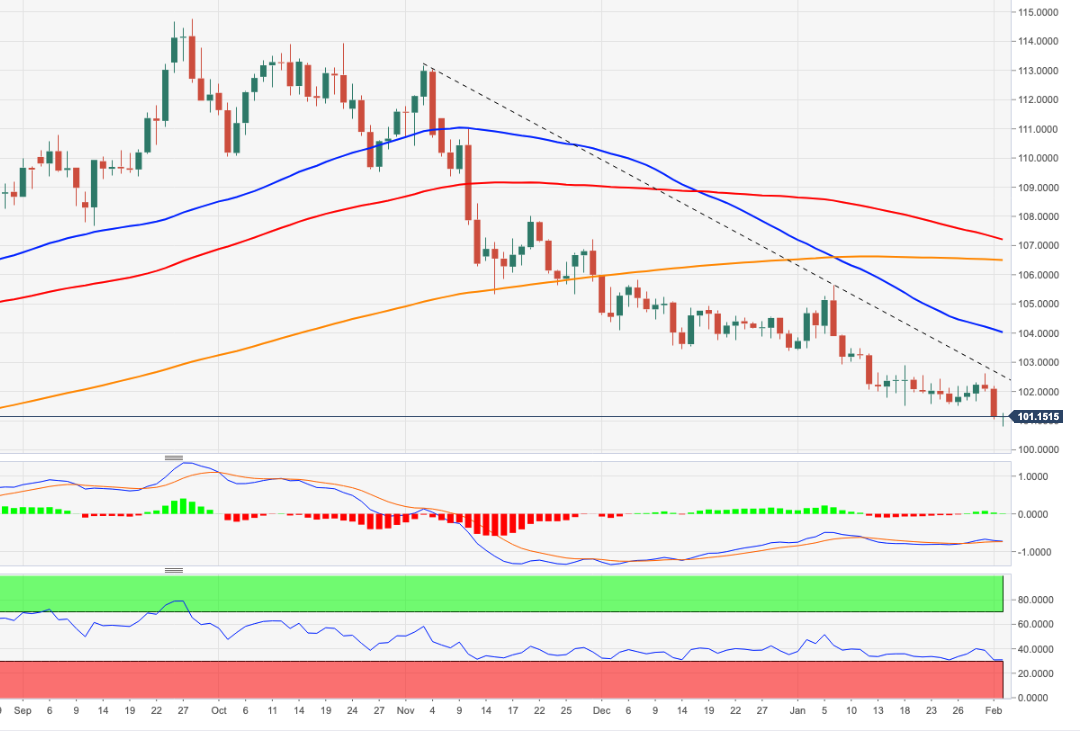
- EUR/JPY remains within the consolidation theme around 141.00.
- The 200-day SMA emerges as the next level of contention so far.
EUR/JPY keeps the side-lined trading unchanged around the 141.00 region so far on Thursday.
Extra consolidation should not be ruled out in the very near term. In case the downside accelerates, the next support of note emerges at the 200-day SMA, today at 140.92. A sustainable drop below the latter exposes extra weakness to, initially, the 138.00 neighbourhood.
In case of occasional bullish attempts, the breakout of the weekly low at 142.29 (January 25) could open the door to a potential test of the key resistance area around 143.00.
The constructive outlook for EUR/JPY is seen unchanged above the 200-day SMA for the time being.
EUR/JPY daily chart
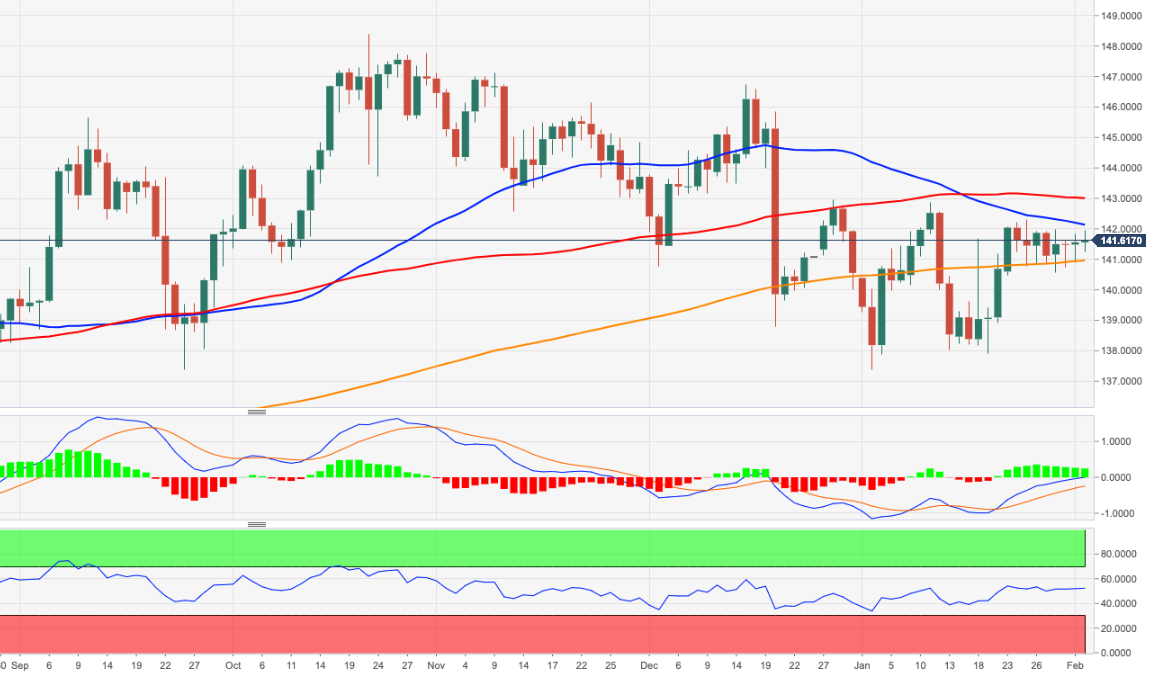
Following its February policy meeting, the Bank of England (BoE) announced that it raised the policy rate by 50 basis points (bps) to 4% as expected. Two policymakers, Tenreyro and Dhingra, vote to keep the policy rate on hold at 3.5%.
Follow our live coverage of the BoE policy announcements and the market reaction.
Market reaction
With the initial market reaction, GBP/USD edged higher and was last seen posting small daily losses at 1.2374.
Key takeaways from policy statement via Reuters
"If there were to be evidence of more persistent pressures, then further tightening of monetary policy would be required."
"Past increases in bank rate expected to have increasing impact on economy in coming quarters."
"BOE sees recession with just under 1% peak-to trough fall in GDP over 5 quarters vs November forecast of around 3% fall over 8 quarters."
"MPCc continues to judge inflation risks are skewed significantly to the upside."
"Inflation to fall to 3.92% by Q4 2023 (November forecast: 5.2%), based on market interest rates and modal forecast."
"Tight labour market and higher-than-expected domestic price and wage pressures point to more persistent inflation."
"BOE forecast shows inflation in one year's time at 3.01% (Nov forecast: 5.2%), based on market interest rates and modal forecast."
"BOE forecast shows inflation in two years' time at 0.95% (Nov forecast: 1.43%), based on market interest rates."
"BOE forecast shows inflation in three years' time at 0.37% (Nov forecast: 0.02%), based on market interest rates."
"Market rates imply less BOE tightening than Nov, show bank rate at 4.4% in Q4 2023, 3.7% in Q4 2024, 3.4% in Q4 2025 (Nov: 5.2% in Q4 2023, 4.7% in Q4 2024, 4.4% in Q4 2025)."
"BOE estimates GDP growth of +0.1% QQ for Q4 2022 (Dec forecast: -0.1% QQ), sees -0.1% QQ in Q1 2023."
"BOE estimates no return of GDP to pre-covid peak before 2026 at earliest, based on market rates (Nov: after 2025)."
"BOE estimates GDP in 2023 -0.5% (Nov forecast: -1.5%), 2024 -0.25% (Nov: -1%), 2025 +0.25% (Nov: +0.5%), based on market rates."
"BOE estimates unemployment rate in Q4 2023 4.3% (Nov: 4.9%); Q4 2024 4.8% (Nov: 5.9%); Q4 2025 5.3% (Nov: 6.4%)."
"BOE estimates real post-tax household income in 2023 -0.5% (Nov: -1.5%), 2024 +1.5% (Nov: +0.75%), 2025 +0.75% (Nov: +1%)."
"BOE estimates wage growth +4% YY in Q4 2023 (Nov: +4.25%), Q4 2024 +2.25% (Nov: +2.75%); Q4 2025 1.5% (Nov: 2%)."
"Covid, Brexit, labour supply and high energy prices have lowered UK potential supply growth for 2024 and 2025."
"BOE sees short-term speed limit for economy of 0.7% in 2024 and 2025 vs 1.7% supply growth for 2010-2019."
"UK goods trade with EU weaker than implied by official data since 2021."
Further hawkish policy guidance from the ECB today would provide further encouragement to EUR bulls. However, economists at Rabobank expect the EUR/USD pair to move back lower toward the 1.06 level over the coming months.
US labour data crucial to determine if EUR/USD can hold above 1.10
“While there is some scope for profit-taking, assuming another hawkish press conference from ECB President Lagarde today we would expect pullbacks to be viewed as EUR buying opportunities.”
“It is likely that the outcome of tomorrow’s US jobs data will dictate whether EUR/USD will muster the energy to hold above the 1.10 area near-term. That said, given our view that the Fed will not cut rates this year and that EUR bulls will run out of steam, we expect that the USD will find support towards the middle of the year and look for a move lower to EUR/USD 1.06 on a three-month view.”
See – ECB Preview: Forecasts from 14 major banks, another 50 bps hike
EUR/USD has seen a breakthrough above 1.10. Will a hawkish ECB add to bullish bid? Economists at Société Générale believe that the pair could extend its rally.
Rally looks technically stretched
“The Euro is pushing on an open door as UST/Bund spreads narrow, and though technicals look stretched, further gains above 1.10 are possible if the ECB is unanimous is delivering a hawkish 50 bps hike.”
“EUR/JPY could be on the cusp of a bullish break out if it can overcome 142.90.”
“EUR/GBP may have another crack at 0.89.”
See – ECB Preview: Forecasts from 14 major banks, another 50 bps hike
Bank of England (BoE) Governor Andrew Bailey is scheduled to hold a press conference, following the monetary policy decisions, at 1230 GMT on Thursday, February 2.
Follow our live coverage of the BoE policy announcements and the market reaction.
About Andrew Bailey (via bankofengland.co.uk)
"Andrew Bailey previously held the role of Deputy Governor, Prudential Regulation and CEO of the PRA from 1 April 2013. While retaining his role as Executive Director of the Bank, Andrew joined the Financial Services Authority in April 2011 as Deputy Head of the Prudential Business Unit and Director of UK Banks and Building Societies. In July 2012, Andrew became Managing Director of the Prudential Business Unit, with responsibility for the prudential supervision of banks, investment banks and insurance companies. Andrew was appointed as a voting member of the interim Financial Policy Committee at its June 2012 meeting."
Economists at TD Securities discuss the Bank of England interest rate decision and its implications for the GBP/USD pair.
Hawkish (20%): 50 bps and more to come
“The MPC softly implies that 50 bps hikes are finished for now, but is less decisive in its guidance, leaving unchanged the conditional language that it can act forcefully if necessary. Governor Bailey keeps all options on the table going forward, and hints that further ‘hikes’ (plural) are likely, suggesting a terminal rate of 4.50% or higher. GBP/USD 0.75%.”
Base Case (50%): 50 bps but gearing down
“The MPC hikes 50 bps, but with an additional third dovish dissent, leaving 5-6 voting for the majority decision. The Summary is likely to imply that the MPC is nearing its terminal rate and signal a downshift in the pace of hikes from March. We expect the MPC to drop the threat of ‘forceful’ hikes. GBP/USD -0.25%.”
Dovish (30%): 25 bps but more to come
“The MPC surprises to the downside with a 25 bps hike. But it's a ‘hawkish 25’ in that they clearly signal they are not done hiking yet, and hint that ‘"hikes’ (plural) will likely continue well into the spring. GBP/USD -1.00%.”
See – BoE Preview: Forecasts from nine major banks, preparing to gear down
Economist at UOB Group Lee Sue Ann expects the BoE to hike its policy rate by half percentage point at its gathering later on Thursday.
Key Takeaways
“While the minutes of the Dec meeting appeared to open the door to a potential downshift to a 25bps move, and this meeting looks like a closer call than markets are pricing; recent economic data has been relatively hawkish.”
“For now, we have pencilled in a 50bps hike at the Feb meeting.”
Economist Lee Sue Ann and Markets Strategist Quek Ser Leang at UOB Group acknowledge the likeliness of USD/CNH slipping back to the 6.6750 region in the short term.
Key Quotes
24-hour view: “After trading quietly for a few days, USD plunged to a low of 6.7152. USD extended its decline today and is likely to drop further. While USD might drop below the Jan’s low near 6.6980, the next support at 6.6750 is unlikely to come under threat. Resistance is at 6.7300, followed by 6.7450.”
Next 1-3 weeks: “Two days ago (31 Jan, spot at 6.7580), we indicated ‘downward momentum has faded and USD is likely to trade sideways within a range of 6.7270/6.7950 for now’. We did not expect the sharp sell-off in NY trade. The sharp drop has resulted in a rapid increase in downward momentum and USD is likely to drop below last month’s low near 6.6980. Further weakness to 6.6750 is not ruled out. Overall, only a breach of 6.7550 (‘strong resistance’ level) would indicate that USD is not ready to head lower.”
CME Group’s flash data for natural gas futures markets noted traders extended their uptrend in open interest and added around 25.7K contracts on Wednesday. In the same direction, volume rose for the third straight session, now by around 112.2K contracts.
Natural Gas: Next on the upside comes $2.00
Prices of the natural gas extended the steep multi-week decline for yet another session on Wednesday. The negative price action was accompanied by increasing open interest and volume, leaving the prospect for further decline well on the cards in the very near term. Of note, however, is that the current oversold condition of the commodity could spark a corrective bounce in the not-so-distant future. The next target of note for sellers emerges at the $2.00 mark per MMBtu, an area last traded back in late September 2020.
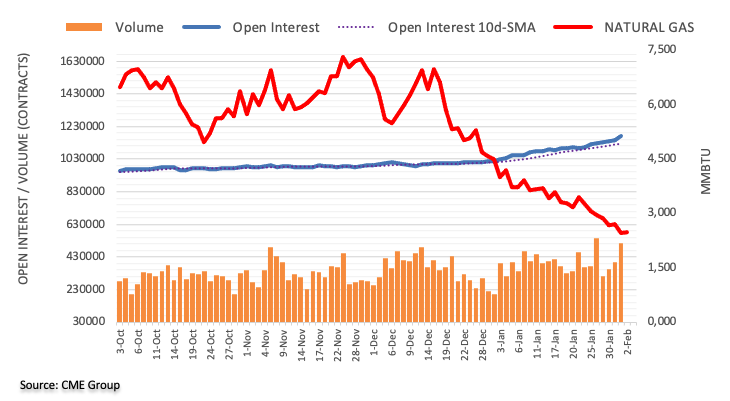
BoE Monetary Policy Decision – Overview
The Bank of England (BoE) is scheduled to announce its monetary policy decision this Thursday at 12:00 GMT. The UK central bank is expected to raise interest rates for the 10th time in a row, by another 50 bps, to the highest level since autumn 2008. That said, signs of easing inflationary pressures might have already set the stage for a dovish pivot amid looming recession risks. Hence, the focus will be on the accompanying statement that provides the Monetary Policy Committee's (MPC) economic and inflation projections. Apart from this, investors will scrutinize BoE Governor Andrew Bailey's comments at the post-meeting press conference at 12:30 GMT.
According to Dhwani Mehta, Senior Analyst and Asian Session Manager at FXStreet: “The language in the central bank’s policy statement, the Minutes of the meetings and Governor Bailey’s presser could hint that the BoE will likely keep up interest rate increases, watering down expectations of the bank signaling a pause in its tightening cycle this month.”
Analysts at Wells Fargo offer a brief overview and write: “With recession on the horizon, we believe the BoE will take a more gradual approach to rate hikes. As of now, financial markets are priced for a 50 bps hike and our peer economists forecast the BoE to lift policy rates by 50 bps as well. However, we believe policymakers will take a more measured approach and lift rates by only 25 bps as they are now more focused on protecting against a prolonged recession. Following this meeting, another 25 bps hike in Q1 is likely, and at the March meeting, we believe policymakers will signal an end to their tightening cycle.”
How could it affect GBP/USD?
Heading into the key central bank event risk, the GBP/USD pair meets with a fresh supply near the 1.2400 mark and reverses a major part of the previous day's post-FOMC positive move. A dovish BoE tilt could exert additional downward pressure on the British Pound and set the stage for an extension of the pair's recent pullback from the vicinity of mid-1.2400s, or the highest level since June 2022.
Conversely, the market reaction to a 50 bps and (or) a neutral stance might fail to impress bulls, suggesting that the path of least resistance for the GBP/USD pair is to the downside. That said, a more hawkish stance, though seems unlikely, should push spot prices beyond the 1.2445 hurdle and set the stage for some meaningful appreciating move in the near term.
Eren Sengezer, European Session Lead Analyst at FXStreet, offers a brief technical overview and explains: “GBP/USD failed to stay within the ascending regression channel coming from early January after having recovered within it late Wednesday. Additionally, the pair was last seen trading below the 20 and the 50-period Simple Moving Averages (SMA) on the four-hour chart with the Relative Strength Index (RSI) indicator dropping below 50, highlighting the lack of buyer interest.”
Eren also outlines important technical levels to trade the GBP/USD pair: “On the downside, the 100-period SMA aligns as first support at 1.2325 ahead of 1.2300 (psychological level, Fibonacci 23.6% retracement of the latest uptrend). A four-hour close below the latter could attract sellers and cause the pair to decline toward 1.2270 (static level) and 1.2210 (Fibonacci 38.2% retracement).”
“1.2360 (50-period SMA) forms interim resistance before 1.2400 (psychological level, static level). If buyers manage to flip the latter into support, GBP/USD could extend its recovery toward 1.2450 (static level, mid-point of the channel),” Eren adds further.
Key Notes
• BoE Interest Rate Decision Preview: The last 50 bps hike but not the end yet
• BoE Preview: Forecasts from nine major banks, preparing to gear down
• GBP/USD Forecast: BOE doves could weigh on Pound Sterling
About the BoE interest rate decision
The BoE Interest Rate Decision is announced by the Bank of England. If the BoE is hawkish about the inflationary outlook of the economy and raises the interest rates it will be positive, or bullish, for the GBP. Likewise, if the BoE has a dovish view on the UK economy and keeps the ongoing interest rate, or cuts the interest rate it will be seen as negative, or bearish.
Fed Chair Powell struggled to sound convincing about a hawkish Fed over the coming months. Economists at Commerzbank expect volatility around USD exchange rates to persist.
Fed Chair Powell did not convince
“Because Powell had sounded uber-hawkish in the past, he was only able to surprise on the dovish side or come across as neutral at best. But not always, not yesterday. It made little difference that the Fed Chair repeated over and over again that there would be further rate hikes and that there would probably be no rate cuts this year.”
“Slowly a double discrepancy is emerging between the market view and the Fed: disagreement about the final peak in interest rates and disagreement on whether there will be rate cuts this year. The first of these two discrepancies will be decided in the spring, but I believe the FX market is more interested in the second aspect. That means that the Fed induced volatility of USD exchange rates is going to continue even after the summer.”
Extra weakness could drag USD/JPY to revisit the 127.20 region in the next few weeks, comment Economist Lee Sue Ann and Markets Strategist Quek Ser Leang at UOB Group.
Key Quotes
24-hour view: “USD plummeted and extended its decline in early Asian trade. Strong downward momentum suggests further USD weakness even though last month’s low near 127.20 is unlikely to come into view today. There is minor support at 127.80. Resistance is at 128.75, a break of 129.30 would indicate the current weakness in USD has stabilized.”
Next 1-3 weeks: “On Tuesday (31 Jan, spot at 130.40), we highlighted that while upward momentum is showing signs of increasing, USD has to break above 131.15 before a sustained advance is likely. We added, ‘The chance of USD breaking above 131.15 will remain in place as long as USD stays above 129.30’. USD plunged below 129.30 yesterday and extended its decline today. The price actions have shifted the risk to the downside and USD is likely to weaken toward last month’s low near 127.20. The downside risk is intact as long as the ‘strong resistance’ level, currently at 129.90, is not breached.”
Economists at TD Securities discuss the European Central Bank (ECB) interest rate decision and its implications for the EUR/USD pair.
Base Case (65%): Hawkish 50 bps
“Core policies will see copy/paste from December decision. We expect the tone of the press conference to be relatively hawkish. President Lagarde is likely to repeat that 50 bps hikes are on the table for March and possibly May. While market pricing for terminal has moved up this week, she may still encourage it to move higher from here. EUR/USD +0.20%.”
Dovish (35%): 50 bps but change in guidance
“Core policies will see copy/paste from December decision. President Lagarde rows back on committing to a string of 50 bps hikes. She says that declines in headline inflation in recent months mean a further 50 bps is possible in March, but it's not clear it will be needed then, or beyond that. She doesn't comment on market pricing for terminal. EUR/USD -1.00%.”
See – ECB Preview: Forecasts from 14 major banks, another 50 bps hike
Considering advanced figures from CME Group for crude oil futures markets, open interest increased for yet another session on Wednesday, this time by nearly 3K contracts. In the same line, volume added to the previous build and went up by around 111.2K contracts.
WTI could debilitate to $72.50
Prices of the barrel of the WTI resumed the weekly decline on Wednesday. The downtick was in tandem with rising open interest and volume and exposes a deeper retracement in the very near term. Against that, the next contention of note emerges at the so far 2023 low at $72.50 (January 5).

According to Economist Lee Sue Ann and Markets Strategist Quek Ser Leang at UOB Group, NZD/USD no faces a probable advance to the 0.6575 level in the near term.
Key Quotes
24-hour view: “We highlighted yesterday that ‘the bias for NZD is still on the downside even though the major support at 0.6400 is still unlikely to come into view’. NZD subsequently dropped to a low of 0.6417, surged quickly to 0.6508 before extending its advance in early Asian trade. Strong upward momentum is likely to lead to further NZD strength even though the major resistance at 0.6575 is unlikely to come under threat today. Support is at 0.6495, followed by 0.6470.”
Next 1-3 weeks: “Our most recent narrative from was from a week ago (26 Jan, spot at 0.6492) where NZD ‘is likely to trade between 0.6400 and 0.6535 for the time being’. NZD soared in NY trade and it is currently approaching 0.6535. The rapid increase in upward momentum suggests the consolidation phase has ended. NZD is likely to head higher toward 0.6575. Overall, only a breach of 0.6445 (‘support level’) would indicate that NZD is not ready to head higher.”
Everything is pointing towards tough times in the UK. Therefore, economists at Commerzbank expect Sterling to remain under pressure.
Not much upside for Sterling
“Little has changed about Sterling’s fundamental environment. The economic situation remains dire, inflation risks high and the BoE intent on navigating these troubled waters.”
“We consider the likelihood of the BoE making a hawkish shift to be slim which is why we continue to project a weaker Sterling.”
See – BoE Preview: Forecasts from nine major banks, preparing to gear down
- Gold price gains traction for the third straight day and climbs to over a nine-month top.
- A less hawkish Federal Reserve continues to weigh on the US Dollar and lends support.
- A modest uptick in the US bond yields limits losses for the buck and acts as a headwind.
Gold price builds on this week's positive move from the $1,900 round-figure mark and scales higher for the third successive day on Thursday. The momentum lifts the XAU/USD to the highest level since April 2022, around the $1,960 area during the first half of the European session, albeit lacks strong follow-through.
Modest US Dollar recovery caps gains for Gold price
The US Dollar (USD) stages a modest intraday recovery from a fresh nine-month low and turns out to be a key factor acting as a headwind for Gold price. Slightly oversold conditions prompt some short-covering around the USD in the wake of rebounding US Treasury bond yields. That said, a dovish assessment of the Federal Open Market Committee (FOMC) statement on Wednesday should cap the upside for the buck and lend support to the US Dollar-denominated commodity.
Less hawkish Federal Reserve acts as tailwind for Gold price
As was expected, the Federal Reserve(Fed) decided to raise interest rates by 25 bps and reiterated that it will continue hiking policy rates to cool price pressures. This fueled speculation that headwinds stemming from rapidly rising borrowing costs could lead to a sharp economic slowdown in the United States (US). Furthermore, Fed Chairman Jerome Powell acknowledged that the disinflationary process is in its early stages and lifted bets for a possible rate cut later this year.
Traders now look to key central bank policy decisions
Expectations that the Fed is nearing the end of the current policy tightening cycle might hold back the USD bulls from placing aggressive bets. Apart from this, a softer risk tone might continue to lend some support to the safe-haven Gold price. Traders might also refrain from placing fresh bets and move to the sidelines ahead of the key central bank event risks. The Bank of England (BoE) and the European Central Bank (ECB) are scheduled to announce their decisions this Thursday.
Focus will then shift to Friday’s jobs data from United States
Later during the early North American session, traders will take cues from the release of the Weekly Initial Jobless Claims data from the US. The market focus, meanwhile, now seems to have shifted to the closely-watched monthly employment details from the US. The popularly known NFP report should provide a fresh impetus to the USD and help determine the near-term trajectory for the Gold price.
Gold price technical outlook
From a technical perspective, acceptance above the previous YTD peak, around the $1,949 region touched on January 26, could be seen as a trigger for bulls. That said, Relative Strength Index (RSI) on the daily chart is already flashing slightly overbought conditions and warrants caution before positioning for any further appreciating move. Nevertheless, Gold price seem poised to surpass an intermediate hurdle near the $1.970-$1,980 area and aim to reclaim the $2,000 psychological mark for the first time since March 2022.
On the flip side, a pullback below the $1,950-$1,949 area might now be seen as a buying opportunity near the $1,930-$1,920 region. This should help limit the downside for the Gold price near the $1,900 round figure. The latter should act as a pivotal point, which if broken decisively might prompt technical selling and expose the $1,880-$1,877 support. The XAU/USD could eventually slide to test the next relevant support near the $1,856-$1,855 region.
Key levels to watch
Open interest in gold futures markets left behind four consecutive daily drops and rose by around 6.3K contracts on Wednesday according to preliminary readings from CME Group. Volume followed suit and increased for the second day in a row, now by around 14.4K contracts.
Gold: Overbought condition prompts some caution
Gold prices tested the $1950 region per ounce troy on Wednesday on the back of rising open interest and volume, suggesting that extra upside remains well in store for the time being. However, the precious metal entered the overbought territory, therefore a potential corrective move could also be in line. Next on the upside in the medium term still emerges the key $2000 mark.
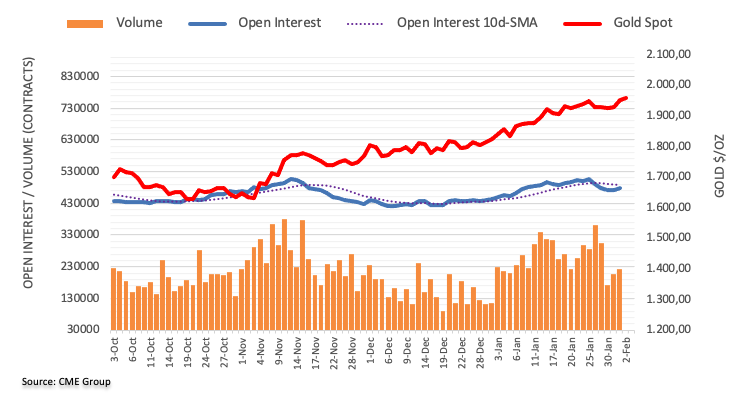
EUR/USD registered impressive gains and climbed above 1.1000 for the first time since early April. Economists at ING ntoe that there is a clear path toward the 1.12 level.
The EUR/USD story is positive
“A sharp narrowing in rate differentials stands to become a bigger driver of EUR/USD this year and should carry it to the 1.15 area in the second quarter.”
For the shorter term – there is not much resistance now until the 1.12 area. But buy-side positioning is the longest in the Euro since the summer of 2021 meaning that the rally could prove hard work. The EUR/USD story is positive, however.”
- GBP/USD surrenders its modest intraday gains, though the downside remains cushioned.
- Expectations that the Fed will cut rates later this year weigh on the USD and lend support.
- Traders also seem reluctant to place aggressive bets ahead of the key BoE policy decision.
The GBP/USD pair struggles to capitalize on its modest intraday uptick and attracts some sellers near the 1.2400 round-figure mark on Thursday. The pair retreat to the lower end of its daily range during the first half of the European session and is currently placed just above the mid-1.2300s as traders look to the Bank of England (BoE) policy decision.
The UK central bank is expected to raise interest rates for the 10th time in a row, by another 50 bps, to the highest level since autumn 2008. Investors, however, anticipate that the BoE is nearing the end of the current rate-hiking cycle amid hopes that price pressures may have peaked and looming recession risk. This, in turn, acts as a headwind for the British Pound and caps the upside for the GBP/USD pair.
That said, the downside remains cushioned, at least for now, as traders seem reluctant ahead of the key central bank event risk. Apart from this, the prevalent US Dollar selling bias might continue to lend some support to the GBP/USD pair. Worries that headwinds stemming from rising borrowing costs will lead to a sharp US economic slowdown and might force the Fed to reverse its hawkish stance continue to weigh on the buck.
Nevertheless, the aforementioned mixed fundamental backdrop warrants caution for aggressive traders and before positioning for the next leg of a directional move. From a technical perspective, a sustained strength beyond the 1.2440-1.2445 region, or a multi-month top, will be seen as a fresh trigger for the GBP/USD bulls. This, in turn, will pave the way for a move towards reclaiming the 1.2500 psychological mark.
Technical levels to watch
USD/JPY lost more than 100 pips on Wednesday and broke below 129.00. Economists at TD Securities expect the pair to target 120-125 in the next two months.
More change to YCC by the April meeting
“We expect more change to YCC by the April meeting under a new Governor, which is expected to be named next week.”
“What is clear is that Japanese investors will not be able to invest in foreign bond markets on a hedged basis as they have in the past. The cost in doing so is far too punitive. So BOJ policy, alongside with evidence of percolating inflation, will require a change in course, and one that will imply more ownership of JGBs by Japan investors instead of the BoJ.”
“We continue to see 120-125 as a target in USD/JPY in the next couple of months.”
- EUR/USD advances to fresh highs north of the 1.10000 mark.
- The pair keeps the bid tone after the FOMC rate hike on Wednesday.
- The ECB is largely anticipated to hike rates by 50 bps later in the session.
The European currency keeps the rally well in place and motivates EUR/USD to finally break above the 1.1000 mark for the first time since early April 2022.
EUR/USD remains bid ahead of the ECB
EUR/USD advances for the third consecutive session on Thursday on the back of the persistent decline in the greenback, which was particularly magnified in the wake of the FOMC event on February 1.
Indeed, the pair finally trespassed the psychological 1.1000 yardstick and climbed to fresh tops in the 1.1030/35 band earlier on Thursday. The uptick, however, faced some selling pressure and forced spot to recede to the 1.1000 region, where it attempted to consolidate.
Later in the session, all the attention will be on the ECB monetary policy meeting, where consensus among investors already priced in a 50 bps rate raise. Of note, in addition, will be the press conference by Chairwoman Lagarde, where investors are expected to closely follow any view of the potential next steps by the central bank in a context still dominated by high inflation, alleviated concerns regarding the energy crunch and now diminishing recession fears.
Earlier on Thursday, Germany’s trade surplus shrank a tad to €10B in December. In the US, Initial Claims are due in the first turn seconded by Factory Orders.
What to look for around EUR
The pronounced upside pushed EUR/USD north of the key 1.1000 hurdle on Thursday, as the weakness around the dollar remains the exclusive driver behind the unabated rally in the pair.
In the meantime, price action around the European currency should continue to closely follow dollar dynamics, as well as the potential next moves from the ECB.
Back to the euro area, recession concerns now appear to have dwindled, which at the same time remain an important driver sustaining the ongoing recovery in the single currency as well as the hawkish narrative from the ECB.
Key events in the euro area this week: Germany Balance of Trade, ECB Interest Rate Decision, ECB Lagarde (Thursday) - Germany, EMU Final Services PMI (Friday).
Eminent issues on the back boiler: Continuation of the ECB hiking cycle amidst dwindling bets for a recession in the region and still elevated inflation. Impact of the Russia-Ukraine war on the growth prospects and inflation outlook in the region. Risks of inflation becoming entrenched.
EUR/USD levels to watch
So far, the pair is gaining 0.15% at 1.1000 and faces the next up barrier at 1.1032 (2023 high February 2) followed by 1.1100 (round level) and finally 1.1184 (weekly low March 31 2022). On the other hand, the breakdown of 1.0802 (weekly low January 31) would target 1.0766 (weekly low January 17) en route to 1.0639 (55-day SMA).
The ECB prepared the market well for today’s rate meeting. Esther Reichelt, FX Analyst at Commerzbank, notes that the Euro is well positioned to strengthen against the US Dollar.
Euro goes well prepared into the ECB meeting
“A 50 bps rate hike is seen as a fait accompli. It is therefore likely to be decisive for the Euro what ECB President Christine Lagarde has to say about the March decision and the rate path beyond that. If Lagarde signals that a further 50 bps rate is not set in stone I think the Euro will get under selling pressure.”
“As long as no reversal becomes obvious in core inflation the market is likely to price in an increased risk premium of inflation not easing towards its target as expected. Against this background, the ECB’s current approach – of sticking to ‘larger’ rate step for now and not committing beyond that – is appropriate from the FX market’s point of view which supports the Euro.”
“An end of the monetary policy tightening seems more certain for the Fed than for the ECB. That does not necessarily mean that the EUR will appreciate significantly from here. However, the risk of the ECB having to top up its measures further because upside risks for inflation emerge, thus supporting the Euro, are currently likely to be considered higher than further appreciation potential for the USD.”
See – ECB Preview: Forecasts from 14 major banks, another 50 bps hike
Further gains in GBP/USD target the 1.2450 region in the near term, suggest Economist Lee Sue Ann and Markets Strategist Quek Ser Leang at UOB Group.
Key Quotes
24-hour view: “We expected GBP to weaken yesterday but we were of the view that ‘the major support at 1.2250 is unlikely to come under threat’. GBP dropped briefly to 1.2275 in NY trade before rebounding strongly to close at 1.2375 (+0.47%). The advance has room to extend but a sustained rise above 1.2450 appears unlikely. Support is at 1.2360, followed by 1.2330.”
Next 1-3 weeks: “Our most recent narrative was from Tuesday (31 Jan, spot at 1.2350) where we indicated that GBP has likely moved into a consolidation phase and is likely to trade between 1.2250 and 1.2430 for the time being. GBP soared to a high of 1.2395 in NY trade and upward momentum is beginning to build. However, GBP must break and stay above 1.2450 before a sustained advance is likely. The next resistance level above 1.2450 is at 1.2510. The odds of GBP breaking clearly above 1.2450 would increase as long as GBP stays above the ‘strong support’ level, currently at 1.2300.”
- USD/CAD drops to its lowest level since November amid the prevalent USD selling bias.
- Expectations that the Fed will cut interest rates later this year weigh on the Greenback.
- The overnight slump in oil prices undermines the Loonie and might help limit the slide.
The USD/CAD pair remains under some selling pressure for the third successive day on Thursday and drops to its lowest level since November 16 during the first half of the European session. The pair currently trades around the 1.3265 region and seems vulnerable to prolong its downward trajectory amid sustained US Dollar weakness.
In fact, the USD Index, which tracks the Greenback against a basket of currencies, hits a fresh nine-month low and is pressured by a less-hawkish Fed. As was widely expected, the US central bank decided to raise the policy rate by 25 bps and reiterated its commitment to keep hiking interest rates high to cool price pressures. Comments from the Fed Chairman Jerome Powell at the press conference afterwards, however, suggesting there were signs interest rates were having a "disnflationary" effect, flipped the narrative, weighing on the buck and acting as a headwind for the USD/CAD pair.
From CAD's perspective, the overnight slump in crude oil prices - to a three-week low - undermines the commodity-linked Loonie and lends some support to the USD/CAD pair. Apart from this, the cautious market mood, along with a modest uptick in the US Treasury bond yields, helps limit losses for the Greenback. This, in turn, is holding back bearish traders from placing fresh bets around the major, though acceptance below the 1.3300 mark supports prospects for a further depreciating move. Hence, a subsequent fall to November 2022 low, around the 1.3230-1.3225 area, looks like a distinct possibility.
Market participants now look to the release of the Weekly Initial Jobless Claims from the US, due later during the early North American session. The data might influence the USD, which, along with Crude Oil price dynamics, should provide some impetus to the USD/CAD pair. The focus, however, will remain glued to the closely-watched US monthly jobs report - popularly known as NFP on Friday.
Technical levels to watch
GBP/USD snapped a three-day losing streak on Wednesday. Economists at ING believe that the pair could race higher toward the 1.2450/2500 region.
EUR/GBP could push up to the 0.90/91 area later in the year
“Benign global conditions are supportive for the risk-sensitive Sterling and suggest GBP/USD could make a run at the 1.2450/2500 area this week.”
“EUR/GBP has drifted higher again. On balance, we would favour continued outperformance given the greater scope for convergence in Eurozone and Sterling rates at the shorter end of the curve.”
“EUR/GBP may end the quarter near 0.89, but push up to the 0.90/91 area later in the year.”
The European Central Bank (ECB) is set to announce its decision on monetary policy on Thursday, February 2 at 13:15 GMT and as we get closer to the release time, here are the expectations as forecast by the economists and researchers of 14 major banks.
Markets expect the announcement of a 50 bps hike in all key interest rates. Beyond the 50 bps hike, the ECB is expected to deliver detailed parameters for the reduction of the Assets Purchase Program (APP).
Danske Bank
“Another 50 bps rate hike has been well telegraphed and fully priced by markets. We expect the ECB to continue to sound very hawkish and signal that further rate hikes are coming, in particular giving guidance for another 50 bps hike in March. We expect Lagarde to give a strong reminder to markets to tighten financial conditions. On balance, a firm hawkish message from the ECB should contribute to a stronger EUR upon announcement.”
Nordea
“We expect the ECB to raise rates by 50 bps and confirm that another such step in March remains a reasonable baseline. We think the overall message continues to be hawkish, though there are also risks of a slightly softer tone.”
SocGen
“We expect the ECB to hike rates by another 50 bps and again in March before moving to 25 bps hikes, taking the terminal rate to 3.75% by July when the risks may become more symmetric. We also expect the APP QT to pick up pace slightly by the end of this year and full PEPP reinvestments to end by mid-2024. Detailed parameters for QT have been promised for this meeting, possibly including specific amounts for the run-down of individual programmes and guidelines on how flexible the ECB can be. We do not expect any major deviations from the capital keys or maturity structures other than some discretionary allowance to average flows over time.”
Commerzbank
“The ECB will raise interest rates by another 50 bps. But meanwhile, the doves – who dominate the Governing Council more than ever, according to our ‘Hawkometer’ – are already positioning themselves. At the May meeting, they are likely to push through a slower pace of rate hikes and then end the rate hike cycle at a deposit rate of 3.25%.”
Nordea
“Another 50 bps move should be done deal, and we expect the general tone to remain hawkish. However, given the recent falls in energy prices and the absence of new forecasts, there are also risks that the tone could become more dovish.”
TDS
“We expect the ECB to hike rates by 50 bps and maintain its hawkish tone, with President Lagarde repeating recent statements about markets needing to reprice higher still. A ‘sleepy’ ECB meeting probably won't do much for the EUR at these levels. Barring CHF, EUR trades at a premium to SEK, NOK, GBP, and USD on top-down macro models. In turn, the risk-reward argues to wait for a EUR/USD pullback towards the 1.06 area to open up buying opportunities, and we prefer EUR/CHF longs into the meeting.”
Rabobank
“A 50 bps hike is well-telegraphed, but the ECB may want to give less guidance about its next move than it did in December. This adds downside risks to money markets that are priced for a 50 bps hike in March as well. We still expect the ECB can scale back to 25 bps hikes from March, but the stronger outlook and wage pressures could delay this and pose upside risks.”
Nomura
“A half-point hike looks very likely. On quantitative tightening, we expect the ECB to outline specifics with respect to the portion of APP portfolio redemptions to be reinvested. In particular, we expect the ECB to allow itself the same flexibility with respect to reinvestments as it has done with the PEPP. Finally, we expect another hawkish press conference, particularly if the ECB is unhappy with the way markets are likely to respond to a potentially weaker January inflation print. That should (i) recalibrate market expectations on near-term rate hikes and (ii) put an end to market pricing of rate cuts during 2023.”
Wells Fargo
“We believe the ECB will deliver a 50 bps rate hike. The message is likely to be that while headline inflation is receding, core inflation is still uncomfortably high and has not shown meaningful signs of rolling over just yet. We also believe that the ECB will communicate that a similar degree of tightening will be required at the next meeting to make sure inflation expectations do not spiral. President Lagarde is also likely to note that subsequent decisions will be data-dependent, which means a terminal rate of 3.25% by Q2-2023.”
Crédit Agricole
“Not only do we expect another 50 bps hike at the February meeting, but we also expect an implicit commitment for at least another 100 bps of hikes to come: long is the road, but deep is the ECB’s faith. The main focus of the meeting is likely to be the future path of rate hikes: February’s hike seems to be a done deal – 50 bps – consequently the question is rather what the ECB will do in March and May. We expect a confirmation of the hawkish tone delivered in December – and consequently a repricing of markets.”
ING
“All eyes and ears will once again be on communication. A rate hike of 50 bps looks like a done deal, but how far and how fast the ECB will go from there is still unclear. We expect hawkish comments by ECB President Christine Lagarde in order to prevent another drop in market interest rates. Current market expectations about ECB rate cuts in 2024 are premature.”
Citibank
“The fall in gas prices is interpreted by many as an indication that inflation in Europe was transitory after all. But it is also often interpreted to mean that the ECB will quickly depart from the ‘steady pace’ of rate hikes it promised in December. We disagree and expect the ECB to stick to 50 bps hikes at the next two meetings.”
Deutsche Bank
“We expect another 50 bps hike that would take the deposit rate to 2.50%. We also emphasise the importance of communicating expectations for the March meeting since core and underlying inflation remain sticky. We see further 50 bps and 25 bps hikes in March and May, respectively, and a terminal rate of 3.25%.”
NAB
“We see the ECB hiking rates by another 50 bps taking the Deposit Rate to 2.5% with another hike likely to be signalled for the 23 March meeting.”
USD/INR pair has rebounded after dropping to near 81.65. Economists at Commerzbank expect the pair to move back lower toward the 80 level.
RBI to hike rates further next week
“We expect RBI to hike rates further next week, albeit by a slower pace of 25 bps to 6.50%. This follows the aggressive hikes last year of a total of 225 bps.
“RBI could continue to signal further hikes, albeit more gradually, but it could still provide some support for INR.”
“We could see USD/INR drift back to the lower end of the 80-82 range near term, helped along by the softer USD.”
- Silver scales higher for the third successive day and touches a fresh weekly high on Thursday.
- The formation of a rectangle on the daily chart warrants caution before placing directional bets.
- The technical setup, however, favours bulls and supports prospects for an eventual breakout.
Silver builds on this week's move up from sub-$23.00 levels and gains some follow-through traction for the third successive day on Thursday. The white metal steadily climbs to $24.30 horizontal resistance during the early European session and moves well within the striking distance of the multi-month top touched in January.
Looking at the broader picture, the XAG/USD has been oscillating in a familiar trading range over the past one-and-half month or so. The price action, meanwhile, constitutes the formation of a rectangle on the daily chart and points to indecision among traders. This, in turn, warrants caution for aggressive traders and before positioning for a firm near-term direction.
That said, positive technical indicators on the daily chart favour bulls and support prospects for an eventual breakout to the upside. A sustained strength beyond the trading range resistance, around the $24.50-$24.55 region, will reaffirm the constructive outlook. The XAG/USD might then aim to reclaim the $25.00 psychological mark for the first time since April 2022.
Some follow-through buying has the potential to lift the XAG/USD towards the next relevant hurdle near the $25.35 region en route to the $26.00 round figure.
On the flip side, the $24.00 mark now seems to protect the immediate downside. Any subsequent pullback might continue to attract some buyers near the $23.50-$23.45 region, below which the XAG/USD could slide to the $23.00 level. This is followed by support near the $22.75 region, which if broken decisively will expose the next relevant support near the $22.20-$22.15 zone.
Silver daily chart
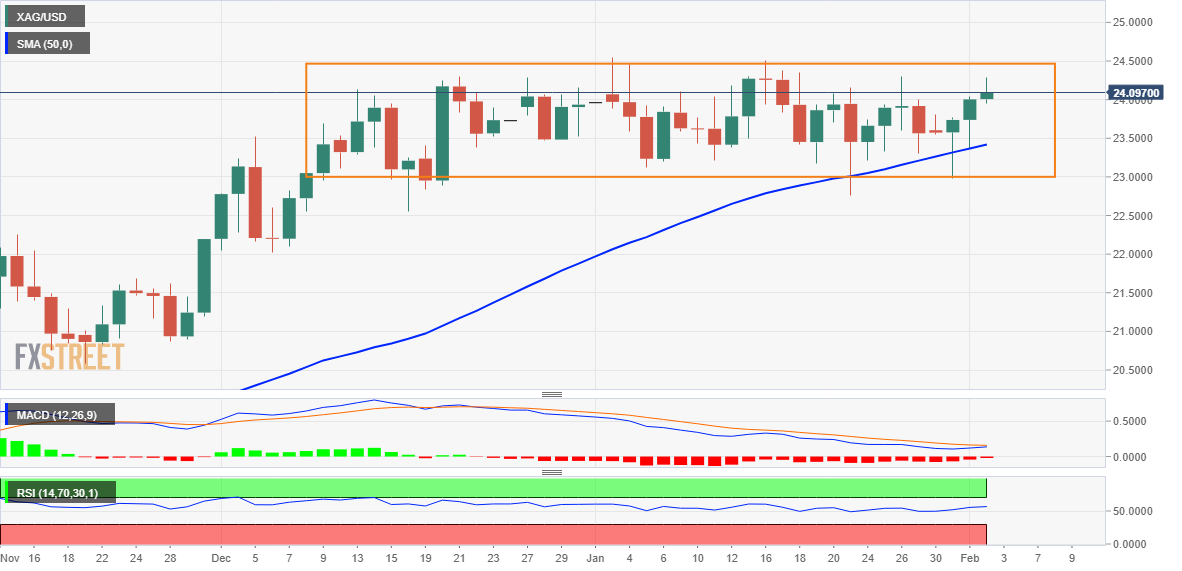
Key levels to watch
The Federal Reserve raised the policy rate by 25 basis points to the range of 4.5-4.75% as expected. The US Dollar came under heavy selling pressure but economists at Danske Bank still expect a lower EUR/USD as the base case remains for Fed to hike rates to 5% by May.
Powell sees a higher chance of a soft landing
“Fed hiked rates by 25 bps as widely expected. Powell saw probability of soft landing increasing, as inflation has eased without the economy slowing markedly. “
“The persistently tight labour and the turnaround in global manufacturing cycle leave Fed little room to turn more dovish. We still expect 2x25 bps hikes in the March and May meetings.”
“Markets reacted dovishly, with USD selling off and UST yields falling. We stick to our forecast of lower EUR/USD at 1.07 in 3M.”
The Bank of England (BoE) will announce its interest rate decision on Thursday, February 2 at 12:00 GMT, publishing the Minutes of the meeting and Monetary Policy Report (MPR) alongside. As we get closer to the release time, here are the expectations forecast by the economists and researchers of nine major banks.
The BoE is set to raise rates by 50 basis points (bps) in February from 3.50% to 4.0%. The vote split, forecasts and Governor Bailey’s press conference will steal the show.
Danske Bank
“We expect the BoE to hike the Bank Rate by 50 bps. We pencil in an additional 25 bps hike in March, now expecting the Policy Rate to peak at 4.25% in March 2023. Dovish communication from BoE should send EUR/GBP higher during the day.”
TDS
“We expect the MPC to hike 50 bps at this meeting, but signal a downshift in the pace of rate hikes as terminal approaches. The vote is likely to be skewed to the downside even more than in December. While we view GBP/USD as a clear expression of risk sentiment and global growth, EUR/GBP likely captures some variation of local dynamics between the two currencies. With the shift in terminal rate pricing (and relative growth expectations) likely to favor the EUR, we continue to expect a break of 0.90 in EUR/GBP in the months ahead.”
Rabobank
“We expect the BoE to start off 2023 with a 50 bps rate increase. It would lift the Bank rate to 4.00%. The vote is again likely to be split in a net dovish way. We still expect the central bank to raise rates to 4.75% by mid-2023, as it seeks to pull out the roots of inflation, but the window for larger 50 bps increments closes soon. The risk remains that very restrictive settings prove too effective in slowing the economy. This would present itself in an even deeper curve inversion. We only expect the first cuts by 2024.”
Nomura
“We expect the BoE to raise rates by 50 bps, which we think will be the final half-point move (reverting to 25 bps in March to reach a peak rate of 4.25%). It is a Monetary Policy Report meeting and the Bank will publish new forecasts – expect a lower near-term inflation profile due to falling energy prices but possibly a higher end-point than the zero rate published in November. We expect the Bank to forecast a less pernicious recession than the near-3% decline in GDP it expected at its last forecast round. These forecasts may be significantly influenced by the Bank’s annual review of the economy’s supply potential.”
SocGen
“We maintain our forecast of a 50 bps increase followed by a final 50 bps increase at the March meeting to a peak of 4.5%.”
Wells Fargo
“With recession on the horizon, we believe the BoE will take a more gradual approach to rate hikes. As of now, financial markets are priced for a 50 bps hike and our peer economists forecast the BoE to lift policy rates by 50 bps as well. However, we believe policymakers will take a more measured approach and lift rates by only 25 bps as they are now more focused on protecting against a prolonged recession. Following this meeting, another 25 bps hike in Q1 is likely, and at the March meeting, we believe policymakers will signal an end to their tightening cycle.”
ING
“We expect a 50 bps rate hike for the second consecutive meeting. Still, if we get a 50 bps hike on Thursday then it’s likely to be the last. BoE officials have suggested that much of the impact of last year’s rate hikes are still to show through, and cracks are forming in interest-rate-sensitive parts of the economy. We expect one final 25 bps hike in March, taking the Bank Rate to a peak of 4.25%. The key question for Thursday is whether the Bank itself acknowledges its work is nearly complete. We suspect it’s more likely to keep its options open.”
Citibank
“While there is a strong case for the MPC to hike by only 25 bps, a 50 bps move still feels more likely. With demand now likely stronger, and domestic price pressures still intense, we expect the ‘balance of fear’ to therefore lean towards doing more sooner, with a deceleration to 25 bps likely in March.”
Deutsche Bank
“We see another 50 bps hike that will take the Bank Rate to 4%. That will potentially be the last 'forceful' hike in this tightening cycle. Although our view is that services and wages data warrant such a move, the risks are tilted to the downside. We continue to call for a 4.5% terminal rate as inflation pressures remain resilient.”
- EUR/GBP scales higher for the fourth straight day and touches a fresh multi-month top.
- Expectations for additional jumbo rate hikes by the ECB continue to underpin the Euro.
- Speculations that the BoE is nearing the end of the rate-hiking cycle weigh on the GBP.
- Traders now seem reluctant as the focus shifts to the BoE and the ECB policy decisions.
The EUR/GBP cross gains traction for the fourth successive day and climbs to the 0.8900 neighbourhood or its highest level since late September on Thursday.
The shared currency continues to draw support from expectations for additional jumbo rate hikes by the European Central Bank (ECB) in the coming months. The bets were reaffirmed by the recent hawkish commentary by several ECB officials, which, in turn, acts as a tailwind for the EUR/GBP cross. The British Pound's relative underperformance could further be attributed to speculations that the Bank of England (BoE) is nearing the end of the current rate-hiking cycle.
That said, the prevalent US Dollar selling bias lends some support to the Sterling Pound. Furthermore, signs of inflationary pressures in the Eurozone might have forced investors to scale back expectations for a more aggressive policy tightening by the ECB. This, along with reluctance ahead of the key central bank event risk, keeps a lid on any further gains for the EUR/GBP cross. This warrants some caution before positioning for an extension of the ongoing move-up.
Both the BoE and the ECB are scheduled to announce their policy decisions during the mid-European session this Thursday. The market focus, however, will be on clues about the future rate hike path, which will determine the next leg of a directional move for the EUR/GBP cross. Nevertheless, the fundamental backdrop favours bullish traders, though a sustained move beyond the 0.8900 round-figure mark is needed to support prospects for a further near-term appreciating move.
Technical levels to watch
Here is what you need to know on Thursday, February 2:
The US Dollar Index stays on the back foot and trades at its lowest level in nearly 10 months at around 101.00 following Wednesday's sharp decline that was triggered by FOMC Chairman Jerome Powell's dovish remarks. The Bank of England (BOE) and the European Central Bank (ECB) will announce the policy decisions on Thursday. BOE Governor Andrew Bailey and ECB President Christine Lagarde will comment on the policy outlook and respond to questions from the press after the publication of official statements. Later in the day, the US economic docket will feature the weekly Initial Jobless Claims and the Unit Labor Costs data for the fourth quarter.
The Federal Reserve raised the policy rate by 25 basis points to the range of 4.5-4.75% as expected. In the policy statement, the US central bank said that inflation 'has eased somewhat but remains elevated' and repeated that the Committee anticipates that ongoing increases in the target range will be appropriate. Although the initial reaction helped the US Dollar gather strength against its rivals, the currency came under heavy selling pressure during Chairman Powell's press conference.
Powell, once again, tried to convince markets that there will not be a rate cut in 2023 but acknowledged that the disinflationary process has started. The Chairman also said that if inflation comes down faster than expected, that would play into policy. In turn, Wall Street's main indexes gained traction, the benchmark 10-year US Treasury bond yield declined sharply and the US Dollar suffered large losses.
Fueled by the broad US Dollar weakness, EUR/USD registered impressive gains and climbed above 1.1000 for the first time since early April. The ECB is widely expected to raise its key rate by 50 basis points following the first policy meeting of 2023. Lagarde delivered surprisingly hawkish comments in December and market participants will look for confirmation of the ECB's willingness to continue to raise rates to fight inflation.
European Central Bank Preview: Lagarde needs to repeat her hawkish message.
GBP/USD snapped a three-day losing streak on Wednesday and gained more than 50 pips. The pair stays in a consolidation phase slightly below 1.2400 early Thursday. The BOE is also forecast to opt for a 50 bps hike but investors refrain from betting on further Pound Sterling for now amid the possibility of the BOE pointing to an end to the tightening cycle on worsening growth outlook.
BoE Interest Rate Decision Preview: The last 50 bps hike but not the end yet.
USD/JPY lost more than 100 pips on Wednesday and broke below 129.00. Bank of Japan (BoJ) Deputy Governor Masazumi Wakatabe said early Thursday that the BoJ must not be complacent as downward price pressures remains farily strong. Following these comments, the pair stays relatively quiet slightly above 128.50.
Gold price capitalized on slumping US Treasury bond yields and surged to its strongest level since April near $1,960 before retreating toward $1,950.
Bitcoin surged to its highest level since August above $24,200 late Wednesday but struggled to preserve its bullish momentum. BTC/USD was last seen moving sideways at around $23,800. Ethereum gained nearly 4% on Wednesday and continued to push higher early Thursday. At the time of press, ETH/USD was up 1.6% on a daily basis at $1,670.
Gold price is sitting at the best levels seen in the last ten months above $1,950. XAU/USD needs to take out $1,960 resistance for further upside, FXStreet’s Dhwani Mehta reports.
Tide seems to have turned in favor of Gold buyers once again
“The 14-day Relative Strength Index (RSI) is probing the overbought territory, suggesting that further upside remains in place for the bright metal.”
“Gold price needs to find acceptance above the immediate resistance near the $1,960 level in order to initiate a sustained uptrend toward the April 2022 high just shy of the $2,000 mark.”
“Any pullbacks from higher levels could see the XAU/USD challenging the previous week’s high at $1,949, below which a fresh correction toward the $1,920 region cannot be ruled.”
- WTI fades bounce off intraday low as sellers poke ascending support line from early December 2022.
- Downbeat MACD signals favor sellers but RSI conditions suggest limited room towards the south.
- Multiple EMAs, weekly resistance line highlight $79.30 as the key upside hurdle.
WTI crude oil holds lower ground near $77.00 as it retreats from its intraday high during early Thursday morning in Europe. In doing so, the black gold fades the late Monday’s corrective bounce off a three-week low.
The quote’s latest weakness takes clues from the bearish MACD signals and sustained trading below the key Exponential Moving Averages (EMAs).
However, an upward-sloping support line from early December 2022, close to $76.70 by the press time, challenges the WTI bears. On the same line could be the nearly oversold RSI (14).
It’s worth noting that a clear downside break of the aforementioned support line could quickly drag the quote toward two-month-old horizontal support near $73.00.
In a case where the Oil price remains bearish past $73.00, the late 2022 bottom surrounding $70.30 and the $70.00 psychological magnet will gain the market’s attention.
Meanwhile, the energy benchmark’s recovery moves remain elusive unless crossing the $79.30 resistance confluence, comprising the 100-EMA, 50-EMA and a one-week-old descending trend line.
Even if the WTI price crosses the $79.30 hurdle, the $80.00 round figure could act as a validation point for the rally targeting the previous monthly high near $82.70.
WTI: Four-hour chart
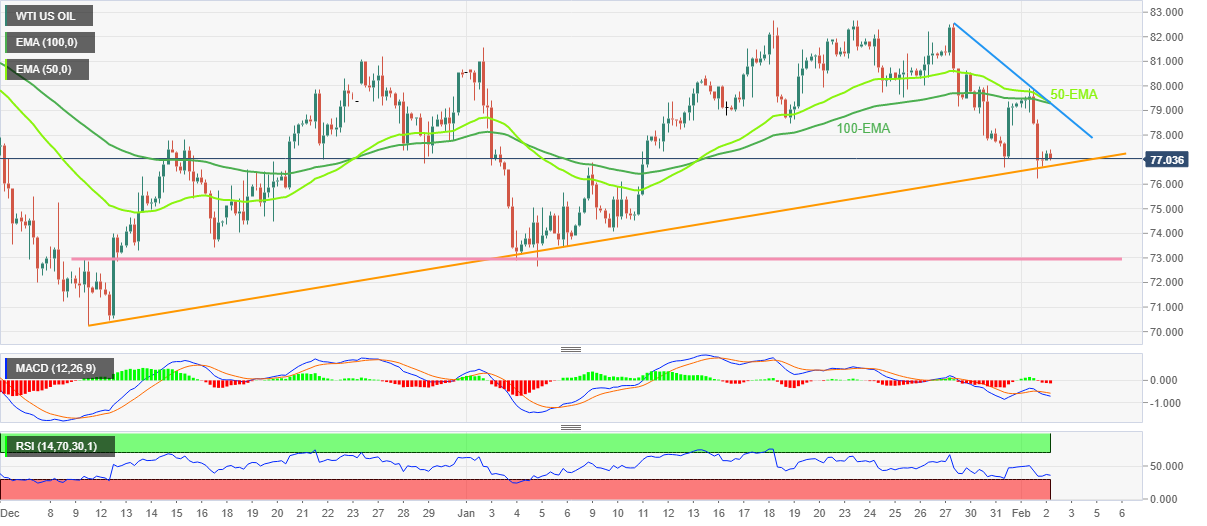
Trend: Limited downside expected
- The index drops to 10-month lows near 100.80.
- The dollar remains on the defensive post-FOMC event.
- Initial Claims, Factory Orders next of note in the docket.
The greenback, in terms of the USD Index (DXY), adds to the weekly leg lower and breaks below the 101.00 support to print new 10-month lows on Thursday.
USD Index: A visit to 100.00 appears on the horizon
The index retreats for the third session in a row and maintains the 2-week negative streak well in place on the back of further deterioration of the price action around the dollar, especially following the FOMC event on February 1.
Indeed, the dollar keeps losing ground as market participants continue to assess the recent decision by the Fed to raise rates by 25 bps, the smallest hike since the beginning of the tightening cycle almost a year ago.
Both the Fed’s statement and Powell’s press conference acknowledged that inflation seems to have lost some traction albeit it remains elevated, suggesting that the ongoing increasing rates remain appropriate and opening the door to a new “normal” at 25 bps.
Later in the NA session, usual weekly Claims are due seconded by Factory Orders. Of note, in addition, will be the interest rate decisions by the ECB and the BoE, where a 50 bps rate hike appears already priced in in both events.
What to look for around USD
The dollar retreats further and breaks below the 101.00 support to record new multi-month lows amidst increasing selling pressure in the wake of the FOMC event on Wednesday.
The idea of a probable pivot/impasse in the Fed’s normalization process continues to hover around the greenback and keeps the price action around the DXY subdued for the time being. This view has been reinforced after the Fed hiked rates by 25 bps on February 1, while speculation of the terminal rate now below 5% gathered some traction as well.
Key events in the US this week: Initial Jobless Claims, Factory Orders (Thursday) – Nonfarm Payrolls, Unemployment Rate, Final Services PMI ISM Non-Manufacturing (Friday).
Eminent issues on the back boiler: Rising conviction of a soft landing of the US economy. Prospects for extra rate hikes by the Federal Reserve vs. speculation of a recession in the next months. Fed’s pivot. Geopolitical effervescence vs. Russia and China. US-China trade conflict.
USD Index relevant levels
Now, the index is retreating 0.19% at 100.97 and the breach of 100.82 (2023 low February 2) would open the door to 100.00 (psychological level) and finally 99.81 (weekly low April 21 2022). On the upside, the immediate hurdle comes at the weekly high at 102.60 (weekly high January 31) seconded by 102.89 (January 18) and then 104.02 (55-day SMA).
NZD/USD retreats from the eight-month high as bulls take a breather ahead of the second round of central bank dossier during early Thursday.
In doing so, the Kiwi pair keeps the Federal Reserve (Fed) inspired gains around 0.6530 by the press time.
That said, the Fed’s dovish rate hike triggered the strongest bullish options market sign for the NZD/USD traders.
A one-month risk reversal (RR) of the NZD/USD pair, a ratio of call options versus put options, prints a +0.080 figure at the latest. With this, the Daily RR prints not only snap a two-day winning streak but also mark the highest level in three weeks.
It’s worth noting, however, that the weekly RR still remains negative, suggesting the bear’s dominance, for the third time in a row as it prints -0.165 figure at the latest.
Also read: NZD/USD struggles to surpass 0.6530, upside remains favored ahead of US NFP
- Gold price is facing barricades in extending range towards the north as USD Index is attempting a cushion around 100.50.
- Analysts at the National Bank of Canada anticipate a policy change by the FOMC in the first quarter of 2023.
- Going forward, the US NFP data will be of utmost importance.
Gold price (XAU/USD) is displaying back-and-forth moves in the early London session after a breathtaking rally above the crucial resistance of $1,950.00. The precious metal has turned sideways as the US Dollar Index (DXY) is building a cushion around 100.50. The upside bias is still favored as a smaller interest rate hike by the Federal Reserve (Fed) has pushed the USD Index into a negative trajectory.
Economists at the National Bank of Canada believe “It would be a mistake for the Fed to persist in raising its key rate well beyond the current level and holding it there for an extended period if inflation continues to surprise on the downside.” Therefore a policy change from the FOMC in the first quarter of 2023 is anticipated, which would set the stage for a more prolonged decline.
Meanwhile, S&P500 futures are holding their morning gains confidently, portraying that the risk appetite theme is extremely solid. However, the 10-year US Treasury yields have scaled firmly above 3.42%.
After the Fed’s policy-inspired volatility, investors are shifting their focus toward the release of the United States Nonfarm Payrolls (NFP) (Jan) data, which will release on Friday. As per the consensus, the US economy has added fresh 185K jobs in January vs. the prior addition of 223K. The Unemployment Rate is seen higher at 3.6%. Also, the Average Hourly Earnings are expected to accelerate to 4.9% from the former release of 4.6%.
Gold technical analysis
The formation of selling wicks by the Gold price after surpassing January 26 high at $1,949.26 is hinting at the presence of significant offers at elevated levels. It looks like the Gold bulls lack strength for a fresh upside. The 20-period Exponential Moving Average (EMA) at $1,945.00 is still aiming higher, which indicates that the upside trend has not halted yet.
Also, the Relative Strength Index (RSI) is showing signs of an overbought situation, which could result in a minor correction ahead.
Gold hourly chart
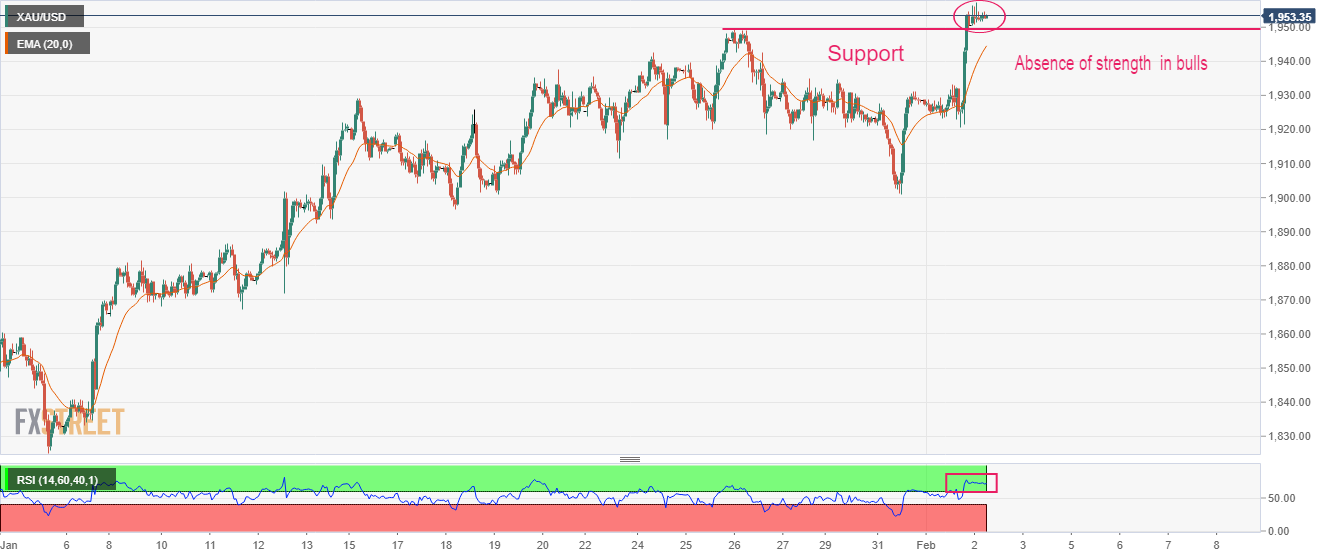
- USD/JPY prints three-day losing streak despite recent bounce off weekly low.
- BoJ’s Wakatabe appears determined to tame inflation, praises YCC move.
- US 10-year Treasury bond yields dribble around two-week low.
- Second-tier US data, other central bank announcements can please Yen bears before Friday’s US NFP
USD/JPY pares intraday losses around 128.60 during the three-day downtrend as the market slips into consolidation mode ahead of the second round of central bank dossier amid early Thursday.
The Yen pair dropped to its lowest levels in two weeks earlier in the day while extending the Federal Reserve (Fed) induced losses amid downbeat Treasury bond yields. That said, the US 10-year Treasury yields slumped the most in two weeks while testing the lowest levels in a fortnight the previous day after the US Federal Reserve (Fed) announced its dovish hike of 0.25%. The US central bank unveiled receding fears of inflation and Chairman Jerome Powell showed readiness for cutting the rates if inflation drops faster, which in turn drowned the US Dollar and yields. The same propelled the risk-on mood and favored Wall Street bulls.
On the other hand, hawkish comments from Bank of Japan (BoJ) officials also favored the GBP/JPY bears. That said, Bank of Japan's Deputy Governor Masazumi Wakatabe has said the BoJ will continue to conduct monetary policy to achieve 2% inflation accompanied by wage growth. The Japanese central bank has recently conducted multiple bond market moves to defend the Yields Curve Control (YCC) policy. BoJ’s Wakatabe was recently heard praising the YCC move of the BoJ.
It should be noted, however, that the comments from BoJ’s Wakatabe also ruled out the market’s fears of any immediate move, which in turn allowed USD/JPY to lick the Fed-inflicted wounds.
Amid these plays, the S&P 500 Futures print mild gains while Japan’s Nikkei 225 follows the suit as traders await another round of central bank announcements, this time from the European Central Bank (ECB) and the Bank of England (BoE).
In addition to the central bank news, US Factory Orders for December, expected 2.3% versus -1.8% prior, and the US Preliminary Nonfarm Productivity for the fourth quarter (Q4), expected 2.4% versus 0.8% prior. Above all, Friday’s US jobs report for January will be crucial to follow for clear directions.
Technical analysis
The successful downside break of the 13-day-old ascending trend line, around 129.40 by the press time, directs USD/JPY bears towards the previous monthly low of near 127.20.
In the opinion of Economist Lee Sue Ann and Markets Strategist Quek Ser Leang at UOB Group, further upside could now lift EUR/USD to the 1.1120 region in the next few weeks.
Key Quotes
24-hour view: “EUR lifted off during NY trade and surged to a high of 1.1000 before extending its gains in early Asian hours. While the rapid and outsized surge appears to be overdone, the advance is not showing signs of slowing just yet. In other words, further EUR strength is not ruled out. That said, the major resistance at 1.1120 is unlikely to come into view today (there is another resistance at 1.1055). Support is at 1.0975, a break of 1.0940 would indicate that the current strong upward pressure has eased.”
Next 1-3weeks: “We noted on Monday (30 January, spot at 1.0870) that the EUR appears to have entered a consolidation phase and that it is likely to trade between 1.0800 and 1.0930 for the time being. Yesterday, EUR took off and blasted above 1.0930. The consolidation phase has ended quickly and EUR is likely to head higher toward 1.1120. On the downside, a break of 1.0900 (‘strong support’ level) would indicate that USD is not ready to head higher to 1.1120.”
- GBP/USD is aiming to shift its business above 1.2400 as the USD Index is struggling to build a cushion.
- Federal Reserve has cited hawkish policy guidance despite evidence of inflation softening.
- Bank of England is set to push interest rates to 4% in its battle against the double-digit inflation figure.
- GBP/USD is on the verge of delivering a breakout of the Descending Triangle chart pattern amid a risk-on mood.
GBP/USD has rebounded firmly after a minor corrective move to near 1.2370 in the early European session. The cable is aiming to surpass the immediate resistance of 1.2400 as the US Dollar Index (DXY) has retreated after a pullback move to near 100.60. The USD Index has resumed its downside journey and has refreshed its nine-month low to near 100.48.
The announcement of a less-hawkish monetary policy by the Federal Reserve (Fed) has strengthened the demand for risk-sensitive assets. The improved risk appetite of the market participants has supported the S&P500 futures in range extension towards the upside. Investors have shrugged off pessimism generated by weak United States ISM Manufacturing PMI and have cheered a smaller interest rate hike by the Federal Reserve (Fed). Despite the extremely positive market sentiment, the return generated by 10-year US Treasury bonds has rebounded to near 3.42%.
Federal Reserve confirms the initiation of a disinflationary process
Plenty of evidence is available that claims that the United States Consumer Price Index (CPI) is confidently declining led by the sheer policy tightening by the Federal Reserve. After observing a slowdown in consumer spending, lower prices of goods and services by factory owners, a fresh decline in labor cost, and three consecutive contractions in the ISM Manufacturing PMI, one could not deny the fact that inflation softening is progressive.
Meanwhile, Federal Reserve chair Jerome Powell in his commentary on Wednesday while dictating the monetary policy confirmed that the disinflationary process has started now. The Fed hiked interest rates by 25 basis points (bps) to 4.50-4.75% and kept the room open for further hikes as it believes that monetary policy is still not sufficiently restrictive to drag inflation to the 2% target.
US Labor demand exceeds the supply
The Employment data released on Wednesday before the interest rate decision by the Federal Reserve (Fed) surprised the market participants significantly. Automatic Data Processing (Jan) (ADP) agency reported that the United States economy has added 106K fresh talent into the labor market, which was critically lower than the consensus of 178K and the former release of 253K. Contrary to that, Job Openings (Dec) data reported an increment of 572K. Although the economic data is from different months, it still indicates that the labor demand by corporate is exceeding the supply.
For more clarity, investors will keenly focus on the United States Nonfarm Payrolls (NFP) data, which will release on Friday. As per the consensus, the US economy has added 185K jobs in the labor market higher than the prior release of 223K. The Unemployment Rate is seen higher at 3.6% vs. 3.5% released earlier but still near the lowest figures in the past half-century. Apart from that, Average Hourly Earnings data will be of utmost importance.
Bank of England to deliver a hawkish stance on interest rates
Inflationary pressures in the United Kingdom region have not been trimmed decisively as lower energy prices have been offset by higher food prices and rising employment bills. Insufficient labor supply is continuously winning negotiations with recruiters and is leading to stability in the price index at peak levels. The inflation rate is still in the double-digit figure and higher interest rates by the Bank of England (BoE) have impacted the extent of economic activities dramatically but the inflationary pressures are still outside the grip of the Bank of England policymakers.
Strategists at Jefferies cited “We are negative on the UK.” For the BoE, even if we get a 50 basis point (bps) hike in February, it would be a dovish 50 basis points.”
GBP/USD technical outlook
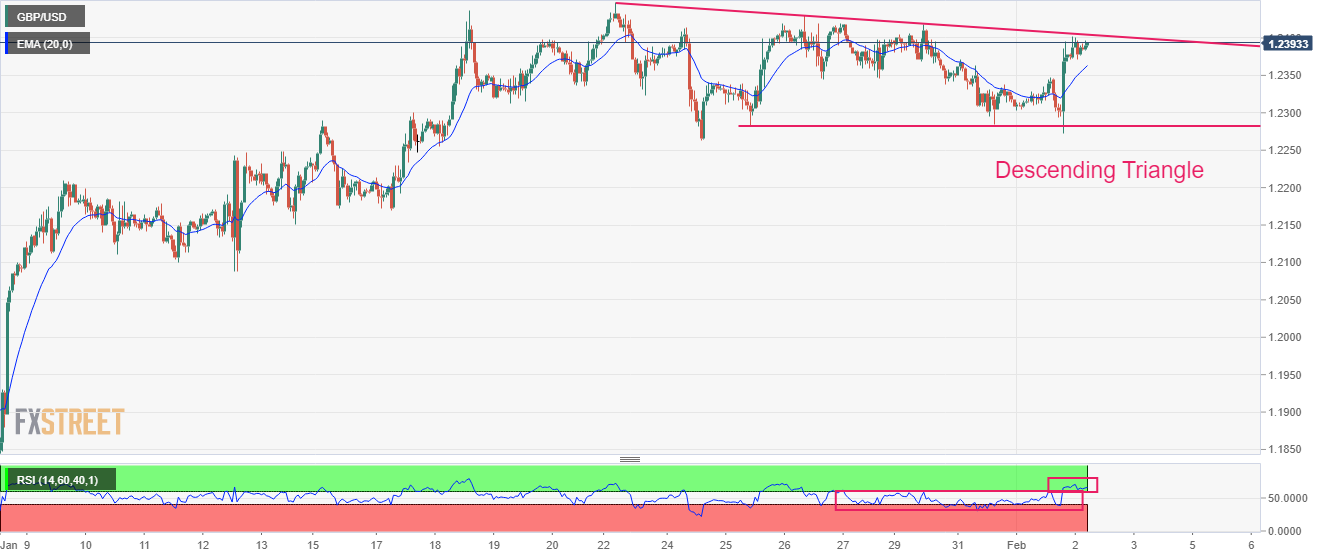
GBP/USD is on the verge of delivering a breakout of the Descending Triangle chart pattern formed on an hourly scale. The Pound Sterling has pushed the cable to near the downward-sloping trendline of the chart pattern placed from January 23 high at 1.2448 while the horizontal support is placed from January 25 low at 1.2283.
The 20-period Exponential Moving Average (EMA) at 1.2365 is scaling north firmly, which indicates that the upside trend carries immense strength.
Meanwhile, the Relative Strength Index (RSI) (14) has shifted into the bullish range of 60.00-80.00, which indicates that bullish momentum is highly active.
- EUR/USD portrays sluggish markets as bulls keep the reins near multi-month high.
- Overbought RSI, sluggish MACD challenges further upside but 21-DMA puts a floor under the price.
- Convergence of horizontal area from late January 2022, five-month-old ascending trend line appears a tough nut to crack for bulls.
EUR/USD clings to mild gains around 1.1020 as buyers keep the reins during the third consecutive day heading into Thursday’s European session. In doing so, the major currency pair remains firmer at the highest levels since early April 2022.
That said, the overbought RSI (14) and sluggish MACD signals seem to challenge the EUR/USD bulls of late.
Even if the European Central Bank (ECB) manages to propel the prices, a joint of the 13-month-old horizontal area and an ascending trend line from late September 2022 appears a tough nut to crack for the EUR/USD bulls, around 1.1120-30.
It’s worth noting that the EUR/USD pair’s run-up beyond 1.1130 needs validation from the March 2022 peak surrounding 1.1185 before challenging the mid-2022 top of 1.1495.
On the flip side, pullback moves could rest near the 1.0950-25 support area comprising multiple levels marked since late March 2022.
Following that, the 21-DMA level surrounding 1.0825 could probe the EUR/USD bears.
In a case where EUR/USD remains bearish past 1.0825, the 61.8% Fibonacci retracement level of the pair’s February-September 2022 downturn near 1.0745 could act as the last defense of the buyers.
EUR/USD: Daily chart
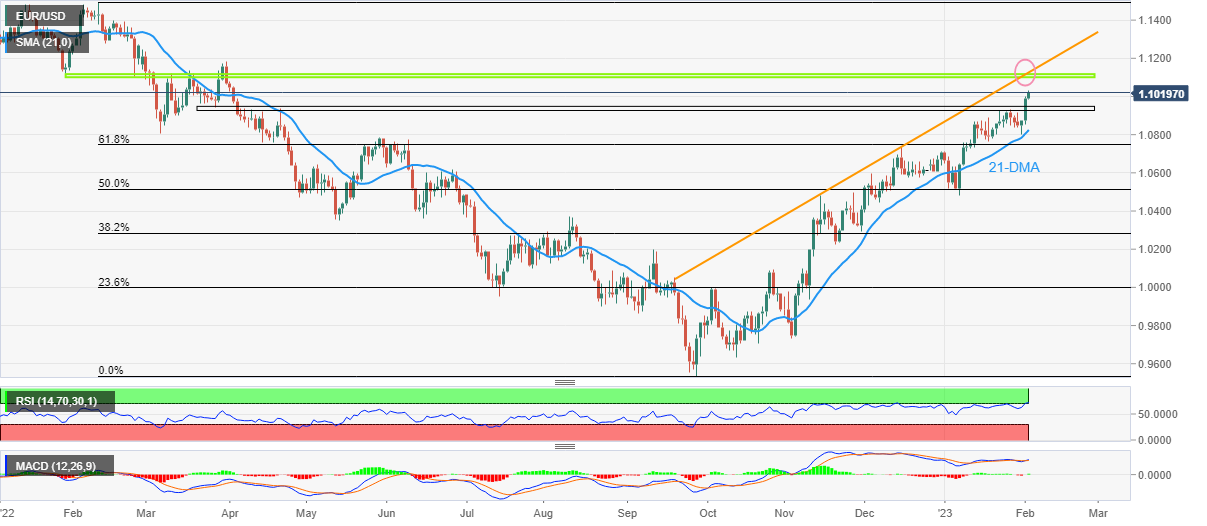
Trend: Limited upside expected
developing story ...
Key quotes
It is taking some time for market function to improve.
BoJ's Dec decision to widen band was necessary step to make YCC more sustainable, but the move alone may have had the effect of weakening stimulus effect.
Even with Dec step, stimulus effect is sufficient because inflation expectation is heightening.
Must strike balance to avoid weakening effect of stimulus, when asked whether boj should widen yield band again.
BoJ’s ultra-loose policy has had effect in pushing up inflation expectations.
We are seeing signs inflation may be heading toward hitting 2% inflation in sustainable manner, but not yet convinced this will actually happen.
Must look not just at short-term, but medium, long-term inflation expectations.
BoJ must not be complacent as downward price pressure remains fairly strong.
- GBP/JPY seesaws around a fortnight low during three-day downtrend.
- US 10-year Treasury bond yields dropped the most in two weeks on dovish Fed.
- Hawkish concerns from BoJ, downbeat UK data and workers’ strikes weigh on prices.
- BoE is expected to announce 0.50% rate hike but hints for policy pivot will be crucial to watch.
GBP/JPY remains depressed around 159.20 even as further downside stalls ahead of the key Bank of England (BoE) Monetary policy announcements, up for publishing on Thursday. That said, the cross-currency pair traces a corrective move in the Treasury bond yields while portraying the market’s cautious mood ahead of the key events.
It’s worth noting that the US 10-year Treasury yields slumped the most in two weeks while testing the lowest levels in a fortnight the previous day after the US Federal Reserve (Fed) announced its dovish hike of 0.25%. The US central bank unveiled receding fears of inflation and Chairman Jerome Powell showed readiness for cutting the rates if inflation drops faster. The same propelled the risk-on mood and favored Wall Street bulls.
Other than the strong yields, hawkish comments from Bank of Japan (BoJ) officials also favored the GBP/JPY bears. That said, Bank of Japan's Deputy Governor Masazumi Wakatabe has said the BoJ will continue to conduct monetary policy to achieve 2% inflation accompanied by wage growth. The Japanese central bank has recently conducted multiple bond market moves to defend the Yields Curve Control (YCC) policy.
Elsewhere, the mass strikes by various UK workers' unions challenge the already struggling economy and exert downside pressure on the GBP/JPY prices. “Up to half a million British teachers, civil servants, and train drivers walked out over pay in the largest coordinated strike action for a decade on Wednesday, with unions threatening more disruption as the government digs its heels in over pay demands,” said Reuters.
On the same line, the downbeat prints of S&P Global/CIPS UK Manufacturing PMI, which confirmed a consecutive sixth monthly contraction in factory output by flashing 47.0 figure versus 46.7 initial forecasts also pleased the GBP/JPY bears. “Weak demand from clients at home and abroad plus strong price inflation and a shortage of raw materials and staff all weighed on production. Brexit and port problems hurt exports while demand from China was particularly weak,” S&P Global said per Reuters.
Against this backdrop, the S&P 500 Futures print mild gains while Japan’s Nikkei 225 follows the suit as traders await another round of central bank comments.
That said, the BoE’s 0.50% rate hike is already given and hence the Cable sellers will be more interested in hearing about the easy rate hikes, as well as policy pivot. Other than the BoE, risk catalysts and bond market moves will also be crucial for the GBP/JPY traders.
Technical analysis
A sustained reversal from the 50-day Exponential Moving Average (EMA), around 161.55 by the press time, directs GBP/JPY bears toward an upward-sloping support line from late September 2022, close to 157.40.
- USD/CAD holds lower grounds near 2.5-month bottom, fades bounce off 200-EMA of late.
- Clear downside break of short-term key support line favors sellers.
- 50-EMA holds the key to bull’s conviction, 1.3700 appears a tough nut to crack for them.
USD/CAD remains pressured around the lowest levels since mid-November 2022 as it pokes the 200-day Exponential Moving Average (EMA) during early Thursday. In doing so, the Loonie pair prints mild losses during the three-day losing streak.
It’s worth noting that the quote’s sustained trading below the 50-EMA and a clear break of the eight-month-old ascending support line seems to keep the USD/CAD bears hopeful. Also favoring the sellers is the absence of an oversold RSI (14) line.
That said, the Loonie pair bears are very much capable of breaking the aforementioned key 200-EMA support surrounding 1.3260.
However, multiple levels marked since July 2022, surrounding 1.3230-20, portray strong support for the USD/CAD sellers to break if they wish to keep the reins.
Following that, a 61.8% Fibonacci retracement of the pair’s April-October 2022 run-up near the 1.3000 psychological magnet will be a crucial level to lure the USD/CAD bears.
On the contrary, a daily closing beyond the support-turned-resistance line from June 2022, close to 1.3320 by the press time, could activate the pair’s corrective bounce.
Even so, the USD/CAD bulls are likely to remain skeptical unless witnessing a daily closing beyond the 50-EMA level surrounding 1.3450.
In a case where the quote crosses the 1.3450 hurdle, the odds of its rally toward the multiple hurdles nearing 1.3700 can’t be ruled out.
USD/CAD: Daily chart
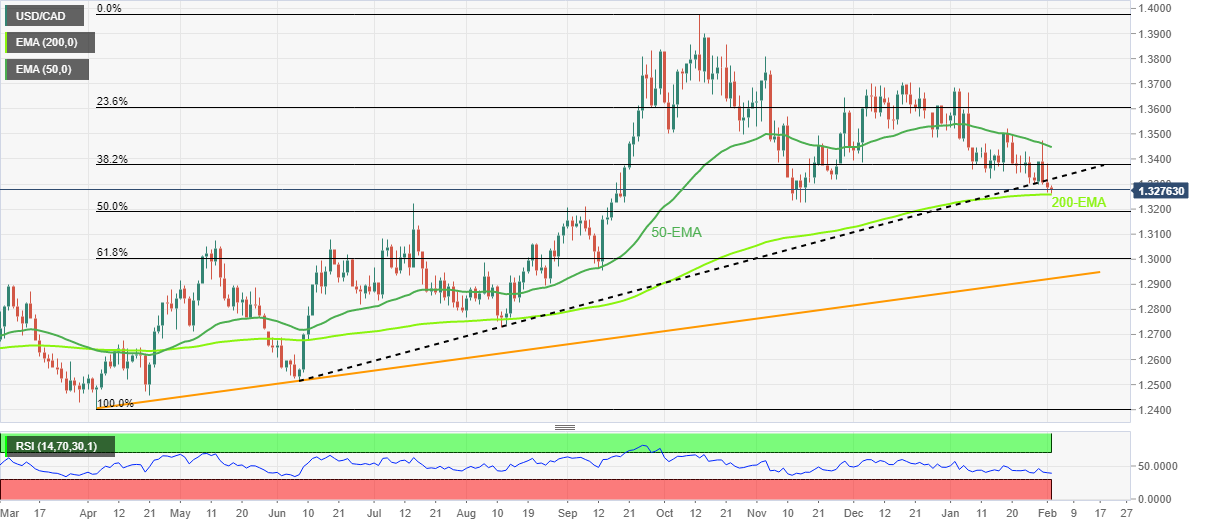
Trend: Further downside expected
- Asian stocks are mildly positive despite the upbeat market mood post-Fed’s less-hawkish policy.
- Thursday’s session is going to be super-duper volatile ahead as the interest rate decision by the ECB and the BoE.
- Chinese equities are likely to dance to the tunes of the Caixin Services PMI data.
Markets in the Asian domain are moderately positive on Thursday as the Federal Reserve (Fed) announced a smaller interest rate hike to keep its monetary tools sharpened in its fight against inflation. Fed chair Jerome Powell announced a 25 basis point (bps) interest rate hike and pushed interest rates to 4.50-4.75% but kept doors open for further expansion in borrowing costs.
At the press time, Japan’s Nikkei225 added 0.17%, SZSE Component gained 0.36%, KOSPI climbed 0.80%, Hang Seng jumped 0.47%, and Nifty50 dropped 0.36%.
Fed Powell has confirmed that the disinflationary process has started in the United States but is still not satisfied that the monetary policy is sufficiently restrictive to achieve price stability by decelerating the Consumer Price Index (CPI) to the 2% target. Meanwhile, a decline in Automatic Data Processing (ADP) Employment data to 106K and a surge in job openings data have conveyed that the United States economy is failing to provide a sufficient supply of labor to meet the demand offered by the corporate sector. For more clarity, the US Nonfarm Payrolls (NFP) will be on investors’ radar.
Thursday’s session is going to be super-duper volatile ahead of the interest rate decision by the European Central Bank (ECB) and the Bank of England (BoE). The street is expecting a hawkish stance on policy rates by the central banks as the inflation rate in both economies is still roaring higher.
Meanwhile, Chinese stocks are likely to dance to the tunes of the Caixin Services PMI data, which will release on Friday. After the release of the unimpressive Manufacturing PMI, investors are shifting their focus toward Services PMI data. The economic data is seen at 47.3 lower than the prior release of 48.0.
On the oil front, oil price witnessed a massive sell-off on Wednesday led by further policy contraction by the Fed, weaker US ISM Manufacturing PMI, and a build-up of oil inventories reported by the US Energy Information Administration (EIA) for the week ending January 27. The oil price has attempted a recovery move, however, the downside bias is still solid.
- AUD/USD clings to mild gains at multi-day top, sidelined of late.
- Australia Building Permits came in firmer during December.
- Market sentiment dwindles as traders lick Fed-induced wounds ahead of ECB, BoE.
- US Factory Orders, hints for Friday’s NFP could entertain Aussie pair traders.
AUD/USD remains sidelined at the highest levels since June 2022, mildly bid near 0.7140 during early Thursday, as bulls take a breather after the biggest daily jump in a month. In doing so, the risk-barometer pair portrays the market’s inaction while keeping the Federal Reserve (Fed) inspired gains.
Other than the Fed’s dovish rate hike, firmer prints of Aussie housing data also favor the AUD/USD buyers. That said, Australia’s Building Permits rose 18.5% MoM and improved to -3.8% YoY in December versus -9.0% and -15.1% respective priors.
Elsewhere, the Fed announced a 0.25% rate hike and matched the market forecast. However, the interesting part was lying in the Monetary Policy Statement which stated that the inflation “has eased somewhat but remains elevated”. Following the initial Fed announcements, the US Dollar paused the early Wednesday’s rebound.
However, major moves took place on Fed Chair Jerome Powell’s comments as he said “We can declare that a deflationary process has begun.” The policymaker also accepts the need for rate cuts during late 2023 if inflation comes down much faster. It should be observed that Fed Chair suggested that a couple more rate hikes are needed to reach the policy pivot but markets seem to ignore the fact.
As the Federal Open Market Committee (FOMC) came out dovish, Wall Street rallied and the US 10-year Treasury yields slumped the most in two weeks while testing the lowest levels in a fortnight. Further, the S&P 500 Futures print mild gains around the highest levels since August 2022, tested the previous day.
Looking ahead, AUD/USD traders may witness a lackluster day ahead of the monetary policy meetings of the European Central Bank (ECB) and the Bank of England (BoE) as they both are likely to propel the market moves. In addition to that, US Factory Orders for December, were expected 2.3% versus -1.8% prior and the US Preliminary Nonfarm Productivity for the fourth quarter (Q4), expected 2.4% versus 0.8% prior. Above all, Friday’s US jobs report for January will be crucial to follow for clear directions.
Technical analysis
Although the overbought RSI tests AUD/USD bulls, the pair’s downside remains off the table unless witnessing a daily closing below the six-month-old horizontal support surrounding 0.7130-25.
- USD/INR has shown a rebound move as the USD Index has gauged an intermediate cushion around 100.50.
- Fresh signals of a decline in inflation projections indicate that the Fed might pause the rate hike cycle.
- The Indian government has trimmed its fiscal deficit target to 5.9% of GDP below the prior target of 6.4%.
The USD/INR pair has rebounded after dropping to near 81.65 in the Asian session. The asset has found demand as the US Dollar Index (DXY) has shown signs of a pullback move after refreshing its nine-month low at 100.50. The USD Index is still in an extremely negative trajectory, therefore, the pullback move could be capitalized as a selling opportunity by the market participants.
S&P500 futures are holding the majority of their extra gains recorded in the Tokyo session above the stellar gains recorded on Wednesday, portraying that the risk-appetite theme is extremely solid. The demand for US government bonds is declining, which has pushed 10-year US Treasury yields above 3.41%.
In its interest rate decision, the Federal Reserve (Fed) slowed down its policy tightening pace again to 25 basis points (bps) after slowing it already to 50 bps in December’s meeting. Fed chair Jerome Powell has confirmed that the policy tightening cycle will continue for now as the central bank wants to strengthen itself in the battle against inflation. While the street is expecting that the Fed might pause its interest rate hiking spree due to the availability of various evidence of further inflation softening.
On the Indian rupee front, Union Budget presented by Finance Minister Nirmala Sitharaman failed to provide strength to the Indian equities. According to the Fiscal Budget 2023-24, the administration has increased the scale of tax slabs, which will support individuals having annual earnings up to Rs. 7 lakhs. Apart from that, the government has trimmed the Fiscal Deficit target to 5.9% of the Gross Domestic Product (GDP) from the 6.4% announced in the prior period. A lower fiscal deficit target might strengthen the Indian Rupee ahead.
Meanwhile, the oil price has turned sideways after a recovery move from below $76.50. On Wednesday, the oil price plunged after the United States Energy Information Administration (EIA) reported a build-up of oil stockpiles by 4.14M for the week ending January 27. It is worth noting that India is one of the leading importers of oil and lower oil price support the Indian rupee.
- USD/JPY is demonstrating a less-confident pullback move as the risk profile is extremely positive.
- A bear cross, represented by the 20-and 50-period EMAs around 130.00, adds to the downside filters.
- The RSI (14) has shifted into the bearish range of 20.00-40.00, which indicates that the downside momentum has been triggered.
The USD/JPY pair has rebounded after finding an intermediate cushion around 128.20 in the Asian session. Considering the risk-on market mood, the downside bias is intact, therefore, investors should see the rebound mere a pullback that can be sold ahead.
S&P500 futures have eased some of their gains recorded in the Asian session, however, the risk appetite of the market participants is still strong as the impact of policy tightening slowdown decision by the Federal Reserve (Fed) will stay for a longer period. The US Dollar Index (DXY) is hovering near its fresh nine-month low around 100.51. While the 10-year US Treasury yields have rebounded above 3.40%.
On a two-hour scale, USD/JPY has delivered a breakdown of the Rectangle formation that indicates volatility explosion, which results in wider ticks to the south-side and heavy volume. A bear cross, represented by the 20-and 50-period Exponential Moving Averages (EMAs) around 130.00, adds to the downside filters.
The Relative Strength Index (RSI) (14) has shifted into the bearish range of 20.00-40.00, which indicates that the downside momentum has been triggered.
Should the asset breaks below intraday low around 128.17, Japanese Yen bulls will drag the asset toward Jnauary 16 low at 127.27 followed by May 24 low at 126.36.
On the contrary, the US Dollar bulls will get strengthened if the asset recovers above January 31 high around 130.50, which will drive the asset toward January 18 high at 131.57. A breach above the latter will extend the upside journey of the asset toward January 9 high at 132.65.
USD/JPY two-hour chart
-638109057710886665.png)
- EUR/USD clings to mild gains around 10-month high amid sluggish markets.
- Fed’s dovish hike pleased US Dollar bears as slowing inflation, rate cuts were uttered.
- ECB needs to push back slower rate hike concerns to justify 50 bps rate hike,
- Softer EU inflation, German data raise difficulty for ECB’s Lagarde to defend Euro bulls.
EUR/USD seesaws around the highest levels since April 2022, mildly bid near 1.1020 during a three-day uptrend, as pair traders wait for fresh clues ahead of the all-important European Central Bank (ECB) monetary policy meeting. In doing so, the major currency pair defends Federal Reserve (Fed) induced gains as market sentiment remains cautiously optimistic.
The Fed drowned the US Dollar with its dovish hike of 0.25%, which was widely expected and priced in. The major attention, however, was given to the Fed statement suggesting the receding inflation pressure and Chairman Jerome Powell’s hints of rate cuts during late 2023 if inflation drops faster. Additionally favoring the EUR/USD bulls were downbeat US data and hopes of more stimulus from China, not to forget upbeat equities and softer US Treasury bond yields.
Among the key US data, the softer prints of the US ISM Manufacturing PMI and ADP Employment Change gained major attention and weighed on the greenback before the super-duper Fed moves.
On the other hand, the Euro Area Harmonised Index of Consumer Prices (HICP) dropped to 8.5% YoY versus 9.0% expected and 9.5% prior while the Core HICP reprinted 5.2% YoY number compared to 5.1% market forecasts. It’s worth noting that Germany’s Gross Domestic Product (GDP) for the fourth quarter (Q4) and the latest Retail Sales raised a challenge for the ECB hawks as both these data suggest the need for easy money for the bloc’s powerhouse. Also challenging the old continent’s economics are the geopolitical tussles with Russia and internal tension surrounding the bloc’s statutory economic norms and oil price caps.
Against this backdrop, Wall Street rallied and the US 10-year Treasury yields slumped the most in two weeks while testing the lowest levels in a fortnight. On the same line were the US two-year Treasury bond coupons which poke 4.11% level at the latest. It should be observed that the US 10-year yields lick their wounds near 3.41% while the S&P 500 Futures print mild gains around the highest levels since August 2022, tested the previous day, by the press time.
To sum up, EUR/USD is likely to remain firmer as the ECB is up for 0.50% rate hike and the Fed matched market forecasts of taking a dovish move. However, the major currency pair’s ability to reject the pullback relies on how well ECB President Christine Lagarde defends the further rate hikes.
Other than the ECB, US Factory Orders for December, expected 2.3% versus -1.8% prior and the US Preliminary Nonfarm Productivity for the fourth quarter (Q4), expected 2.4% versus 0.8% prior. Above all, Friday’s US jobs report for January will be crucial to follow for clear directions.
Technical analysis
EUR/USD remains on the way to March 2022 peak surrounding 1.1185 unless breaking a seven-week high ascending trend line, close to 1.0960 by the press time.
- Gold price remains sidelined around multi-day top, stays firmer past $1,950 confluence level.
- Fewer technical hurdles, expected hawkish outcomes from ECB keep XAU/USD buyers hopeful.
- US second-tier data, risk catalysts may entertain Gold traders ahead of NFP.
Gold price (XAU/USD) grinds near the highest levels since April 2022, making rounds to $1,952-50 during early Thursday. In doing so, the XAU/USD bulls seem to catch a breather after rising the most in a fortnight as markets brace for a few more central banks and the US jobs report.
That said, the Gold price rallied heavily the previous day after the US Federal Reserve (Fed) drowned the US Dollar with its dovish hike of 0.25%, which was widely expected and priced in. The major attention, however, was given to the Fed statement suggesting the receding inflation pressure and Chairman Jerome Powell’s hints of rate cuts during late 2023 if inflation drops faster. Additionally favoring the XAU/USD bulls were downbeat US data and hopes of more stimulus from China, not to forget upbeat equities and softer US Treasury bond yields.
Moving on, monetary policy meetings of the European Central Bank (ECB) and the Bank of England (BoE) could indirectly affect the Gold price via the US dollar and the market sentiment. Though, Friday’s US jobs report for January will be crucial for a clear guide.
Also read: Gold Price Forecast: XAU/USD bulls cheer Federal Reserve action ahead of United States Nonfarm Payrolls
Gold Price: Key levels to watch
The Technical Confluence Detector shows that the Gold price grinds higher past the all-important $1,950 support confluence, comprising previous monthly and weekly highs, not to forget the lower band of Bollinger on 15 minutes.
Even if the Gold price slip beneath the key support, a convergence of the Fibonacci 38.2% on one-day and 23.6% on one-week could challenge the metal’s further downside near $1,940.
Following that, 38.2% on one-week, the middle band of the Bollinger on the hourly play and SMA 5 on four-hour (4H) could together restrict Gold price declines near $1,935.
Alternatively, Pivot Point one-month R1 near $1,978 appears the key hurdle for the Gold buyers to poke as they defend positions beyond $1,950.
Ahead of that, Pivot point one-week R2 could challenge the XAU/USD bulls near $1,968. It’s worth noting that the late March 2022 high near $1,966 appears the immediate hurdle for Gold traders to watch.
Here is how it looks on the tool
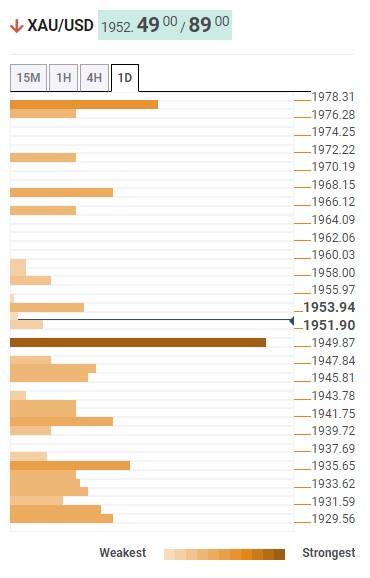
About Technical Confluences Detector
The TCD (Technical Confluences Detector) is a tool to locate and point out those price levels where there is a congestion of indicators, moving averages, Fibonacci levels, Pivot Points, etc. If you are a short-term trader, you will find entry points for counter-trend strategies and hunt a few points at a time. If you are a medium-to-long-term trader, this tool will allow you to know in advance the price levels where a medium-to-long-term trend may stop and rest, where to unwind positions, or where to increase your position size.
- USD/CNH pares intraday losses around 13-day low, picking up bids of late.
- Ascending trend line from June 2022 appears a tough nut to crack for bears amid oversold RSI.
- 10-DMA guards recovery moves, three-week-old resistance line challenge bulls.
USD/CNH bounces off two-week low while picking up bids to 6.7180 during early Thursday morning in Asia. In doing so, the offshore Chinese Yuan (CNH) pair also justifies the oversold RSI conditions.
However, the quote’s sustained trading below the key SMAs and a downward-sloping trend line from early January keeps the USD/CNH bears hopeful.
It’s worth noting that not only the stated support line from June 2022, close to 6.7040, but the previous monthly low of 6.6975 also challenges the pair’s further downside.
Though, a sustained break of 6.6975 won’t hesitate to visit the mid-2022 bottom surrounding 6.6170.
Meanwhile, recovery moves may initially poke the 10-DMA hurdle of 6.7570 before challenging the 21-DMA resistance of near 6.7680.
Following that, a downward sloping trend line from January 10, close to 6.7880, will be crucial for the USD/CNH buyers as a break of which could confirm a short-term upside. Even so, the 6.8000 round figure may act as a final defense of the pair sellers.
Overall, USD/CNH remains on the bear’s radar unless crossing the 6.8000 psychological magnet even if a short-term recovery appears on the table.
USD/CNH: Daily chart
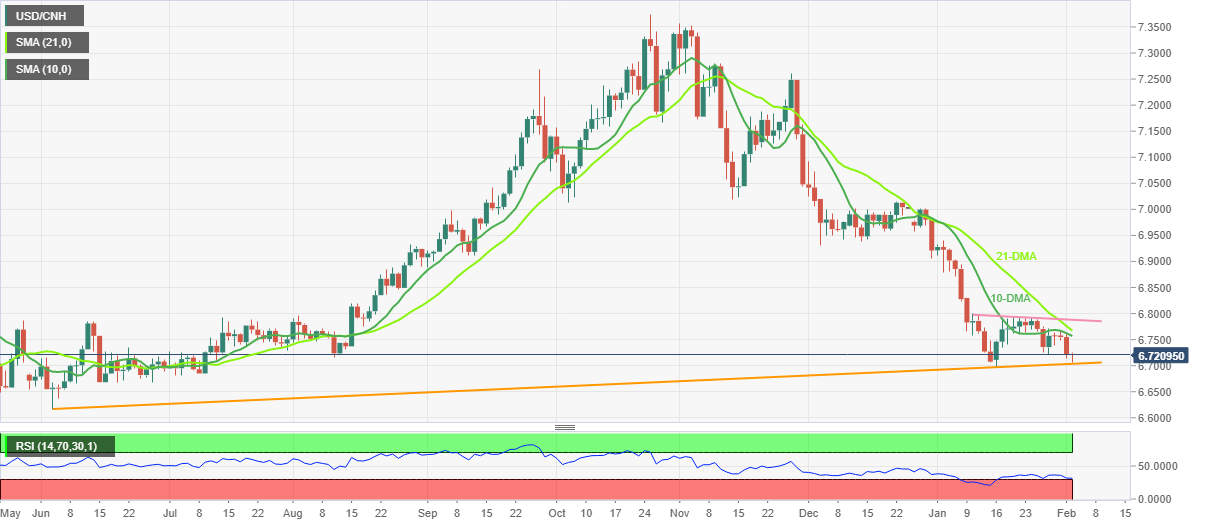
Trend: Corrective bounce expected
| Raw materials | Closed | Change, % |
|---|---|---|
| Silver | 23.962 | 1.14 |
| Gold | 1950.115 | 1.17 |
| Palladium | 1670.79 | 1.81 |
Jeffrey Gundlach, Wall Street's bond king and Founder and Chief Executive Officer of DoubleLine Capital, offered his take on the US Federal Reserve (Fed) policy outlook following the first meeting of this year.
Key quotes
Odds of recession this year are down; still over 50%.
Odds of a 2023 rate cut are a ‘coin flip’.
We should all watch core services ex-housing.
Think we have one more rate hike left.
Related reads
- S&P 500 Futures defend post Fed gains, Treasury bond yields stabilize as ECB, BoE decisions loom
- Forex Today: US Dollar bears celebrate Fed’s dovishness
- GBP/USD retreats from intraday high, consolidates the biggest daily gain in a week.
- Federal Reserve matched market consensus of 0.25% rate hike but mentioning of easy inflation, rate cuts drowned US Dollar.
- UK’s “Walkout Wednesday” appears just the start as unions eye more such shows, British Manufacturing PMI marked sixth consecutive contraction.
- BoE is up for 50 bps rate hike, attention should be given to statement suggesting future pace of rate lifts.
GBP/USD bulls take a breather around 1.2380, retreating from a three-day high, as the Cable pair buyers consolidate the biggest daily gains in a week ahead of the all-important Bank of England (BoE) monetary policy meeting.
The quote rallied heavily after the US Federal Reserve (Fed) Monetary Policy Statement mentioned that the inflation “has eased somewhat but remains elevated”. Adding to the GBP/USD pair’s upside were comments from Fed Chair Jerome Powell as he said “We can declare that a deflationary process has begun.” The policymaker also accepts the need for rate cuts during late 2023 if inflation comes down much faster. Even so, Fed’s Powell suggested that a couple more rate hikes are needed to reach it.
It should be noted, however, that the mixed US data and downbeat concerns surrounding Britain seemed to have probed the GBP/USD bulls afterward.
That said, US ISM Manufacturing PMI dropped to the lowest levels since June 2020 while marking 47.4 figure for January, versus 48.0 expected and 48.4 prior. Further, the ADP Employment Change also declined to a one-year low with 106K the latest figure compared to the 178K market forecasts and the upwardly revised previous figure of 253K. On the contrary, JOLTS Job Openings rose to 11.012M in December, crossing 10.25M consensus and 10.44M prior readings.
At home, the mass strikes by various workers' unions challenge the already struggling economy. “Up to half a million British teachers, civil servants, and train drivers walked out over pay in the largest coordinated strike action for a decade on Wednesday, with unions threatening more disruption as the government digs its heels in over pay demands,” said Reuters.
Furthermore, the S&P Global/CIPS UK Manufacturing PMI confirmed a consecutive sixth monthly contraction in factory output, with 47.0 figure versus 46.7 initial forecasts, which in turn weighed on the British Pound (GBP). “Weak demand from clients at home and abroad plus strong price inflation and a shortage of raw materials and staff all weighed on production. Brexit and port problems hurt exports while demand from China was particularly weak,” S&P Global said per Reuters.
Amid these plays, Wall Street rallied and the US 10-year Treasury yields slumped the most in two weeks while testing the lowest levels in a fortnight. On the same line were the US two-year Treasury bond coupons which poke 4.11% level at the latest. It should be observed that the US 10-year yields lick their wounds near 3.41% while the S&P 500 Futures print mild gains around the highest levels since August 2022, tested the previous day, by the press time.
Moving on, the BoE is expected to announce a 0.50% increase in its benchmark interest rate and the same is widely known, also appears priced in. As a result, the GBP/USD pair may witness a mild reaction in case of no surprises. However, major attention will be given to the language in the BoE Statement and Governor Andrew Bailey’s press conference to gauge the future of further rate increases.
Technical analysis
An eight-day-old resistance line near 1.2405 restricts immediate GBP/USD upside even as the upbeat oscillators and successful trading beyond the 21-DMA, at 1.2280 by the press time, challenge the Cable pair sellers.
- NZD/USD is showing signs of exhaustion in the upside momentum, however, the upside bias is intact.
- The USD Index has refreshed its nine-month low at 100.51 amid a cheerful market mood.
- Higher job openings and lower employment numbers (Jan) in the US economy indicate that labor demand is exceeding supply.
The NZD/USD pair is facing fragile hurdles in overstepping the seven-month high at 0.6529 in the Tokyo session. The upside bias in the Kiwi asset is intact as the Federal Reserve (Fed) has slowed down the pace of policy tightening further after sensing the fact that the disinflationary process has started in the United States.
S&500 futures have added more gains after an upbeat Wednesday session, portraying a cheerful market mood. Meanwhile, the improved risk appetite of the market participants has triggered volatility for the US Dollar Index (DXY). The USD Index has refreshed its nine-month low at 100.51, at the time of writing, and is expected to remain on tenterhooks.
Although Fed chair Jerome Powell in his commentary has confirmed that more rate hikes are in place till the monetary policy gets sufficiently restrictive, the room for more policy tightening is extremely low. Consumer spending has slowed down and manufacturing activities have contracted for three consecutive months, which indicates that further interest rate hiking could spoil firms’ morale and push the economy into recession.
On the US labor market front, Job openings accelerated to 11.012M vs. the consensus of 10.25M and the former release of 10.44M. While US Automatic Data Processing (ADP) Employment data landed at 106K significantly lower than the estimates of 178K and the former release of 253K. The combination of higher job openings and lower employment numbers indicates that labor demand is exceeding supply, in times of higher inflation, which seems a good thing for the United States economy.
For further guidance on US employment, the release of the US Nonfarm Payrolls (NFP) data will be of utmost importance.
On the New Zealand front, unimpressive Employment data released on Wednesday might delight the Reserve Bank of New Zealand (RBNZ). Analysts at Westpac believe “While the jobs market is coming from a very strong starting point, there is good reason to expect deterioration in the years ahead. In contrast, wage inflation remains on the rise, and the turning point is likely to come later.”
For interest-rate guidance, Westpac sees a further hike in the Official Cash Rate (OCR) by 50 basis points (bps) in its February meeting.
- AUD/USD is taking on the prior resistance following the Fed rally.
- A -272% extension opens risk to test the 0.72s and 0.7280 higher up.
The Australian Dollar rallied to an eight-month high on Thursday following the dovish tilt at the Federal Reserve. The Aussie was at 0.7157 the high today and trading at the best level for the bulls since 0.7283 which was scored in early June. The following illustrates the prospects of higher still with eyes on the 0.72s.
AUD/USD daily chart
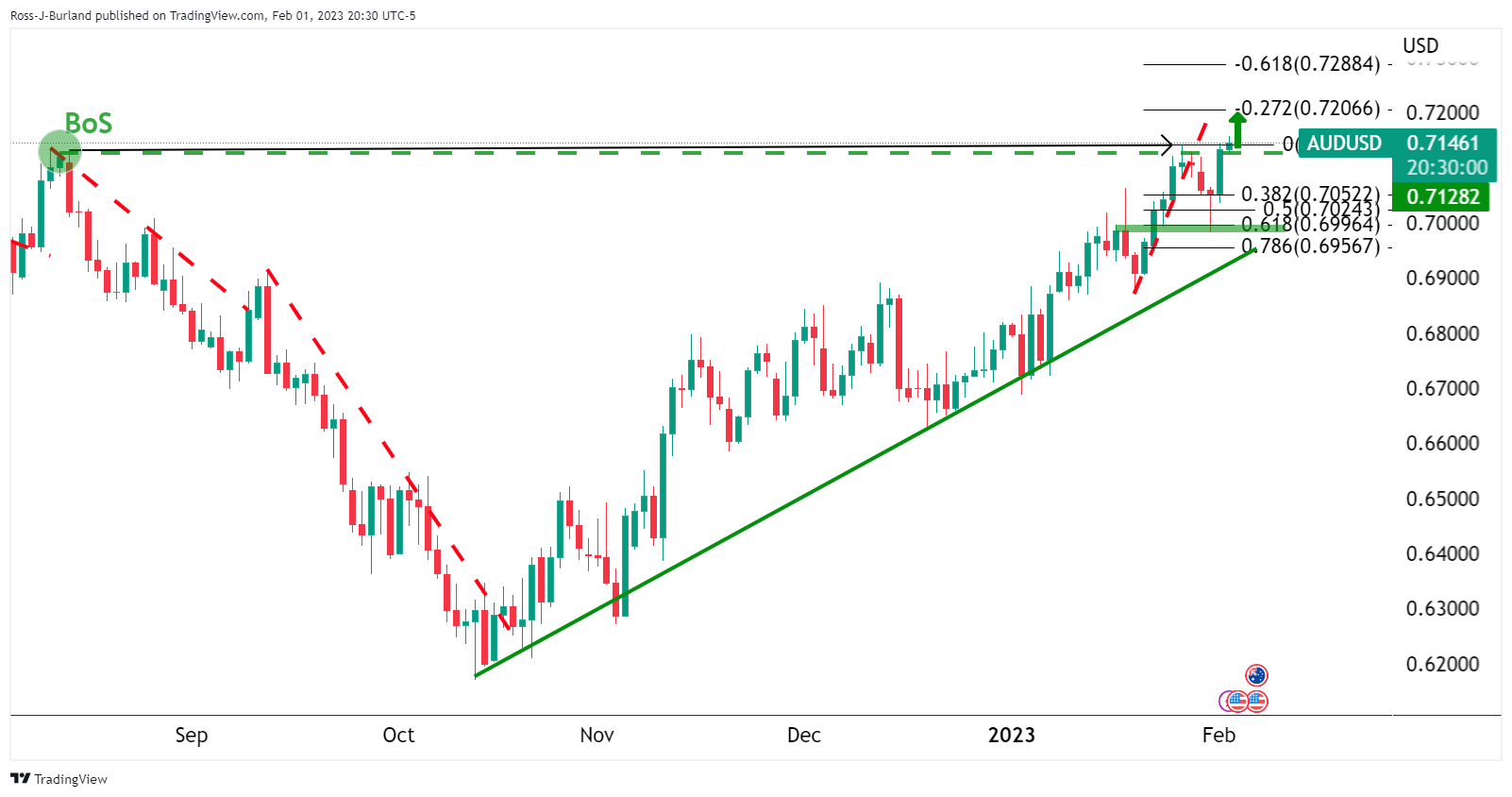
The price broke the structure made before September of last year around 0.7130 which leaves scope for a continuation of the bullish cycle after the correction that was made to a deep 61.8% ratio target that had a confluence of the prior resistance.
Zoomed in ...
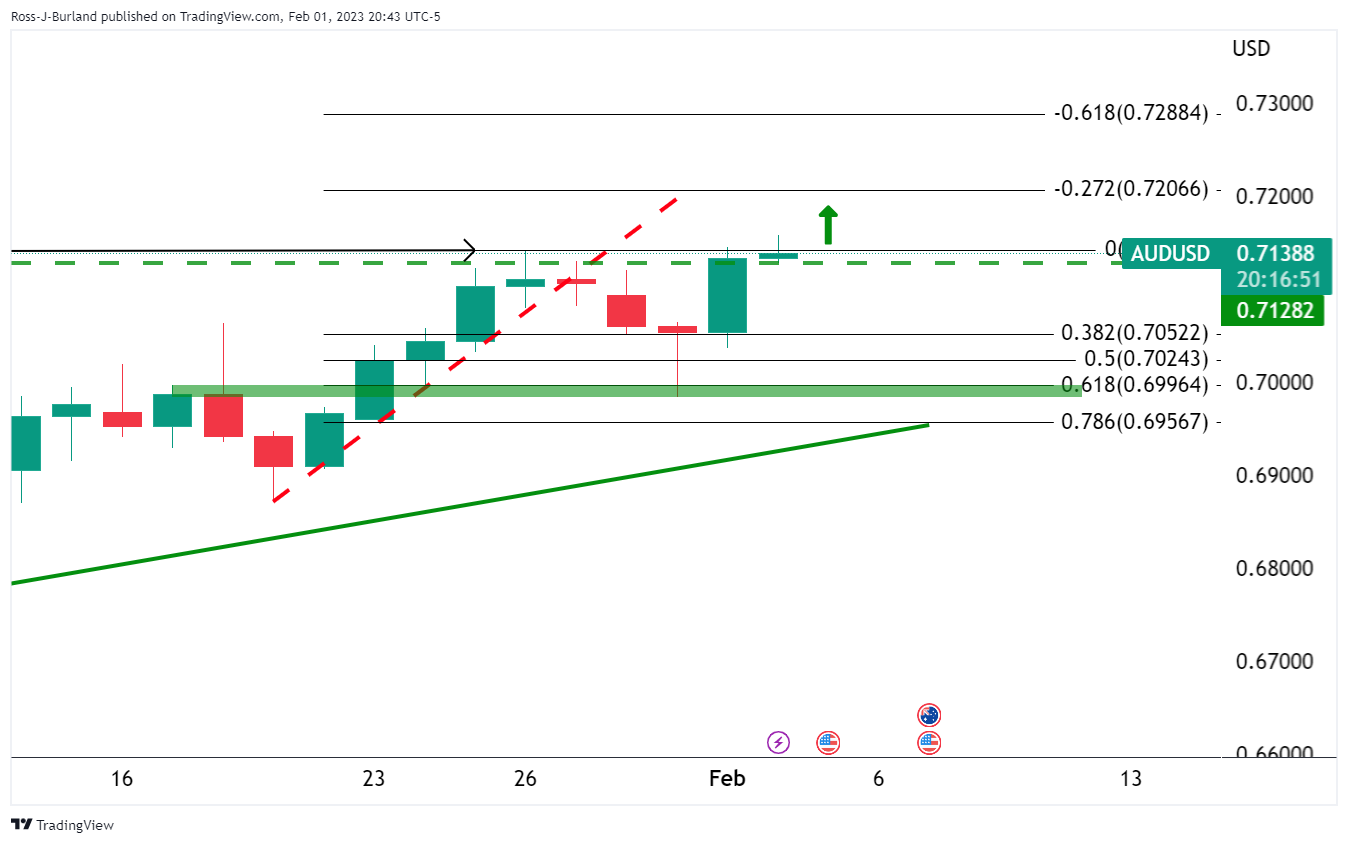
We can see the classic impulse, correction and fresh impulse in play., taking on the prior resistance. A -272% extension opens risk to test the 0.72s and 0.7280 higher up.
- Market sentiment remains dicey as traders take a breather after Fed-led volatility.
- S&P 500 Futures track Wall Street’s gains to print mild gains near the highest levels since August 2022.
- US 10-year, two-year Treasury bond yields seesaw around two-week low.
- Key central bank announcements could propel volatility ahead of Friday’s US NFP.
Risk profile remains slightly positive even as market momentum fades after the Federal Reserve-inspired volatility. That said, the US Federal Reserve’s (Fed) dovish rate hike bolstered investor sentiment the previous day, backed by the downbeat US data. However, the cautious mood ahead of other major central bank announcements seems to probe the momentum traders of late.
While portraying the mood, Wall Street rallied and the US 10-year Treasury yields slumped the most in two weeks while testing the lowest levels in a fortnight. On the same line were the US two-year Treasury bond coupons which poke 4.11% level at the latest. It should be observed that the US 10-year yields lick their wounds near 3.41% while the S&P 500 Futures print mild gains around the highest levels since August 2022, tested the previous day, by the press time.
The Fed matched market forecasts of increasing the benchmark rate by 0.25% but the Monetary Policy Statement fuelled the market’s risk appetite while saying that the inflation “has eased somewhat but remains elevated”. Adding to the market’s optimism were comments from Fed Chair Jerome Powell as he said “We can declare that a deflationary process has begun.” The policymaker also accepts the need for rate cuts during late 2023 if inflation comes down much faster. Even so, Fed’s Powell suggested that a couple more rate hikes are needed to reach it.
On a different page, US ISM Manufacturing PMI dropped to the lowest levels since June 2020 while marking 47.4 figure for January, versus 48.0 expected and 48.4 prior. Further, the ADP Employment Change also declined to a one-year low with 106K the latest figure compared to the 178K market forecasts and the upwardly revised previous figure of 253K. On the contrary, JOLTS Job Openings rose to 11.012M in December, crossing 10.25M consensus and 10.44M prior readings.
It should be noted that the upbeat earnings from Meta also underpinned the market’s optimism and fuelled the Wall Street benchmarks toward refreshing monthly tops.
Moving ahead, markets are likely to witness lackluster session as traders could lick their wounds before the monetary policy meetings of the European Central Bank (ECB) and the Bank of England (BoE). Following that, Friday’s US Jobs report will be important for clear directions.
The Bank of Japan's deputy governor Masazumi Wakatabe has said the BoJ will continue to conduct monetary policy to achieve 2% inflation accompanied by wage growth.
Key comments
Global economy to slow temporarily but likely to pick up as inflationary pressure eases.
Japan's economy likely to continue recovering.
Corporate inflation expectations shifting up somewhat.
What is most important is for changes in price, wages to be sustained, lead to achievement of 2% inflation target. in stable, sustainable fashion.
There is absoutely no change to boj's commitment to continue monetary easing.Our monetary easing was clearly effective in propping up economy.
Efforts to boost long-term economic growth don't conflict with steps to stabilise economy including monetary easing
Making central bank's price target ambiguous would hurt transparency of monetary policy, effect of policy steps.
Inflation target is important.
USD/JPY update
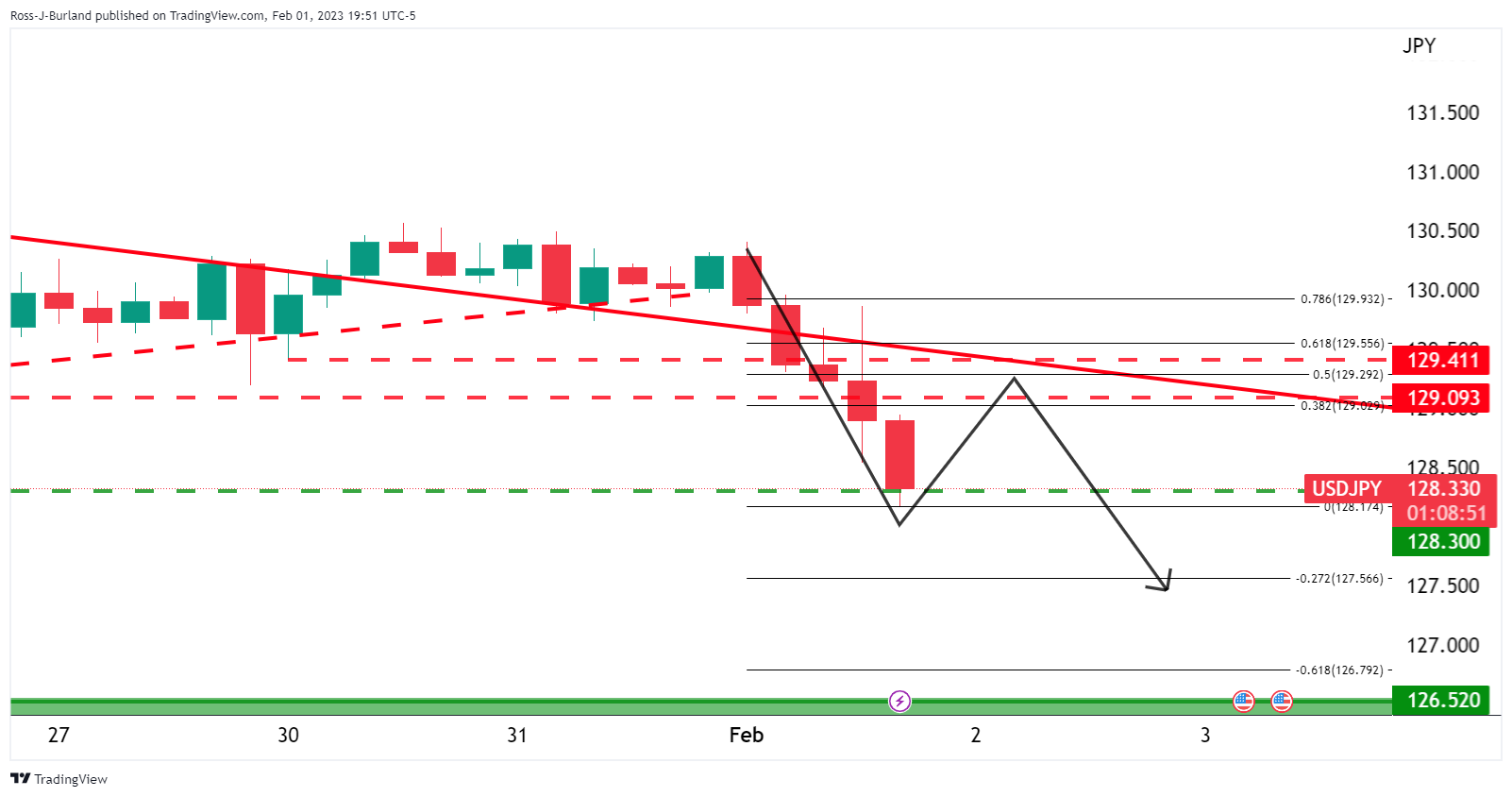
The 4-hour chart sees USD/JPY below the trendline resistance and the bias is lower following the breakout of the geometrical structure.
If the bears get below the support structure near 128.30, then the outlook will remain bearish. However, if there is a bullish correction and a retest of the 129 area in a 38.2% Fibonacci, then should the bears move in, the focus will be on the 127.50s.
- USD/CHF prints three-day downtrend as sellers flirt with 18-month low.
- Fed drowned US Dollar with dovish hike, downbeat US data also favor USD/CHF bears.
- Monetary policy decision from ECB, BoE could escalate market volatility, making them important to watch.
- US jobs report eyed as Fed Chair Powell showed readiness to cut the rates.
USD/CHF remains depressed at the lowest levels since August 2021 as bears cheer a three-day downtrend near 0.9065 during Thursday’s Asian session. In doing so, the Swiss Franc (CHF) pair extends the US Federal Reserve-induced losses as market players await the key central bank decision and the US employment report for January.
USD/CHF refreshed a multi-day low the previous day as downbeat US data joined the Fed’s dovish rate hike.
That said, the Fed matched market forecasts of increasing the benchmark rate by 0.25% but the Monetary Policy Statement weighed on the US Dollar while saying that the inflation “has eased somewhat but remains elevated”.
Adding strength to the USD weakness were comments from Fed Chair Jerome Powell as he said “We can declare that a deflationary process has begun.” The policymaker also accepts the need for rate cuts during late 2023 if inflation comes down much faster. Even so, Fed’s Powell suggested that a couple more rate hikes are needed to reach it.
Elsewhere, US ISM Manufacturing PMI dropped to the lowest levels since June 2020 while marking 47.4 figure for January, versus 48.0 expected and 48.4 prior. Further, the ADP Employment Change also declined to a one-year low with 106K the latest figure compared to the 178K market forecasts and the upwardly revised previous figure of 253K. On the contrary, JOLTS Job Openings rose to 11.012M in December, crossing 10.25M consensus and 10.44M prior readings.
Against this backdrop, Wall Street rallied and the US 10-year Treasury yields slumped the most in two weeks. It should be observed that the benchmark yields lick their wounds near 3.41% while the S&P 500 Futures print mild gains by the press time.
Looking forward, USD/CHF traders should pay attention to the market moves affected by the monetary policy meetings of the European Central Bank (ECB) and the Bank of England (BoE). However, major attention should be given to Friday’s US Jobs report. Among them, the headlines Nonfarm Payrolls (NFP), expected to ease to 185K versus 223K prior, will be important to watch.
Technical analysis
A daily closing below the horizontal support zone established since late October 2021, now a resistance line around 0.9085-90, keeps USD/CHF bears directed towards April 2021 bottom surrounding 0.9020.
- USD/CAD is expected to extend its downside journey to near 1.3250 amid a weaker USD Index.
- The Fed has confirmed that the disinflationary process in the US has started.
- Oil prices dropped after US EIA reported a higher-than-expected oil inventory build-up.
The USD/CAD pair has continued its two-day losing spell after slipping below the critical support of 1.3270 in the Asian session. The Loonie asset witnessed a massive sell-off on Wednesday after back-to-back signs of inflation softening in the United States.
The US Manufacturing PMI (Jan) reported a third straight contraction after landing at 47.4, lower than the consensus of 48.0 and the former release of 48.4. Also, the Manufacturing New Orders Index that reflects forward demand plunged to 42.5 against the estimates of 46.1 and the prior release of 45.1. Federal Reserve (Fed) chair Jerome Powell in his commentary cited that consumer spending has slowed down dramatically and now the focus of the central bank will be on balancing the labor costs further. It is worth noting that US Employment Cost Index (Q4) dropped to 1%.
The three-month declining trend in the US Consumer Price Index (CPI) and Producer Price Index (PPI), a slowdown in economic activities and consumer spending clearly states that the disinflation process has been initiated. Also, Fed’s Powell in his commentary has confirmed the view after citing “Can now say for the first time ‘Disinflationary process has started.’’
The higher risk appetite of the market participants has improved the demand for risky assets. S&P500 futures have extended their gains in Asian morning after a bullish Wednesday session. The US Dollar Index (DXY) has sensed barricades after a pullback move to near 100.80 amid the risk-on market mood. While the 10-year US Treasury yields have rebounded above 3.41%.
On the Loonie front, monthly Gross Domestic Product (GDP) (Nov) data remained well above at 0.1% vs. a flat performance expected by the street. Canadian GDP has not shown contraction in its GDP numbers on a monthly basis and is not expected to show ahead as the Bank of Canada (BoC) has paused its policy tightening process after pushing interest rates to 4.50%.
Meanwhile, the oil price is demonstrating a recovery move after dropping to near $76.00. The black gold witnessed selling pressure on Wednesday after US Energy Information Administration (EIA) showed a build-up of oil inventories at 4.14M for the week ending January 27. It is worth noting that Canada is a leading exporter of oil to the United States and lower oil price impact the Canadian Dollar.
In recent trade today, the People’s Bank of China (PBOC) set the yuan at 6.7130 vs. the estimate of 6.7142.
About the fix
China maintains strict control of the yuan’s rate on the mainland.
The onshore yuan (CNY) differs from the offshore one (CNH) in trading restrictions, this last one is not as tightly controlled.
Each morning, the People’s Bank of China (PBOC) sets a so-called daily midpoint fix, based on the yuan’s previous day's closing level and quotations taken from the inter-bank dealer.
- Federal Reserve sentiment has sent the Yen higher on US Dollar weakness.
- USD/JPY bears take control and eye the 127.50s.
- A break of 129.50 opens the risk of a move to 130.00 and beyond.
USD/JPY is offered by some 0.5% and has fallen from a high of 128.95 to a low of 128.17 in Asia so far. The bears are out in force following the Federal Reserve event. The central bank raised interest rates for the eighth time in a year but slowed its pace to a quarter of a point. As a consequence, the US Dollar fell and gathered pace on the downside due to the Federal Reserve's dovish tilt, despite inflation, ''running very hot''.
Fed's chairman Jerome Powell threw in the towel with dovish comments such as, "We can now say for the first time that the disinflationary process has started".
Jerome Powell's key comments
"We can now say for the first time that the disinflationary process has started".
Powell speech: Very difficult to manage the risk of doing too little on rates
Powell speech: Disinflationary process is in early stages
Powell speech: History cautions against prematurely loosening policy
Powell speech: Well-anchored longer-term inflation expectations not grounds for complacency
Powell speech: Will likely have to maintain restrictive stance for some time
Powell speech: Very difficult to manage the risk of doing too little on rates
Powell speech: Policymakers did not see this as a time to pause
Powell speech: Will not be appropriate to cut rates this year according to our current outlook
This rhetoric will do the USD no favours and helps to provide a rather important floor underneath equity markets, supporting risk and propelling the Yen higher. ''The USD is stretched on a number of factors, but a catalyst to reverse it is more difficult to obtain than it was before this meeting,'' analysts at TD Securities argued.
''While re-acceleration risk (in growth/inflation) may be growing later this year in a soft landing outcome, the market is likely to push further USD weakness for the time being.''
Meanwhile, it is worth noting that the JPY net short positions dropped are at their lowest levels since March 202 as analysts at Rabobank acknowledged. ''Although speculators were disappointed that there was no tweak to the Bank of Japan’s Yield Curve Control policy at the January meeting, they are turning their attention to the next BoJ policy meeting in March.''
However, with US Dollar long positions having been off-loaded, speculators are more vulnerable to a positive outcome from this week's Nonfarm Payrolls.
USD/JPY technical analysis
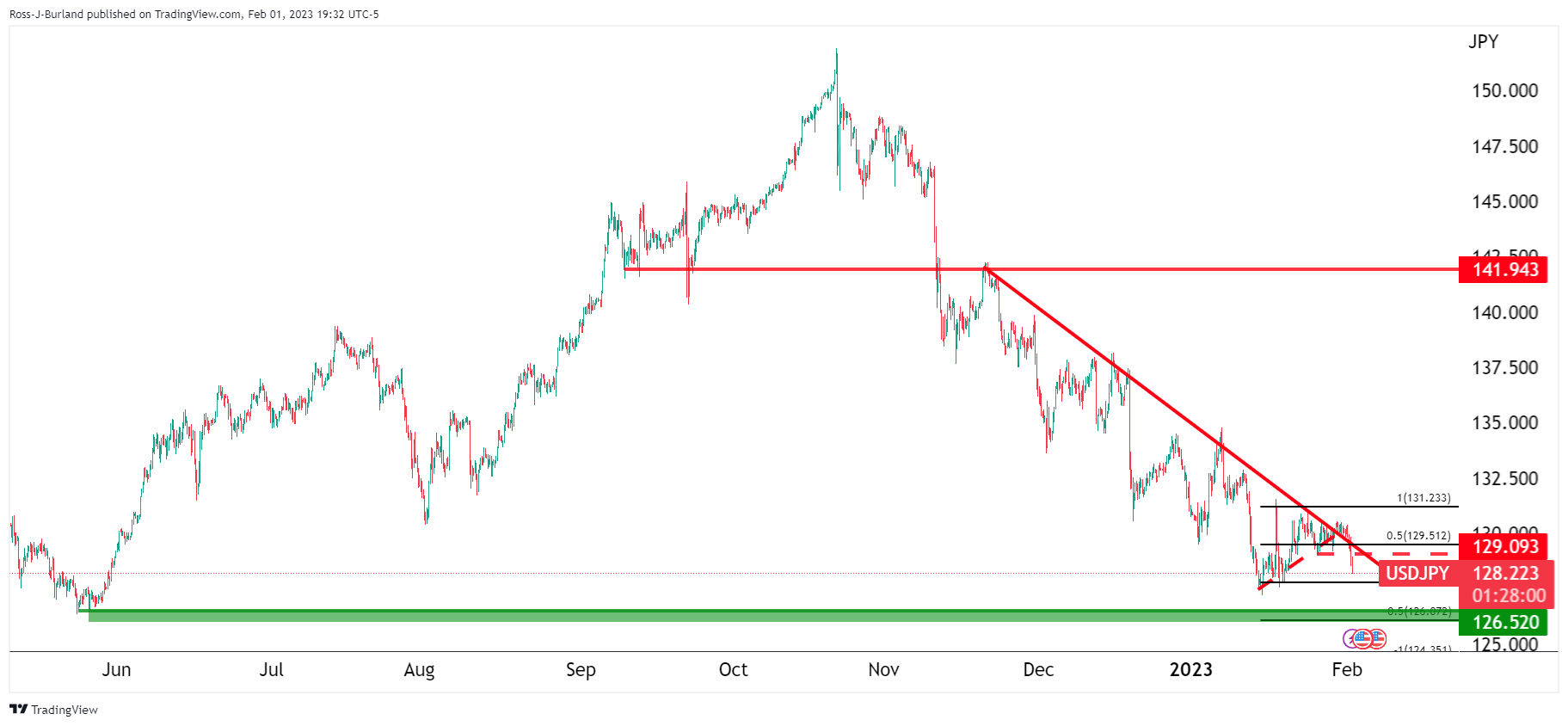
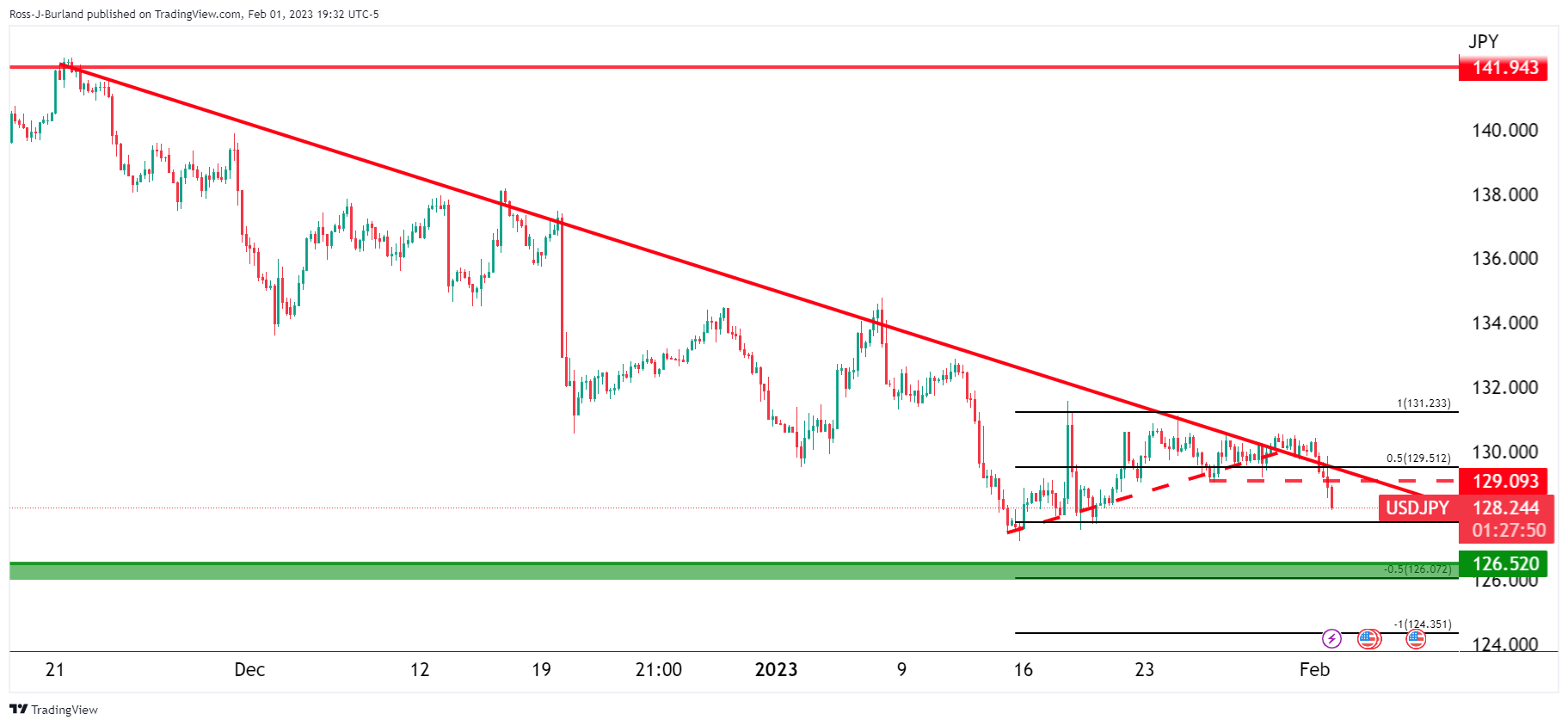
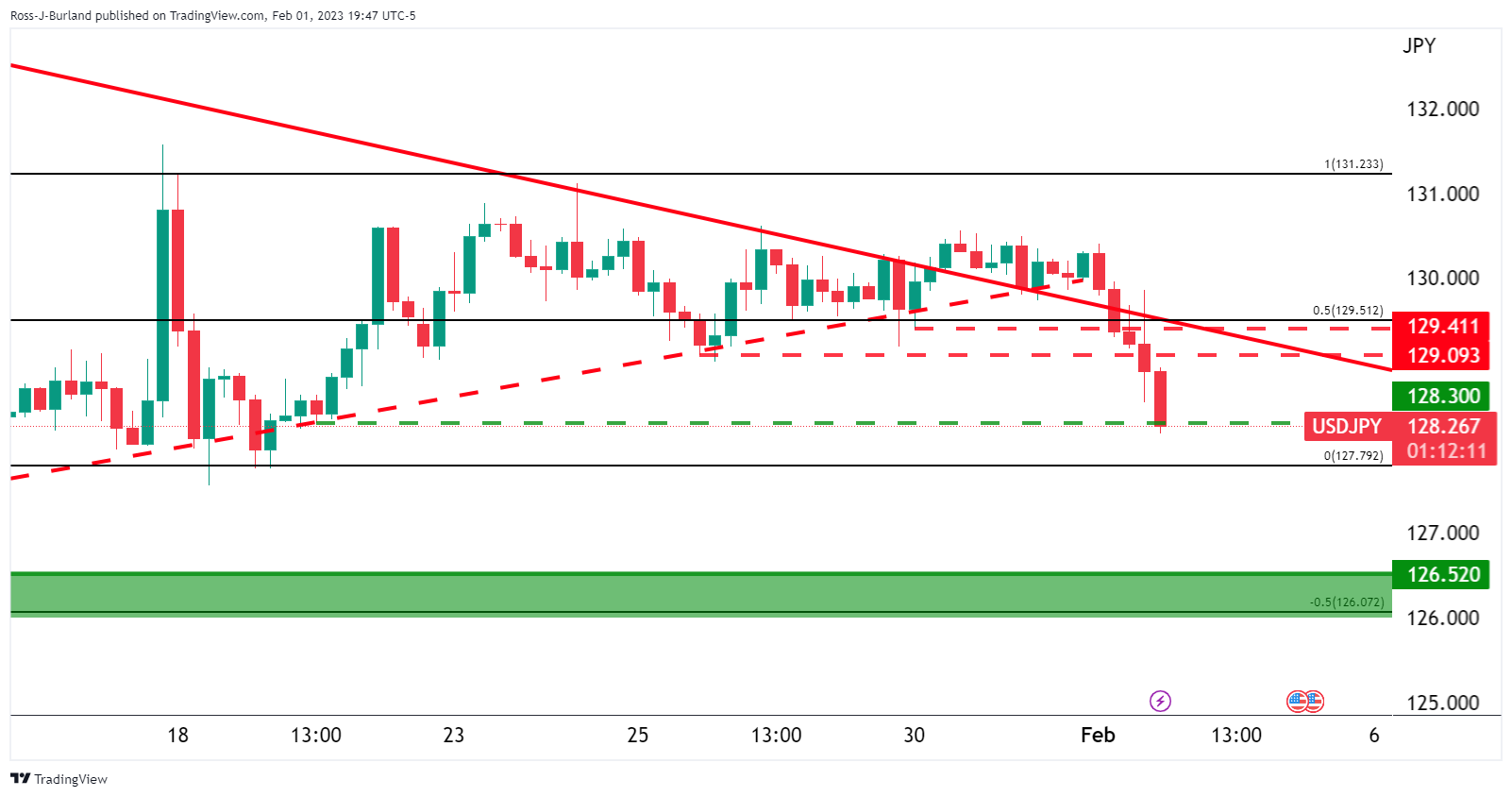
As illustrated on the 4-hour charts, the price is below the trendline resistance and the bias is lower following the breakout of the geometrical structure. The bears are in control but are meeting a support structure near 128.30. If there is a bullish correction and a retest of the 129 area in a 38.2% Fibonacci, then should the bears move in, the focus will be on the 127.50s.
- Silver price struggles to extend three-day uptrend near one-week high.
- Fortnight-old descending trend line challenges XAG/USD upside.
- 200-SMA puts a floor under the Silver price, bullish MACD signals favor metal buyers.
Silver price (XAG/USD) retreated from a one-week high as bulls seek fresh clues to defend the Federal Reserve (Fed) inspired rally. Even so, the bright metal prints mild gains around $24.10 during early Thursday in Asia.
It’s worth noting that the quote’s successful run-up beyond the 200-SMA joins the bullish MACD signals to keep the XAG/USD buyers hopeful.
However, the RSI (14) is approaching the overbought territory at a faster pace and suggests the pullback from a two-week-old resistance line, close to $24.20 at the latest.
Should the Silver price rises past $24.20, the odds of its rally toward the previous monthly high near $24.55 can’t be ruled out.
In a case where the XAG/USD remains firmer past $24.55, the January 2022 high of $24.70 may act as an intermediate halt during the north-run targeting an April 2022 peak of $26.22.
On the flip side, pullback moves may initially test the 23.6% Fibonacci retracement level of the pair’s moves between early December 2022 and January 03, 2023, close to $23.95.
Following that, the 200-SMA level of $23.75 will be important to watch as a clear break of the same could drag XAG/USD towards the 61.8% Fibonacci retracement level, also known as Golden Ratio, near $23.00.
Overall, the Silver price remains on the bull’s radar but further upside appears difficult.
Silver price: Four-hour chart
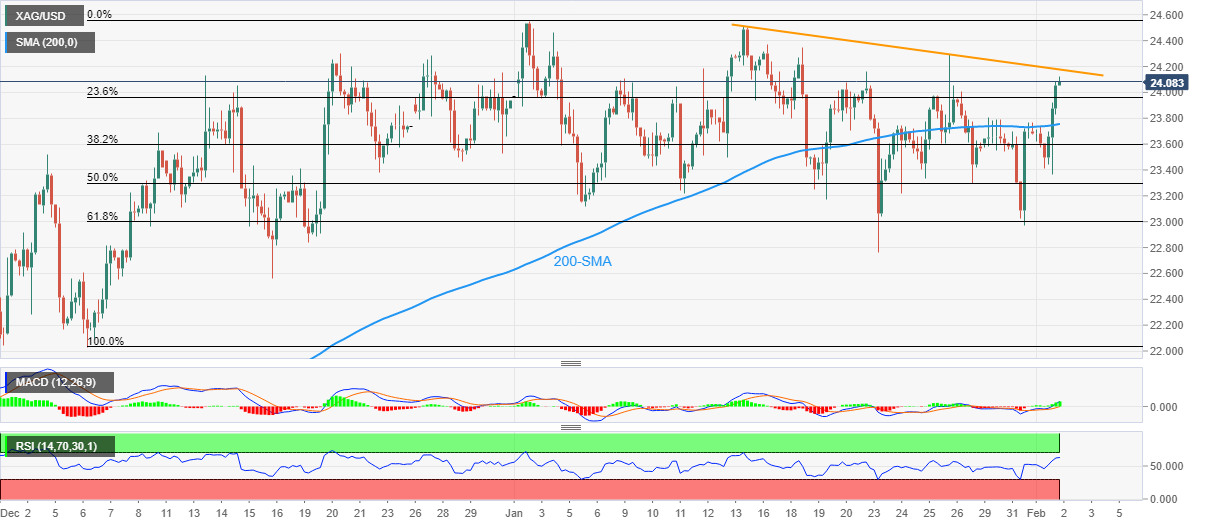
Trend: Pullback expected
- EUR/USD has shifted its business above 1.1000 amid less-hawkish monetary policy by the Fed.
- A 50 bps interest rate hike by the ECB will trim Fed-ECB policy divergence.
- The major currency pair has shifted above the 50% Fibo retracement.
The EUR/USD pair has sifted its auction profile above the psychological resistance of 1.1000 in the early Asian session. The major currency pair demonstrated a power-pack rally after surpassing Jan 26 high at 1.0930 as the Federal Reserve (Fed) trimmed the scale of the interest rate hike to 25 basis points (bps) and pushed borrowing rates to the 4.50-4.75% range. In December’s policy meeting, Fed chair Jerome Powell slashed the rate hike scale to 50 bps after four straight 75 bps rate hikes.
For further action, investors will keenly focus on the interest rate decision by the European Central Bank (ECB). As per the consensus, ECB President Christine Lagarde might hike interest rates by 50 bps to 2.50%, which will trim the Fed-ECB policy divergence further.
The US Dollar Index (DXY) has displayed a fragile pullback after printing a fresh nine-month low at 100.64 amid the risk appetite theme.
EUR/USD has scaled above the 50% or halfway Fibonacci retracement (placed from January 2021 high at 1.2350 to September 2022 low at 0.9536) at 1.0942 on a weekly scale, which indicates that bearish bias on a longer horizon has faded away. The 10-period Exponential Moving Average (EMA) at 1.0720 is scaling north firmly, which indicates that the upside trend carries immense strength.
Meanwhile, the Relative Strength Index (RSI) (14) has shifted into the bullish range of 60.00-80.00, which indicates that bullish momentum is highly active. It is worth noting that the momentum oscillator is not showing any sign of bearish divergence and an overbought situation.
To stretch the upside move, the shared currency pair needs to surpass a fresh nine-month high at 1.1033, which will drive the asset toward April 1 high at 1.1076 and March 18 high at 1.1119.
On the flip side, a decisive break below Jan 26 high at 1.0930 will drag the asset toward January 24 low at 1.0856. A breakdown of the latter will expose the asset for more downside toward January 31 low around 1.0800.
EUR/USD weekly chart
-638108952749767253.png)
- Gold price seesaws near multi-day high after rising the most in two weeks.
- XAU/USD rallies on Federal Reserve’s dovish hike, softer United States data.
- Downbeat US Dollar, Treasury bond yields add strength to the Gold price upside.
- Monetary policy decisions from other major central banks, US Nonfarm Payrolls will be crucial for clear directions.
Gold price (XAU/USD) makes rounds to the highest levels since late April 2022, close to $1,955 during the mid-Asian session on Thursday. In doing so, the yellow metal extends the US Federal Reserve (Fed) inspired run-up ahead of other major central bank announcements, as well as the US Nonfarm Payrolls (NFP).
Federal Reserve propels Gold price via dovish hike
Despite matching the market forecasts of 0.25% rate hike, the US Federal Reserve (Fed) managed to please the Gold buyers while mentioning in the Monetary Policy Statement that the inflation “has eased somewhat but remains elevated”.
Also bolstering the XAU/USD run-up was Fed Chair Powell’s press conference as the policy hawk surprised markets by saying, “We can declare that a deflationary process has begun.” The policymaker also accepts the need for rate cuts during late 2023 if inflation comes down much faster. Fed’s Powell also suggested that a couple more rate hikes are needed to reach it.
United States data also weigh on US Dollar and favor XAU/USD bulls
Other than the Federal Reserve outlook, the mostly downbeat United States statistics also weigh on the US Dollar and propel the XAU/USD price. That said, the US ISM Manufacturing PMI dropped to the lowest levels since June 2020 while marking 47.4 figure for January, versus 48.0 expected and 48.4 prior. Further, the ADP Employment Change also declined to a one-year low with 106K the latest figure compared to the 178K market forecasts and the upwardly revised previous figure of 253K. On the contrary, JOLTS Job Openings rose to 11.012M in December, crossing 10.25M consensus and 10.44M prior readings.
It’s worth noting that the US Dollar Index (DXY) licks its wounds near the lowest levels since April 2022, flirting with 101.00 by the press time, after falling the most in three weeks the previous day.
While taking clues from the Fed and the downbeat US data, Wall Street rallied and the US 10-year Treasury yields slumped the most in two weeks.
Central Banks, US jobs report eyed
Having witnessed the market reaction to the US Federal Reserve’s (Fed) dovish rate hike, Gold traders should pay attention to the monetary policy meetings of the European Central Bank (ECB) and the Bank of England (BoE) as they both could affect the US Dollar. That said, both the central banks, namely the ECB and the BoE, are likely to announce 0.50% rate lift. However, the comparative economic soundness in the bloc and more hawkish comments from the ECB policymakers in the last couple of days favor the Gold bulls.
Gold price technical analysis
Gold price remains firmer inside a three-week-old megaphone trend-widening chart pattern amid the bullish signals from the Moving Average Convergence and Divergence (MACD) indicator. However, the overbought levels of the Relative Strength Index (RSI) line, placed at 14, hints at the quote’s pullback before the next leg towards the north.
Even so, the 100-Exponential Moving Average (EMA) put a floor under the Gold price near $1,912, a break of which will highlight the stated megaphone’s lower line, close to the $1,900 threshold.
In a case where the quote drops below $1,900, a one-month-old horizontal area surrounding $1,866 will be crucial to watch.
Alternatively, Gold buyers may attack the trend-widening formation’s top line, around $1,962, during the further upside, a break of which will highlight the late March 2022 top near $1,966.
Should the XAU/USD price remains firmer past $1,966, the odds of witnessing a run-up toward April 2022 high near $1,999 can’t be ruled out.
Gold price: Four-hour chart
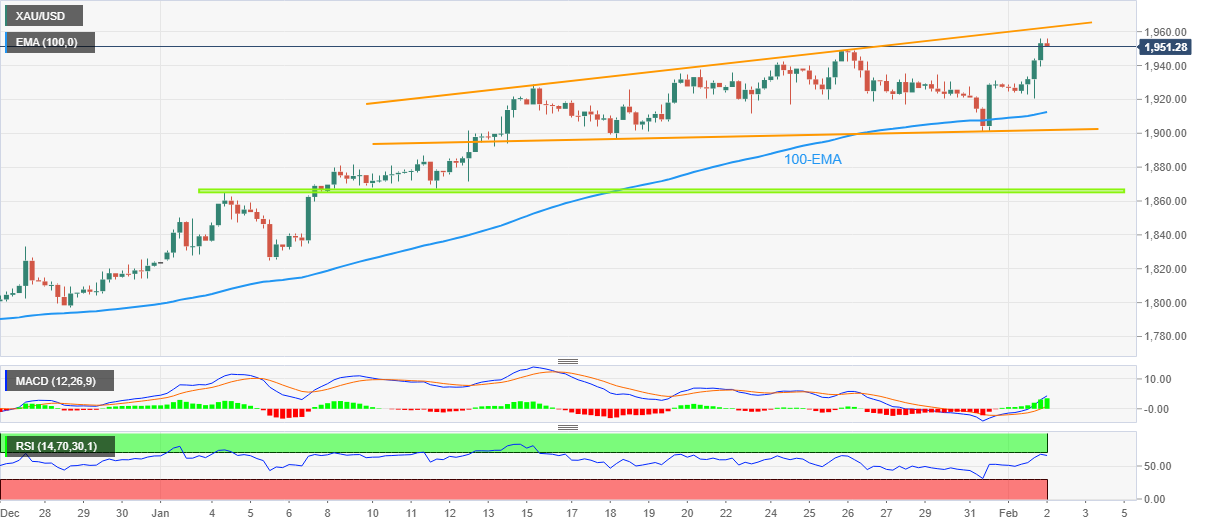
Trend: Limited upside expected
| Index | Change, points | Closed | Change, % |
|---|---|---|---|
| NIKKEI 225 | 19.77 | 27346.88 | 0.07 |
| Hang Seng | 229.85 | 22072.18 | 1.05 |
| KOSPI | 24.72 | 2449.8 | 1.02 |
| ASX 200 | 25 | 7501.7 | 0.33 |
| FTSE 100 | -10.59 | 7761.11 | -0.14 |
| DAX | 52.47 | 15180.74 | 0.35 |
| CAC 40 | -5.31 | 7077.11 | -0.07 |
| Dow Jones | 6.92 | 34092.96 | 0.02 |
| S&P 500 | 42.61 | 4119.21 | 1.05 |
| NASDAQ Composite | 231.77 | 11816.32 | 2 |
| Pare | Closed | Change, % |
|---|---|---|
| AUDUSD | 0.71364 | 1.16 |
| EURJPY | 141.673 | 0.31 |
| EURUSD | 1.09886 | 1.16 |
| GBPJPY | 159.501 | -0.39 |
| GBPUSD | 1.23715 | 0.44 |
| NZDUSD | 0.65042 | 0.99 |
| USDCAD | 1.32895 | -0.12 |
| USDCHF | 0.90875 | -0.73 |
| USDJPY | 128.929 | -0.85 |
- AUD/NZD pair has sensed selling pressure after failing to kiss the 1.1000 resistance.
- Six-week-old upward-sloping trendline placed from 1.0471 will continue to provide support to the Australian Dollar.
- The 20-period EMA has not been tested yet, which indicates that the upside bias is intact.
The AUD/NZD pair has sensed selling pressure after failing to capture the crucial resistance of 1.1000. The cross has dropped to near 1.0960 and is expected to remain sideways amid the absence of the potential trigger.
It seems that the weaker-than-anticipated New Zealand Employment (Q4) data didn’t result in much harm to the kiwi dollar. The Employment Change dropped to 0.2% from the expectations of 0.3% and the former release of 1.3%. While the Unemployment Rate has increased to 3.4% from the consensus and the prior release of 3.3%.
AUD/NZD witnessed a responsive selling move after testing a two-month high plotted at 1.0986. The struggle of the Australian Dollar in stretching its upside above a two-month high indicates the absence of a critical trigger. Six-week-old upward-sloping trendline placed from 1.0471 will continue to provide support to the Australian Dollar.
The 20-period Exponential Moving Average (EMA) at 1.0947 has not been tested yet, which indicates that the upside bias is intact.
Also, the Relative Strength Index (RSI) (14) has yet not surrendered oscillation in the bullish range of 60.00-80.00, which indicates that the upside momentum is still active.
For a fresh upside, the cross needs to surpass a two-month high at 1.0986 confidently, which will drive the asset toward November 11 high at 1.1045 followed by October 28 high at 1.1081.
Alternatively, a breakdown below Wednesday’s low at 1.0962 will drag the cross toward January 30 low around 1.0900. A slippage below the latter will extend the downside toward January 4 high at 1.0875.
AUD/NZD four-hour chart
-638108934166293681.png)
- GBP/USD bulls riding the whitewash of the Fed's dovish tilt and eye a break into the 1.24s.
- Resistance could be tough ahead and the bulls are not out of the woods yet.
GBP/USD rallied overnight on US Dollar weakness following the Federal Reserve event. The pair burst through 1.2350 resistance. GBP/USD now depends on the Bank of England and US jobs data on Friday. The following illustrates the technical structure of the price on the hourly time frame.
GBP/USD H1 chart

GBP/USD remains in a distribution area and bearish while below 1.2420 and 1.2450 longer term structure to the upside. For now, the bulls are rising the whitewash of the Federal Reserve dump on the US dollar, but only time will tell if the sentiment can stay dovish depending on data. This brings this week's Nonfarm Payrolls into view as the next catalyst. a break of structure to the downside, such as back below 1.2350 and then 1.2250 will likely see the bears =pounce for a run to 1.2080 in the forthcoming days ahead.
© 2000-2024. All rights reserved.
This site is managed by Teletrade D.J. LLC 2351 LLC 2022 (Euro House, Richmond Hill Road, Kingstown, VC0100, St. Vincent and the Grenadines).
The information on this website is for informational purposes only and does not constitute any investment advice.
The company does not serve or provide services to customers who are residents of the US, Canada, Iran, The Democratic People's Republic of Korea, Yemen and FATF blacklisted countries.
Making transactions on financial markets with marginal financial instruments opens up wide possibilities and allows investors who are willing to take risks to earn high profits, carrying a potentially high risk of losses at the same time. Therefore you should responsibly approach the issue of choosing the appropriate investment strategy, taking the available resources into account, before starting trading.
Use of the information: full or partial use of materials from this website must always be referenced to TeleTrade as the source of information. Use of the materials on the Internet must be accompanied by a hyperlink to teletrade.org. Automatic import of materials and information from this website is prohibited.
Please contact our PR department if you have any questions or need assistance at pr@teletrade.global.
